Sotera Wireless VISI-MOBILE ViSi Mobile Monitoring System User Manual RVD IFU
Sotera Wireless, Inc. ViSi Mobile Monitoring System RVD IFU
Contents
- 1. User manual
- 2. User Manual
User Manual
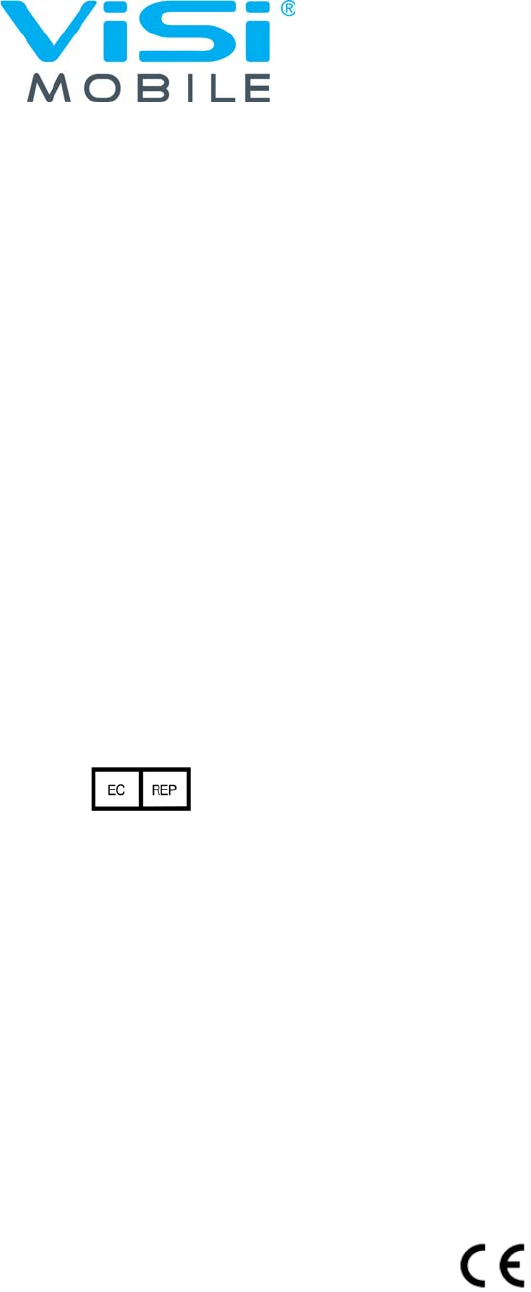
1
Remote Viewer
User manual
February 2014
Reference Number (USB): 95-10134
Reference Number (Hardcopy): 95-10101
Part Number: 6-000210-09.3
9444 Waples Street, Suite 280
San Diego, California 92121 USA
Phone: +1 (866) 232-6126 (U.S.)
+1 (858) 427-4620 (Intl)
Fax: +1 (858) 427-4639
Email: support@soterawireless.com
EMERGO EUROPE
Molenstraat 15, 2513BH
The Hague
The Netherlands
For additional information or assistance, please contact Sotera Wireless or an authorized Sotera Wireless
representative in your area.
0297
2
Copyright
This publication is provided for informational purposes only and Sotera Wireless, Inc. makes no
warranties, either express or implied, in this document. Information in this document is subject to change
without notice. The entire risk of the use or the results of the use of this document remains with the user.
Unless otherwise noted, the example companies, organizations, products, domain names, e-mail addresses,
logos, people, places, and events depicted herein are fictitious, and no association with any real company,
organization, product, domain name, e-mail address, logo, person, place, or event is intended or should be
inferred. Complying with all applicable copyright laws is the responsibility of the user. Without limiting
the rights under copyright, no part of this document may be reproduced, stored in or introduced into a
retrieval system, or transmitted in any form or by any means (electronic, mechanical, photocopying,
recording, or otherwise), or for any purpose, without the express written permission of Sotera Wireless,
Inc.
Sotera Wireless, Inc. may have patents, patent applications, trademarks, copyrights, or other intellectual
property rights covering subject matter in this document. Except as expressly provided in any written
license agreement from Sotera Wireless, Inc., the furnishing of this document does not give any license to
these patents, trademarks, copyrights, or other intellectual property.
Information for servicing the ViSi Mobile Monitoring System is contained in the ViSi Mobile Monitoring
System Technical Manual, Part Number: 6-000147. For additional information or assistance, please
contact Sotera Wireless or an authorized Sotera Wireless representative in your area.
© 2012 Sotera Wireless, Inc. All rights reserved.
ViSi MobileTM and Sotera WirelessTM are trademarks of Sotera Wireless, Inc.
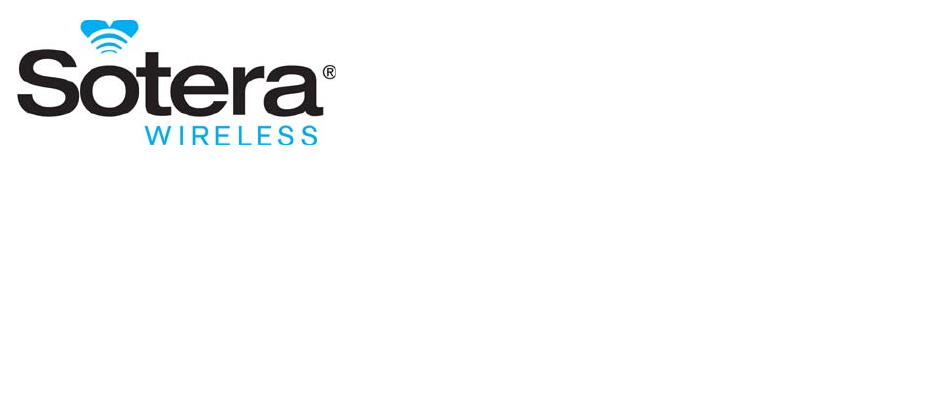
3
Contents
Chapter 1. Preface . . . . . . . . . . . . . . . . . . . . . . . . . . . . . . . . . . . . . . . . . . 9
Introduction. . . . . . . . . . . . . . . . . . . . . . . . . . . . . . . . . . . . . . . . . . . . . . . . . . . . . . . . 9
Intended Use. . . . . . . . . . . . . . . . . . . . . . . . . . . . . . . . . . . . . . . . . . . . . . . . . . . . . . 10
Contraindications. . . . . . . . . . . . . . . . . . . . . . . . . . . . . . . . . . . . . . . . . . . . . . . . . . . . . 10
Chapter 2. Warnings and Cautions . . . . . . . . . . . . . . . . . . . . . . . . . . . . 11
Introduction. . . . . . . . . . . . . . . . . . . . . . . . . . . . . . . . . . . . . . . . . . . . . . . . . . . . . . . 11
Warnings . . . . . . . . . . . . . . . . . . . . . . . . . . . . . . . . . . . . . . . . . . . . . . . . . . . . . . . . 12
Cautions . . . . . . . . . . . . . . . . . . . . . . . . . . . . . . . . . . . . . . . . . . . . . . . . . . . . . . . . . 20
Notes . . . . . . . . . . . . . . . . . . . . . . . . . . . . . . . . . . . . . . . . . . . . . . . . . . . . . . . . . . . . 24
Chapter 3. Overview . . . . . . . . . . . . . . . . . . . . . . . . . . . . . . . . . . . . . . . . 25
Areas on the ViSi Mobile Remote Viewer. . . . . . . . . . . . . . . . . . . . . . . . . . . . . . . 26
Care Unit Area . . . . . . . . . . . . . . . . . . . . . . . . . . . . . . . . . . . . . . . . . . . . . . . . . . . . . . . 26
Work Area . . . . . . . . . . . . . . . . . . . . . . . . . . . . . . . . . . . . . . . . . . . . . . . . . . . . . . . . . . . 27
Patient Home View and Other Patient Views. . . . . . . . . . . . . . . . . . . . . . . . . . . . . . . . . . . . . 28
Patient Tiles . . . . . . . . . . . . . . . . . . . . . . . . . . . . . . . . . . . . . . . . . . . . . . . . . . . . . . 29
Care Unit Patient Tiles. . . . . . . . . . . . . . . . . . . . . . . . . . . . . . . . . . . . . . . . . . . . . . . . . 29
Patient Tiles in the Assigned Location Zone . . . . . . . . . . . . . . . . . . . . . . . . . . . . . . . . . . . . . 29
Patient Tiles in the Unassigned Location Zone . . . . . . . . . . . . . . . . . . . . . . . . . . . . . . . . . . . 30
Work Area Patient Tiles. . . . . . . . . . . . . . . . . . . . . . . . . . . . . . . . . . . . . . . . . . . . . . . . 31
Patient Tile in the Patient Home View . . . . . . . . . . . . . . . . . . . . . . . . . . . . . . . . . . . . . . . . . . 31
Patient Tiles in Other Patient Views. . . . . . . . . . . . . . . . . . . . . . . . . . . . . . . . . . . . . . . . . . . . 32
Navigating to a Patient Home View. . . . . . . . . . . . . . . . . . . . . . . . . . . . . . . . . . . . 33
To navigate to a Patient Home View from the Care Unit Area. . . . . . . . . . . . . . . . . . . . . . . . 33
To navigate to the Patient Home View from another patient view . . . . . . . . . . . . . . . . . . . . 34
System Help . . . . . . . . . . . . . . . . . . . . . . . . . . . . . . . . . . . . . . . . . . . . . . . . . . . . . . 35
To access the system help. . . . . . . . . . . . . . . . . . . . . . . . . . . . . . . . . . . . . . . . . . . . . . . . . . . 35
Shutdown the Application . . . . . . . . . . . . . . . . . . . . . . . . . . . . . . . . . . . . . . . . . . . 36
To shutdown the application . . . . . . . . . . . . . . . . . . . . . . . . . . . . . . . . . . . . . . . . . . . . . . . . . 36
Chapter 4. Wireless Monitoring. . . . . . . . . . . . . . . . . . . . . . . . . . . . . . . 37
Wireless Monitoring with ViSi Mobile Remote Viewer . . . . . . . . . . . . . . . . . . . . 37
4
Communication with ViSi Mobile Remote Viewer . . . . . . . . . . . . . . . . . . . . . . . . 38
Monitoring a patient outside of network range . . . . . . . . . . . . . . . . . . . . . . . . . . 39
Chapter 5. Setting Up Monitoring . . . . . . . . . . . . . . . . . . . . . . . . . . . . . 41
Admit New Patient. . . . . . . . . . . . . . . . . . . . . . . . . . . . . . . . . . . . . . . . . . . . . . . . . 41
To admit a new patient. . . . . . . . . . . . . . . . . . . . . . . . . . . . . . . . . . . . . . . . . . . . . . . . . . . . . . 41
Start Monitoring Before Admit . . . . . . . . . . . . . . . . . . . . . . . . . . . . . . . . . . . . . . . 43
To start monitoring before admit . . . . . . . . . . . . . . . . . . . . . . . . . . . . . . . . . . . . . . . . . . . . . . 43
Editing Patient Demographics . . . . . . . . . . . . . . . . . . . . . . . . . . . . . . . . . . . . . . . 45
To edit patient information . . . . . . . . . . . . . . . . . . . . . . . . . . . . . . . . . . . . . . . . . . . . . . . . . . . 45
Designating Patient Locations . . . . . . . . . . . . . . . . . . . . . . . . . . . . . . . . . . . . . . . 47
Dragging and Dropping to a New Location . . . . . . . . . . . . . . . . . . . . . . . . . . . . . . . . 47
To drag and drop a Patient Tile . . . . . . . . . . . . . . . . . . . . . . . . . . . . . . . . . . . . . . . . . . . . . . . 47
Entering Location Information . . . . . . . . . . . . . . . . . . . . . . . . . . . . . . . . . . . . . . . . . . 48
To enter location information . . . . . . . . . . . . . . . . . . . . . . . . . . . . . . . . . . . . . . . . . . . . . . . . . 48
ADT Interface . . . . . . . . . . . . . . . . . . . . . . . . . . . . . . . . . . . . . . . . . . . . . . . . . . . . . 50
To Select Patients from ADT . . . . . . . . . . . . . . . . . . . . . . . . . . . . . . . . . . . . . . . . . . . . . . . . . 50
Chapter 6. Patient Monitoring . . . . . . . . . . . . . . . . . . . . . . . . . . . . . . . . 53
Viewing Vital Sign Measurements . . . . . . . . . . . . . . . . . . . . . . . . . . . . . . . . . . . . 53
Vital Sign Measurements Displayed in the Care Unit Area . . . . . . . . . . . . . . . . . . . . . . . . . . 53
To view one patient’s measurements in a patient view . . . . . . . . . . . . . . . . . . . . . . . . . . . . . 55
Viewing Graphical Trends . . . . . . . . . . . . . . . . . . . . . . . . . . . . . . . . . . . . . . . . . . . 56
Viewing all Vital Sign Trends . . . . . . . . . . . . . . . . . . . . . . . . . . . . . . . . . . . . . . . . . . . 57
To view vital sign trends in graphical format . . . . . . . . . . . . . . . . . . . . . . . . . . . . . . . . . . . . . 57
Viewing a Single Vital Sign Trend . . . . . . . . . . . . . . . . . . . . . . . . . . . . . . . . . . . . . . . 58
To view a single vital sign trend in graphical format. . . . . . . . . . . . . . . . . . . . . . . . . . . . . . . . 58
Graphical Trend Features . . . . . . . . . . . . . . . . . . . . . . . . . . . . . . . . . . . . . . . . . . . . . . 59
Time scale Displays . . . . . . . . . . . . . . . . . . . . . . . . . . . . . . . . . . . . . . . . . . . . . . . . . . . . . . . . 59
Trend Line . . . . . . . . . . . . . . . . . . . . . . . . . . . . . . . . . . . . . . . . . . . . . . . . . . . . . . . . . . . . . . . 59
Time Cursor . . . . . . . . . . . . . . . . . . . . . . . . . . . . . . . . . . . . . . . . . . . . . . . . . . . . . . . . . . . . . . 59
Patient Alarms . . . . . . . . . . . . . . . . . . . . . . . . . . . . . . . . . . . . . . . . . . . . . . . . . . . . . . . . . . . . 60
Alarm/Events Status Bar . . . . . . . . . . . . . . . . . . . . . . . . . . . . . . . . . . . . . . . . . . . . . . . . . . . . 60
Viewing List Trends . . . . . . . . . . . . . . . . . . . . . . . . . . . . . . . . . . . . . . . . . . . . . . . . 62
To view vital sign trends in tabular format . . . . . . . . . . . . . . . . . . . . . . . . . . . . . . . . . . . . . . . 63
List Trend Features . . . . . . . . . . . . . . . . . . . . . . . . . . . . . . . . . . . . . . . . . . . . . . . . . . . 64
Trend Displays . . . . . . . . . . . . . . . . . . . . . . . . . . . . . . . . . . . . . . . . . . . . . . . . . . . . . . . . . . . . 64
Navigation/Scrolling . . . . . . . . . . . . . . . . . . . . . . . . . . . . . . . . . . . . . . . . . . . . . . . . . . . . . . . . 64
Viewing Current Waveforms . . . . . . . . . . . . . . . . . . . . . . . . . . . . . . . . . . . . . . . . . 65
Viewing ECG Waveforms . . . . . . . . . . . . . . . . . . . . . . . . . . . . . . . . . . . . . . . . . . . . . . 65
To view a patient’s current ECG waveform . . . . . . . . . . . . . . . . . . . . . . . . . . . . . . . . . . . . . . 65
Input Overload/Dynamic Range . . . . . . . . . . . . . . . . . . . . . . . . . . . . . . . . . . . . . . . . . . . . . . . 66
Patient Reports. . . . . . . . . . . . . . . . . . . . . . . . . . . . . . . . . . . . . . . . . . . . . . . . . . . . 67
List Trends . . . . . . . . . . . . . . . . . . . . . . . . . . . . . . . . . . . . . . . . . . . . . . . . . . . . . . . . . . 67
To Print the List Trends Report . . . . . . . . . . . . . . . . . . . . . . . . . . . . . . . . . . . . . . . . . . . . . . . 67
5
Waveforms . . . . . . . . . . . . . . . . . . . . . . . . . . . . . . . . . . . . . . . . . . . . . . . . . . . . . . . . . . 68
To Print the Waveform Report . . . . . . . . . . . . . . . . . . . . . . . . . . . . . . . . . . . . . . . . . . . . . . . . 68
Chapter 7. Alarms . . . . . . . . . . . . . . . . . . . . . . . . . . . . . . . . . . . . . . . . . . 69
Introduction. . . . . . . . . . . . . . . . . . . . . . . . . . . . . . . . . . . . . . . . . . . . . . . . . . . . . . . 69
System Alarm Management . . . . . . . . . . . . . . . . . . . . . . . . . . . . . . . . . . . . . . . . . . . . 69
General Alarm Management Rules . . . . . . . . . . . . . . . . . . . . . . . . . . . . . . . . . . . . . . . . . . . . 69
In Network Rules . . . . . . . . . . . . . . . . . . . . . . . . . . . . . . . . . . . . . . . . . . . . . . . . . . . . . . . . . . 70
Physiological Alarms (Alarms) / Technical Alarms (Alerts) Summary . . . . . . . 71
Responding to Alarms/Alerts . . . . . . . . . . . . . . . . . . . . . . . . . . . . . . . . . . . . . . . . . . . 71
Managing Alarm/Alert Annunciations . . . . . . . . . . . . . . . . . . . . . . . . . . . . . . . . . . . . 72
Responding to Physiological Alarms (Alarms) . . . . . . . . . . . . . . . . . . . . . . . . . . 73
To Silence/Acknowledge Life Threatening Severity Alarms . . . . . . . . . . . . . . . . . . 73
To Silence High Severity Alarms . . . . . . . . . . . . . . . . . . . . . . . . . . . . . . . . . . . . . . . . 75
Responding to Equipment Alarms (Alerts) . . . . . . . . . . . . . . . . . . . . . . . . . . . . . 77
To Silence/Acknowledge Alerts (All Severities) . . . . . . . . . . . . . . . . . . . . . . . . . . . . 77
Resume / Turn On Alarm Annunciation . . . . . . . . . . . . . . . . . . . . . . . . . . . . . . . . 79
To Resume Alarm Annunciation . . . . . . . . . . . . . . . . . . . . . . . . . . . . . . . . . . . . . . . . 79
To Turn On Alarm Annunciation . . . . . . . . . . . . . . . . . . . . . . . . . . . . . . . . . . . . . . . . 80
Manage Alarm Limits . . . . . . . . . . . . . . . . . . . . . . . . . . . . . . . . . . . . . . . . . . . . . . . 81
To change alarm limits individually . . . . . . . . . . . . . . . . . . . . . . . . . . . . . . . . . . . . . . 81
To reset alarm limits to default values. . . . . . . . . . . . . . . . . . . . . . . . . . . . . . . . . . . . 83
ViSi Mobile Remote Viewer Audio Test . . . . . . . . . . . . . . . . . . . . . . . . . . . . . . . . 84
To test the ViSi Mobile Remote Viewer Speaker. . . . . . . . . . . . . . . . . . . . . . . . . . . . 84
Chapter 8. Pause / Stop Monitoring . . . . . . . . . . . . . . . . . . . . . . . . . . . 85
Pause Monitoring . . . . . . . . . . . . . . . . . . . . . . . . . . . . . . . . . . . . . . . . . . . . . . . . . . 85
Stop Monitoring . . . . . . . . . . . . . . . . . . . . . . . . . . . . . . . . . . . . . . . . . . . . . . . . . . . 87
Removing Patients from the Care Unit. . . . . . . . . . . . . . . . . . . . . . . . . . . . . . . . . 88
To remove a patient from the Care Unit View . . . . . . . . . . . . . . . . . . . . . . . . . . . . . . 88
Chapter 9. Care Unit Views . . . . . . . . . . . . . . . . . . . . . . . . . . . . . . . . . . 91
Care Unit Devices. . . . . . . . . . . . . . . . . . . . . . . . . . . . . . . . . . . . . . . . . . . . . . . . . . 91
To view the ViSi Mobile Monitors currently in use . . . . . . . . . . . . . . . . . . . . . . . . . . . . . . . . . 91
Chapter 10. Troubleshooting. . . . . . . . . . . . . . . . . . . . . . . . . . . . . . . . . 93
Introduction. . . . . . . . . . . . . . . . . . . . . . . . . . . . . . . . . . . . . . . . . . . . . . . . . . . . . . . 93
Customer Support . . . . . . . . . . . . . . . . . . . . . . . . . . . . . . . . . . . . . . . . . . . . . . . . . . . . 93
ViSi Mobile Monitor . . . . . . . . . . . . . . . . . . . . . . . . . . . . . . . . . . . . . . . . . . . . . . . . 94
Screen Access . . . . . . . . . . . . . . . . . . . . . . . . . . . . . . . . . . . . . . . . . . . . . . . . . . . . . . . 94
ViSi Mobile Chest Sensor Cable . . . . . . . . . . . . . . . . . . . . . . . . . . . . . . . . . . . . . . 95
ViSi Mobile Thumb Sensor . . . . . . . . . . . . . . . . . . . . . . . . . . . . . . . . . . . . . . . . . . 98
6
ViSi Mobile Cuff Module. . . . . . . . . . . . . . . . . . . . . . . . . . . . . . . . . . . . . . . . . . . . . 99
ViSi Mobile Battery Charger . . . . . . . . . . . . . . . . . . . . . . . . . . . . . . . . . . . . . . . . 101
General Troubleshooting. . . . . . . . . . . . . . . . . . . . . . . . . . . . . . . . . . . . . . . . . . . 102
Connectivity Lost. . . . . . . . . . . . . . . . . . . . . . . . . . . . . . . . . . . . . . . . . . . . . . . . . . . . 102
Alarms and Alerts . . . . . . . . . . . . . . . . . . . . . . . . . . . . . . . . . . . . . . . . . . . . . . . . . . . 102
ViSi Mobile Remote Viewer . . . . . . . . . . . . . . . . . . . . . . . . . . . . . . . . . . . . . . . . . 104
Setting Alarm Limits . . . . . . . . . . . . . . . . . . . . . . . . . . . . . . . . . . . . . . . . . . . . . . . . . 104
Chapter 11. Specifications. . . . . . . . . . . . . . . . . . . . . . . . . . . . . . . . . . 105
Introduction. . . . . . . . . . . . . . . . . . . . . . . . . . . . . . . . . . . . . . . . . . . . . . . . . . . . . . 105
Vital Sign Measurements. . . . . . . . . . . . . . . . . . . . . . . . . . . . . . . . . . . . . . . . . . . 106
Heart Rate . . . . . . . . . . . . . . . . . . . . . . . . . . . . . . . . . . . . . . . . . . . . . . . . . . . . . . . . . . 106
Respiration . . . . . . . . . . . . . . . . . . . . . . . . . . . . . . . . . . . . . . . . . . . . . . . . . . . . . . . . . 109
Pulse Oximetry (SpO2, Functional Oxygen Saturation). . . . . . . . . . . . . . . . . . . . . 110
Non-Invasive Blood Pressure (NIBP) . . . . . . . . . . . . . . . . . . . . . . . . . . . . . . . . . . . . 112
Continuous Non-Invasive Blood Pressure (cNIBP) . . . . . . . . . . . . . . . . . . . . . . . . 114
Skin Temperature. . . . . . . . . . . . . . . . . . . . . . . . . . . . . . . . . . . . . . . . . . . . . . . . . . . . 117
Physical Components . . . . . . . . . . . . . . . . . . . . . . . . . . . . . . . . . . . . . . . . . . . . . 118
ViSi Mobile Monitor . . . . . . . . . . . . . . . . . . . . . . . . . . . . . . . . . . . . . . . . . . . . . . . . . . 118
Wireless Communications / Radio . . . . . . . . . . . . . . . . . . . . . . . . . . . . . . . . . . . . . . . . . . . . 118
Mode Plugs . . . . . . . . . . . . . . . . . . . . . . . . . . . . . . . . . . . . . . . . . . . . . . . . . . . . . . . . . . . . . 119
ViSi Mobile Chest Sensor Cable. . . . . . . . . . . . . . . . . . . . . . . . . . . . . . . . . . . . . . . . 120
ViSi Mobile Cuff Module . . . . . . . . . . . . . . . . . . . . . . . . . . . . . . . . . . . . . . . . . . . . . . 121
ViSi Mobile Thumb Sensor . . . . . . . . . . . . . . . . . . . . . . . . . . . . . . . . . . . . . . . . . . . . 122
ViSi Mobile Charger - 8 Bay . . . . . . . . . . . . . . . . . . . . . . . . . . . . . . . . . . . . . . . . . . . 123
ViSi Mobile Charger - 2 Bay . . . . . . . . . . . . . . . . . . . . . . . . . . . . . . . . . . . . . . . . . . . 123
ViSi Mobile Appliance . . . . . . . . . . . . . . . . . . . . . . . . . . . . . . . . . . . . . . . . . . . . . . . . 124
ViSi Mobile Remote Viewer . . . . . . . . . . . . . . . . . . . . . . . . . . . . . . . . . . . . . . . . . . . . 125
Customer Network . . . . . . . . . . . . . . . . . . . . . . . . . . . . . . . . . . . . . . . . . . . . . . . . . . . 126
Alarms / Alerts Annunciation . . . . . . . . . . . . . . . . . . . . . . . . . . . . . . . . . . . . . . . 127
Physiological Alarms (Alarms) . . . . . . . . . . . . . . . . . . . . . . . . . . . . . . . . . . . . . . . . . 127
Visual Display. . . . . . . . . . . . . . . . . . . . . . . . . . . . . . . . . . . . . . . . . . . . . . . . . . . . . . . . . . . . 127
Audio Tones. . . . . . . . . . . . . . . . . . . . . . . . . . . . . . . . . . . . . . . . . . . . . . . . . . . . . . . . . . . . . 127
Equipment Alarms (Alerts) . . . . . . . . . . . . . . . . . . . . . . . . . . . . . . . . . . . . . . . . . . . . 130
Visual Display. . . . . . . . . . . . . . . . . . . . . . . . . . . . . . . . . . . . . . . . . . . . . . . . . . . . . . . . . . . . 130
Audio Tones. . . . . . . . . . . . . . . . . . . . . . . . . . . . . . . . . . . . . . . . . . . . . . . . . . . . . . . . . . . . . 130
Environmental Conditions. . . . . . . . . . . . . . . . . . . . . . . . . . . . . . . . . . . . . . . . . . 131
Compliances . . . . . . . . . . . . . . . . . . . . . . . . . . . . . . . . . . . . . . . . . . . . . . . . . . . . . 133
Federal Communications Commission (FCC). . . . . . . . . . . . . . . . . . . . . . . . . . . . . 133
Electromagnetic Compatibility (EMC) Specifications. . . . . . . . . . . . . . . . . . . . . . . 134
Accessories Compliant with EMC Standards. . . . . . . . . . . . . . . . . . . . . . . . . . . . . . . . . . . . 134
Electromagnetic Emissions . . . . . . . . . . . . . . . . . . . . . . . . . . . . . . . . . . . . . . . . . . . 135
Electromagnetic Immunity . . . . . . . . . . . . . . . . . . . . . . . . . . . . . . . . . . . . . . . . . . . . 136
Recommended Separation Distance . . . . . . . . . . . . . . . . . . . . . . . . . . . . . . . . . . . . 137
From Portable and Mobile RF Communication Equipment . . . . . . . . . . . . . . . . . . . . . . . . . 138
Electrosurgery Interference/Defibrillation/Electrostatic Discharge . . . . . . . . . . . . . . . . . . . . 138
7
Fast Transients/Bursts . . . . . . . . . . . . . . . . . . . . . . . . . . . . . . . . . . . . . . . . . . . . . . . . . . . . . 138
Standards . . . . . . . . . . . . . . . . . . . . . . . . . . . . . . . . . . . . . . . . . . . . . . . . . . . . . . . . . . 139
Wireless Network Risk Mitigation. . . . . . . . . . . . . . . . . . . . . . . . . . . . . . . . . . . . 140
Risk Analysis Summary . . . . . . . . . . . . . . . . . . . . . . . . . . . . . . . . . . . . . . . . . . . . . . 140
Residual Risks . . . . . . . . . . . . . . . . . . . . . . . . . . . . . . . . . . . . . . . . . . . . . . . . . . . . . . 140
Sotera Responsibilities. . . . . . . . . . . . . . . . . . . . . . . . . . . . . . . . . . . . . . . . . . . . . . . . . . . . . 140
Responsible Organization Responsibilities . . . . . . . . . . . . . . . . . . . . . . . . . . . . . . . . . . . . . 140
Appendix A. Alarm Summary . . . . . . . . . . . . . . . . . . . . . . . . . . . . . . . 143
Patient Alarms . . . . . . . . . . . . . . . . . . . . . . . . . . . . . . . . . . . . . . . . . . . . . . . . . . . 143
Life Threatening Alarms . . . . . . . . . . . . . . . . . . . . . . . . . . . . . . . . . . . . . . . . . . . . . . 143
High Alarms . . . . . . . . . . . . . . . . . . . . . . . . . . . . . . . . . . . . . . . . . . . . . . . . . . . . . . 144
Equipment Alerts . . . . . . . . . . . . . . . . . . . . . . . . . . . . . . . . . . . . . . . . . . . . . . . . . 145
ViSi Mobile Monitor Alerts. . . . . . . . . . . . . . . . . . . . . . . . . . . . . . . . . . . . . . . . . . . . . 145
ViSi Mobile Chest Sensor Cable and ECG Alerts . . . . . . . . . . . . . . . . . . . . . . . . . 146
ViSi Mobile Thumb Sensor and SpO2 Alerts . . . . . . . . . . . . . . . . . . . . . . . . . . . . 147
ViSi Mobile Cuff Module and NIBP Alerts . . . . . . . . . . . . . . . . . . . . . . . . . . . . . . . 147
Miscellaneous Alerts . . . . . . . . . . . . . . . . . . . . . . . . . . . . . . . . . . . . . . . . . . . . . . . . . 149
ViSi Mobile Charging Alerts . . . . . . . . . . . . . . . . . . . . . . . . . . . . . . . . . . . . . . . . . . . 149
ViSi Mobile Monitor Status Icons . . . . . . . . . . . . . . . . . . . . . . . . . . . . . . . . . . . . 150
Battery Charge . . . . . . . . . . . . . . . . . . . . . . . . . . . . . . . . . . . . . . . . . . . . . . . . . . . . . . 150
Wireless Radio Signal Strength . . . . . . . . . . . . . . . . . . . . . . . . . . . . . . . . . . . . . . . . 150
Appendix B. Symbols. . . . . . . . . . . . . . . . . . . . . . . . . . . . . . . . . . . . . . 151
Alarms / Alerts . . . . . . . . . . . . . . . . . . . . . . . . . . . . . . . . . . . . . . . . . . . . . . . . . . . 151
Alarm / Alert States . . . . . . . . . . . . . . . . . . . . . . . . . . . . . . . . . . . . . . . . . . . . . . . . . . 151
Alarm Management . . . . . . . . . . . . . . . . . . . . . . . . . . . . . . . . . . . . . . . . . . . . . . . . . . 152
Battery States . . . . . . . . . . . . . . . . . . . . . . . . . . . . . . . . . . . . . . . . . . . . . . . . . . . . 153
General Icons . . . . . . . . . . . . . . . . . . . . . . . . . . . . . . . . . . . . . . . . . . . . . . . . . . . . 154
Out of Range Vital Signs . . . . . . . . . . . . . . . . . . . . . . . . . . . . . . . . . . . . . . . . . . . . . . 154
Navigation. . . . . . . . . . . . . . . . . . . . . . . . . . . . . . . . . . . . . . . . . . . . . . . . . . . . . . . . . . 154
Vital Signs Menu . . . . . . . . . . . . . . . . . . . . . . . . . . . . . . . . . . . . . . . . . . . . . . . . . . . . 154
Clinical Menu . . . . . . . . . . . . . . . . . . . . . . . . . . . . . . . . . . . . . . . . . . . . . . . . . . . . . . . 155
Other . . . . . . . . . . . . . . . . . . . . . . . . . . . . . . . . . . . . . . . . . . . . . . . . . . . . . . . . . . . . . . 156
Patient’s Postures . . . . . . . . . . . . . . . . . . . . . . . . . . . . . . . . . . . . . . . . . . . . . . . . 157
Unknown Posture. . . . . . . . . . . . . . . . . . . . . . . . . . . . . . . . . . . . . . . . . . . . . . . . . 157
Postures . . . . . . . . . . . . . . . . . . . . . . . . . . . . . . . . . . . . . . . . . . . . . . . . . . . . . . . . 157
Labelling . . . . . . . . . . . . . . . . . . . . . . . . . . . . . . . . . . . . . . . . . . . . . . . . . . . . . . . . 158
Appendix C. Warranty . . . . . . . . . . . . . . . . . . . . . . . . . . . . . . . . . . . . . 161
Warranty . . . . . . . . . . . . . . . . . . . . . . . . . . . . . . . . . . . . . . . . . . . . . . . . . . . . . . . . 161
Third Party Branded Products . . . . . . . . . . . . . . . . . . . . . . . . . . . . . . . . . . . . . . . . . 161
Warranty Exclusions . . . . . . . . . . . . . . . . . . . . . . . . . . . . . . . . . . . . . . . . . . . . . . . . . 161
8
Sotera Wireless Responsibility. . . . . . . . . . . . . . . . . . . . . . . . . . . . . . . . . . . . . . 162
Contact Sotera Wireless . . . . . . . . . . . . . . . . . . . . . . . . . . . . . . . . . . . . . . . . . . . 162
Index. . . . . . . . . . . . . . . . . . . . . . . . . . . . . . . . . . . . . . . . . . . . . . . . . . . . 163

9
1. Preface
1.1 Introduction
The suite of ViSi Mobile Monitoring System™ user manuals are intended to provide information for the
proper operation of the Sotera Wireless ViSi Mobile Monitoring System™. The suite of manuals
comprises of:
• ViSi Mobile Monitoring System User Manual
• ViSi Mobile Remote Viewer User Manual
• ViSi Mobile myRemote Viewer User Manual1
A formal knowledge of patient monitoring and an understanding of the features and functions of the
system are prerequisites for its proper use.
These manuals are written for trained clinicians. Although the manuals describes guidelines for optimizing
monitoring techniques, clinicians using this system should be trained to take and interpret patient vital
signs. Automatic vital signs monitoring is an adjunct to clinical assessment; good clinical judgment should
always prevail.
1. The ViSi Mobile myRemote Viewer User Manual is a system that comprises the functionalies of the ViSi
Mobile Appliance and the ViSi Mobile Remote Viewer. The ViSi Mobile myRemote Viewer User Man-
ual only contains instructions specific to the myRemote Viewer functionality. Refer to the ViSi Mobile
Remote Viewer Manual for wireless technology and system specifications, operating characteristing,
quality of service, wireless security measures, information regarding wireless coexistence issues and mit-
igations, EMC standards compliance and warnings about possible effects from RF sources in the vicinity
of the device.
Do not operate the ViSi Mobile Monitoring System before reading these
instructions.
Intended Use
10
1.2 Intended Use
The ViSi Mobile Monitoring System is intended for use by clinicians and medically qualified personnel for
single or multi-parameter vital signs monitoring of adult patients (18 years or older). It is indicated for
ECG (3 or 5 lead-wirelead-wire), respiration rate, heart rate, non-invasive blood pressure (NIBP),
continuous non-invasive blood press (cNIBP), non-invasive monitoring of functional oxygen saturation of
arterial hemoglobin (SpO2), pulse rate, and skin temperature in hospital-based facilities; including general
medical-surgical floors, intermediate care floors, and emergency departments.
Continuous non-invasive blood pressure (cNIBP) testing has not be conducted on ambulatory patients.
The ViSi Mobile Monitoring System may be used as standalone devices or networked to a ViSi Mobile
Remote Viewer through wireless 802.11 communication.
1.2.1 Contraindications
• Impedance pneumography for the determination of Respiration Rate (RESP) is not recommended
for use in the presence of mechanically induced high frequency ventilation.
• The ViSi Mobile Monitoring System has not been tested for use on neonatal or pediatric patients
under the age of 18 years.
• Do not use the same ViSi Mobile Monitor System to measure the NIBP of one patient while it is
connected simultaneously to another patient.
• Do not use the ViSi Mobile Monitor on a patient with an Intra-Aortic Balloon Pump (IABP), or a
Left Ventricular Assist Device (LVAD). The Monitor requires an unperturbed arterial pulse
waveform for non-invasive blood pressure calculations. IABP and LVAD perturb the arterial pulse
waveform.
• Do not use the ViSi Mobile Monitor System on a patient on cardio-pulmonary bypass.
• Do not use the ViSi Mobile Cuff Module on a patient’s arm where the use of a blood pressure cuff
is contraindicated.
• Do not use the ViSi Mobile Monitoring System in an MRI Suite.
• The effectiveness of the ViSi Mobile Monitoring System’s blood pressure monitoring has not been
established in the presence of any dysrhythmias.
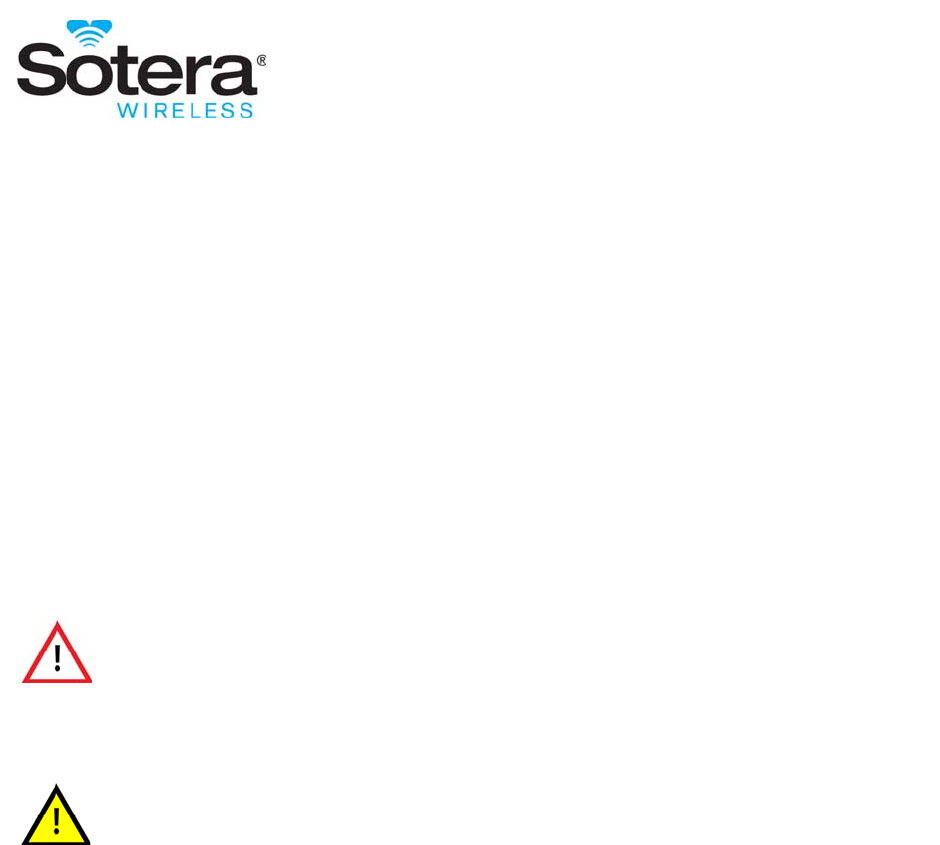
11
2. Warnings and Cautions
2.1 Introduction
Please read and adhere to all warnings, cautions and notes listed here and in the associated sections
throughout this manual.
Do not operate the ViSi Mobile Monitoring System before reading these instructions.
Warning statements alert the user to conditions or practices that could result
in injury to a person, or serious adverse events associated with the use or
misuse of the ViSi Mobile Monitoring System.
Caution statements alert the user to conditions or practices that could result
in problems with the ViSi Mobile Monitoring System associated with its use
or misuse.
Note: Note statements provide supplemental information to the user.

Warnings
12
2.2 Warnings
Intended Use
Do not use the ViSi Mobile Monitoring System outside the intended use described in
this manual. Doing so can result in a delay in or inappropriate therapy.
Do not use the ViSi Mobile Monitoring System in neonatal or pediatric patients under
the age of 18 years since the System has not been tested for these patient groups.
Do not use the ViSi Mobile Monitor as a primary hypoxia diagnostic tool.
Safety
Do not use the ViSi Mobile Monitor in an MRI suite or a hyperbaric chamber.
Avoid electrosurgery burns at the ECG monitoring sites by ensuring the electrosurgery-
return circuit is connected properly.
Monitoring may be temporarily interrupted during the use of electrosurgery in the vicinity
of/or on a patient being monitored with a ViSi Mobile Monitoring System. Observe the
patient closely while electrosurgery is in use.
To ensure patient safety, use only components and accessories recommended or
supplied by Sotera Wireless, Inc. Accessories must always be used in accordance with
your facility’s policies and the manufacturer’s recommendations.
Use only the AC adapter recommended for the ViSi Mobile Charger. Use of other AC
adapters may result in damage to the unit.
There may be a possible hazard caused by the summation of leakage currents when
several items of equipment are interconnected.
The ViSi Mobile Monitoring System has not been tested in the presence of flammable
anesthetics or other flammable agents in combination with air, nitrous oxide, or oxygen-
enriched environments.
Route the patient cabling to avoid the possibility of patient entanglement or
strangulation.
To ensure patient safety, the conductive parts of the ECG electrodes, including
connectors and other patient-applied components, should not contact other conductive
parts, or earth ground, at any time.
Never connect the ViSi Mobile Chest Sensor Cable directly to the AC power outlet.
Never connect the ViSi Mobile Cuff Module directly to an AC power outlet. To recharge
the battery, disconnect the Cuff Module from the patient, and then place it in the ViSi
Mobile Charger.

Warnings
13
Warnings
To prevent possible cross-contamination, properly clean and disinfect all reusable
components between patients.
The ViSi Mobile Monitor should never be used to measure the NIBP of one patient while
the Monitor is simultaneously connected to another patient.
Do not attempt to take NIBP measurements with the ViSi Mobile Monitor while the
patient is undergoing cardio-pulmonary bypass.
Do not attempt to take NIBP measurements with the ViSi Mobile Monitor while the
patient is being treated with an intra-aortic balloon pump or left ventricular assist device.
Periodically observe the patient’s arm for signs of impaired circulation, which may be a
result of measurements made too frequently. Loosen or remove the ViSi Mobile
Disposable Cuff if signs and/or symptoms of prolonged impaired circulation are evident.
Never place the ViSi Mobile Monitor or the ViSi Mobile Cuff Module into the ViSi Mobile
Charger while connected to a patient.
Never connect the ViSi Mobile Monitor directly to an AC power outlet. To recharge the
battery, disconnect the Monitor from the patient, and then place it in the ViSi Mobile
Charger.
Do not clean the ViSi Mobile Monitor with detergents while worn by the patient.
Do not place the ViSi Mobile Monitoring System on or over an implanted programmable
medical device.
When the “Monitor Too Hot” alarm is in progress, ViSi Mobile Monitoring System should
be removed from the patient immediately. Leaving on the patient for an extended
period of time may lead to a skin burn.
When the “Cuff Battery Temp” alarm is in progress, ViSi Mobile Cuff Module should be
removed from the patient immediately. Leaving on the patient for an extended period of
time may lead to a skin burn.
Disposable Components
All disposable components of the ViSi Mobile Monitoring System are for single patient
use only. To avoid possible cross contamination, do not reuse any disposable items on
a patient other than the original patient. Dispose of the components after use per your
facility’s policy.

Warnings
14
Warnings
Patient Monitoring
Do not connect more than one ViSi Mobile Monitor to a patient.
Do not connect more than one patient to a single ViSi Mobile Monitor.
The ViSi Mobile Monitor, Thumb Sensor, Cuff Module, and the Chest Sensor Cable
must all be connected to the same arm for the System to function correctly.
The Wrist Strap should securely hold the ViSi Mobile Wrist Cradle in place without
impairing circulation. Immediately loosen the Wrist Strap if the patient complains of
pain, tingling, or numbness in the affected hand or wrist.
Only use the ViSi Mobile Thumb Sensor provided by Sotera Wireless, Inc. with the ViSi
Mobile Monitoring System. Using non-approved Thumb Sensors may result in
inaccurate SpO2 readings or damaged equipment.
The ViSi Mobile Thumb Sensor is intended for use on the patient’s thumb only. Do not
apply the Thumb Sensor to the patient’s fingers.
Inspect patient’s skin at sensor site per your facility’s protocol. If skin surface has been
compromised, reposition the ViSi Mobile Thumb Sensor or move the Thumb Sensor to
the patient’s other thumb.
Ensure the ViSi Mobile Thumb Sensor is securely fastened. A Thumb Sensor that is
wrapped too tight or too loose can adversely affect SpO2 measurement.
Inspect patient’s skin at sensor site every 8 hours. If skin surface has been
compromised, reposition the ViSi Mobile Thumb Sensor or move the Thumb Sensor to
the patient’s other thumb.
The Thumb Strap should securely hold the ViSi Mobile Thumb Sensor in place without
impairing circulation. Immediately loosen the Thumb Strap if the patient complains of
pain, tingling, or numbness in the affected thumb.
Before monitoring a new patient, ensure all the sensors have been removed and that
monitoring was stopped using the Stop Monitoring procedure.
To prevent settings from being inadvertently changed, lock the ViSi Mobile Monitor
screen (if enabled) as soon as tasks are completed.
Only use the ViSi Mobile Chest Sensor Cable provided by Sotera Wireless, Inc.
for the ViSi Mobile Monitoring System. The Chest Sensor Cable is designed to
provide defibrillation protection as indicated in the Specifications section of this
manual. ViSi Mobile is designed to be compatible with the use of external
defibrillators.

Warnings
15
Warnings
Keep all pacemaker patients under close or constant observation. Pacemaker signals
can differ among pacemakers, ICDs, or CRT devices. The Association for the
Advancement of Medical Instrumentation (AAMI) cautions: “In some devices, rate
meters may continue to count the pacemaker rate during occurrences of cardiac arrest
or some arrhythmias. Do not rely entirely upon rate meter alarms”.
Other RF radiating devices (such as high powered RFID readers and Bluetooth
devices) that are in close proximity with the ViSi Mobile Monitor may interfere with the
Monitor’s wireless communications. During such interference, the Monitor continues to
monitor and will alarm locally. If wireless communication is affected when using the
Monitor in close proximity with another RF radiating device, move the other device
away from the Monitor or discontinue use of the other device.
After monitoring has been stopped on the ViSi Mobile Monitor, removing the patient
from the ViSi Mobile Remote Viewer cannot be undone. Once removed, the patient will
no longer be available on the Remote Viewer.
All wireless devices are susceptible to radio frequency interference that can disrupt
connectivity. If excessive ViSi Mobile Monitoring System disconnections are observed,
notify your biomedical engineer. Excessive disconnections can cause interrupted
patient monitoring; disconnections must be investigated and corrected.
Locate the ViSi Mobile Remote Viewer so that clinicians can view it without obstruction.
Remove any objects that obstruct the display.
A qualified clinician must always be in direct view of the ViSi Mobile Remote Viewer. If
the Remote Viewer display is blank, contact your biomedical engineer immediately for
service.
If a ViSi Mobile Monitor or the ViSi Mobile Remote Viewer display screen is scratched
or damaged, immediately send it for servicing. A scratched or damaged screen can
interfere with patient monitoring.
Always consult Sotera Wireless before performing any changes to the ViSi Mobile
Appliance. Server changes can result in communication failure between components of
the ViSi Mobile Monitoring System. If system communication stops, monitor patients at
the ViSi Mobile Monitors.
Perform a risk assessment and verification before implementing a change or
modification to the IT infrastructure. Changes to IT network configurations can
compromise continuous vital signs monitoring and alarm delivery.

Warnings
16
Warnings
Vital Signs
If a vital signs measurement is questionable, retake the measurement. If the result is
still questionable, use a different method of measurement.
ViSi Mobile arterial measurements have not been clinically tested in the presence of
actual or ventricular arrhythmias. Use alternative BP methods if these arrythmias are
present.
Chest Sensor Cable: ECG, Respiration, Temperature (Skin)
Use all of the same type of high quality ECG electrodes on the patient. Mixing ECG
electrode types can adversely affect ECG monitoring.
Avoid placing the ViSi Mobile Cable Securements and ECG electrodes over areas of
abrasions, irritation, or other sensitive areas. If possible, remove, reposition, and
replace ECG electrodes and Cable Securements if the patient complains of pain/itching
at the sites.
The ViSi Mobile Monitor does not provide automated arrhythmia analysis. As a result,
certain arrhythmias may cause the Monitor to display variable heart rates. If frequent
arrhythmias are suspected, their presence should be confirmed by visual observation of
the ECG waveform or another method, such as a 12-lead ECG.
The ViSi Mobile Monitor does not have automated ST segment analysis, therefore, if a
change in the ST segment of the ECG waveform is suspected, it should be confirmed
by visual observation of the ECG waveform or another method, such as a 12-lead ECG.
Pacemaker signals can differ among pacemakers, ICDs, or CRT devices. The
Association for the Advancement of Medical Instrumentation (AAMI) cautions: “In some
devices, rate meters may continue to count the pacemaker rate during occurrences of
cardiac arrest or some arrhythmias. Do not rely entirely upon rate meter alarms”. All
pacemaker patients should be kept under close or constant observation.
External pacemakers or other external electrical stimulators may cause the ViSi Mobile
Monitor to produce erroneous results.
RESP (chest wall motion) can continue in the absence of ventilation (obstructed
airway). Do not rely on the RESP alone to determine adequacy of ventilation. Other
vital signs, such as HR and SpO2, should be assessed as well.
TEMP monitoring with the ViSi Mobile Monitoring System is intended for trending
purposes only and is not intended to replace core temperature monitoring. Before
making clinical decisions based on the skin temperature measurement, verify the
measurement using another clinically acceptable method of core temperature
measurement.

Warnings
17
Warnings
Impedance pneumography for the determination of respiration (RESP) is not
recommended for use in the presence of mechanically induced, high frequency
ventilation.
Cuff Module / NIBP
ViSi Mobile Disposable Cuffs are for single patient use only. To avoid possible cross
contamination, do not reuse a Cuff on a patient other than the original patient.
The ViSi Mobile Disposable Cuff should be snug enough to support the Cuff Module
while not impairing circulation when deflated.
Avoid applying the ViSi Mobile Disposable Cuff over a wound as this can cause further
injury.
Avoid applying the ViSi Mobile Disposable Cuff on any limb where intravascular access
or therapy, or an arterio-venous (A-V) shunt, is present because of temporary
interference to blood flow which could result in injury to the patient.
Take care in the application of the ViSi Mobile Disposable Cuff when applying the Cuff
to an arm on the same side of a mastectomy. Recommend using the ViSi Mobile
Monitoring System on the opposite arm.
ViSi Mobile NIBP measurements have not been clinically tested in the presence of
actual or ventricular arrhythmias. Use alternative BP methods if these arrythmias are
present.
Inflate the ViSi Mobile Disposable Cuff only after proper application to the patient’s limb.
If you are uncertain of the reliability of an NIBP measurement, repeat the measurement.
If the reading is still suspect, use another method to measure the blood pressure.
SpO2
Oxygen saturation measurements using SpO2 are dependent on proper sensor
placement, exposure to ambient light conditions, and general patient conditions. Before
making clinical decisions based on SpO2 measurements, verify the measurement using
another clinically acceptable method, such as arterial blood gas analysis.
High ambient light condition, including direct sunlight, may interfere with the
performance of the ViSi Mobile Thumb Sensor.
Low perfusion, electrosurgical devices, dysfunctional haemoglobin, the presence of
certain dyes and inappropriate positioning of the ViSi Mobile Thumb Sensor may result
in erroneous measurements.

Warnings
18
Warnings
Alarms / Alerts
When alarms are paused, there is no notification of a potentially clinically significant
change in the patient's vital signs. Observe the patient by other means when alarms are
paused.
When alarms are turned OFF, there is no notification of a potentially clinically significant
change in the patient's vital signs. Observe the patient by other means when alarm
limits are set to OFF.
Once Auto Set is selected (on the ViSi Mobile Monitor), review the newly calculated
alarm limits carefully before deciding to confirm or cancel the new alarm limits. Once
new alarm limits are confirmed on the ViSi Mobile Monitor, they cannot be changed
back to the original pre-set limits from the ViSi Mobile Monitor. Use the ViSi Mobile
Remote Viewing Device to change the alarm limits back to the original pre-set limits.
When the ViSi Mobile Monitor is not connected or loses wireless connection to the ViSi
Mobile Appliance, the ViSi Mobile Remote Viewer does not receive patient alarms or
alerts from the ViSi Mobile Monitor.
When the last source of monitoring is lost due to equipment (such as thumb sensor off,
ECG leads off, all sensors disconnected) the visual annunciation of the alert will not
have an audible component.
Line isolation monitor transients may resemble actual cardiac waveforms and inhibit
heart rate alarms. Ensure correct electrode placement and cable arrangement to
minimize line isolation monitor transients.
To avoid possible hearing damage, do not place your ear too close to the ViSi Mobile
Monitor that is alarming audibly.
When the ViSi Mobile Monitor alarms or alerts, check the patient first to confirm that
there is no immediate danger to the patient.
When testing the speaker at the ViSi Mobile Remote Viewer, if the tone does not sound
or it is not loud enough check the speaker volume is turned up. If the sound is still not
sound loud enough, immediately contact a biomedical engineer. The test indicates how
alarm and alert tones sound at the Remote Viewer. If the volume is inadequate,
clinicians could miss alarms and alerts.
User Maintenance
To avoid contaminating or infecting personnel, the environment or other equipment,
make sure to disinfect and decontaminate the ViSi Mobile Monitoring System
components appropriately before disposing of them in accordance with your country’s
laws for equipment containing electrical and electronic parts.

Warnings
19
Warnings
Wireless Communications
When the ViSi Mobile Monitor is not configured to connect to the facility’s network or
loses wireless connection to the ViSi Mobile Appliance, the ViSi Mobile Remote Viewer
does not receive patient alarms or alerts from the ViSi Mobile Monitor.
If you have any concerns regarding a cyber security breach or vulnerability, contact
Sotera Wireless or an authorized Sotera Wireless representative in your area.
Off-The-Shelf (OTS) Software
The use of any software other than those specified in this manual will violate the safety,
effectiveness and design controls of this medical device and such use may result in an
increased risk to users and patients. Customer installed virus protection software will
be permitted on the ViSi Mobile Remote Viewer but not permitted on the ViSi Mobile
Appliance.

Cautions
20
2.3 Cautions
Intended Use
Federal (U.S.A.) law restricts the ViSi Mobile Monitoring System to the sale, distribution,
or use by, or on the order of a licensed medical practitioner.
The effectiveness of the ViSi Mobile Monitoring System’s blood pressure monitoring
has not been established in pregnant, including pre-eclamptic, patients.
General
When the application is shutdown, remote monitoring will not be available.
Placing the ViSi Mobile Monitor into the Charger when the “All Sensors Disconnected”
alert is displayed will result in the patient’s monitoring session being stopped. It is
recommended that you follow the correct stop/pause monitoring flows.
When monitoring has been paused, monitoring may only be resumed using the same
ViSi Mobile Monitor. If you place the ViSi Mobile Monitor into the Charger with other
Monitors, label the Monitor so that is can be identified when monitoring is to be
resumed.
Moving the ViSi Mobile Monitor out of the network range will break the radio link,
immediately stopping communication of patient vital signs data to the ViSi Mobile
Remote Viewer.
When the wireless connector symbol is yellow, the ViSi Mobile Monitor is unable to
connect to the ViSi Mobile Remote Viewer (via the ViSi Mobile Appliance).
Safety
The ViSi Mobile Monitoring System has not been tested in the presence of flammable
anesthetics or other flammable agents in combination with air, nitrous oxide, or oxygen-
enriched environments.
Do not use a ViSi Mobile Monitor, its components, or accessories that appear
damaged. Inspect all reusable components for damage before each use.
Do not attempt to connect any patient worn component, ViSi Chest Sensor Cable or
ViSi Mobile Cuff Module to an electrical outlet of any kind.
A component that has been dropped or severely abused should be checked by qualified
service personnel before use on a patient.
The ViSi Mobile Monitoring System is not intended for home use.
Do not use the ViSi Mobile Monitoring System to monitor a patient in a wet
environment, such as a shower.

Cautions
21
Cautions
Explosion Hazard. Do not use in the presence of a flammable anesthetic mixture with
air, or with oxygen or nitrous oxide.
Use care when using automatic cuff inflation for prolonged periods on unconscious or
semi-conscious patients since the patient may not be able to alert the clinician to any
pain he/she may be experiencing. Pressing the “Stop NIBP” button interrupts the NIBP
measurement and deflates the cuff.
Consult your Biomed department or vendors for assistance in identifying EMC
compliance status of other medical devices when using the ViSi Mobile Monitoring
System.
Using accessories other than those specified may result in increased electromagnetic
emission or decreased electromagnetic immunity of the monitoring equipment.
Changes in posture can affect ViSi cNIBP accuracy. Recalibrate ViSi cNIBP whenever
torso changes by more than 30o above supine position.
The accuracy of the cNIBP measurement cannot be relied upon in patients with a BMI
greater than 35.
Due to cNIBP signal averaging, there is a time delay between the instantaneous blood
pressure reading and the displayed reading.
You should manually recalibrate cNIBP after any drug administration. The Calibrate
cNIBP alert will not be annunciated.
If using the ViSi Mobile Monitor with any other monitor on the same patient, check that
each monitor does not interfere with the operation of the other. If interference is
detected, remove one or more of the sensors until there is no longer any interference.
Service / Maintenance
If the ViSi Mobile Monitor detects an unrecoverable problem, an error message
containing the error number is displayed. Remove the Monitor from use and report the
error to Sotera Wireless, Inc.
When the ViSi Mobile Monitor is in the Charger and a charging alert occurs, remove the
Monitor from service.
General maintenance of the ViSi Mobile Monitoring System should be conducted at the
hospital defined intervals.
The ViSi Mobile Monitoring System components should only be serviced by Sotera
Wireless, Inc. technicians or authorized service providers.

Cautions
22
Cautions
Equipment / Components
If the ViSi Mobile Monitor is to be stored for an extended period of time, it is
recommended the Monitor be stored with the Shipping Plug inserted to reduce the
battery discharge. The ViSi Mobile Monitor must always have the Shipping Plug
inserted when shipped by a common carrier to comply with Federal Regulations
regarding electromagnetic emissions.
When inserting the ViSi Mobile Monitor into the Wrist Cradle, ensure proper alignment:
flat end to flat end and the round end is pointing down towards the wrist.
Selection of the correct ViSi Mobile Disposable Cuff size is necessary to ensure
accurate NIBP measurements. A Cuff that is too small can result in a falsely high NIBP
measurement. A Cuff that is too large can result in a falsely low NIBP measurement.
Avoid touching the ViSi Mobile Disposable Cuff during cuff inflation as it may disrupt the
measurement.
To avoid damage from dropping the ViSi Mobile Monitor, ensure that the Wrist Strap is
snugly wrapped around the wrist.
To avoid damage from dropping the ViSi Mobile Monitor, make sure that the Monitor is
securely snapped into the ViSi Mobile Wrist Cradle.
The performance of the automated sphygmomanometer may be affected by extremes
of temperature, humidity and altitude.
The ViSi Mobile Monitor may not perform to specification if stored or shipped outside
the specified temperature range.
The ViSi Mobile Monitor may be temporarily interrupted by UHF RFID Systems (860-
960MHz).
Cleaning / Disinfecting
Do not clean the ViSi Mobile Monitor or the Cuff Module while it is plugged into the ViSi
Mobile Charger.
Do not apply liquid to the ViSi Mobile Cuff Module. To clean, use a damp cloth.
Ensure the sensor connector contacts are thoroughly dried to prevent possible
malfunction.
Thumb sensors which are saturated with liquid should be allowed to air dry thoroughly
before re-use.
Do not use abrasive cleaning agents or organic solvents on any of the ViSi Mobile
Monitoring System components.

Cautions
23
Cautions
Use only recommended cleaning / disinfecting agents to prevent damage to the device
and components.
Do not autoclave the ViSi Mobile Monitor, its components, or accessories.
Do not use excessive amounts of liquid when cleaning the ViSi Mobile Chest Sensor
Cable or the ViSi Mobile Thumb Sensor.
After patient use, the disposables from the ViSi Disposable Kit may contain bio-hazard
materials.
When the ViSi Mobile Cuff Module is connected to the other ViSi Mobile Components,
the entire system has an ingress protection rating of IPX0.
Notes
24
2.4 Notes
Note: Figures in this manual are provided for reference purposes only. Screens may differ based on
the monitoring device configuration, licenses available, parameters selected and patient
configuration of the ViSi Mobile Monitoring System.
Note: All ViSi Mobile Monitoring System alarms and alerts annunciate with icons and colors that
comply with IEC 60601-1-8.
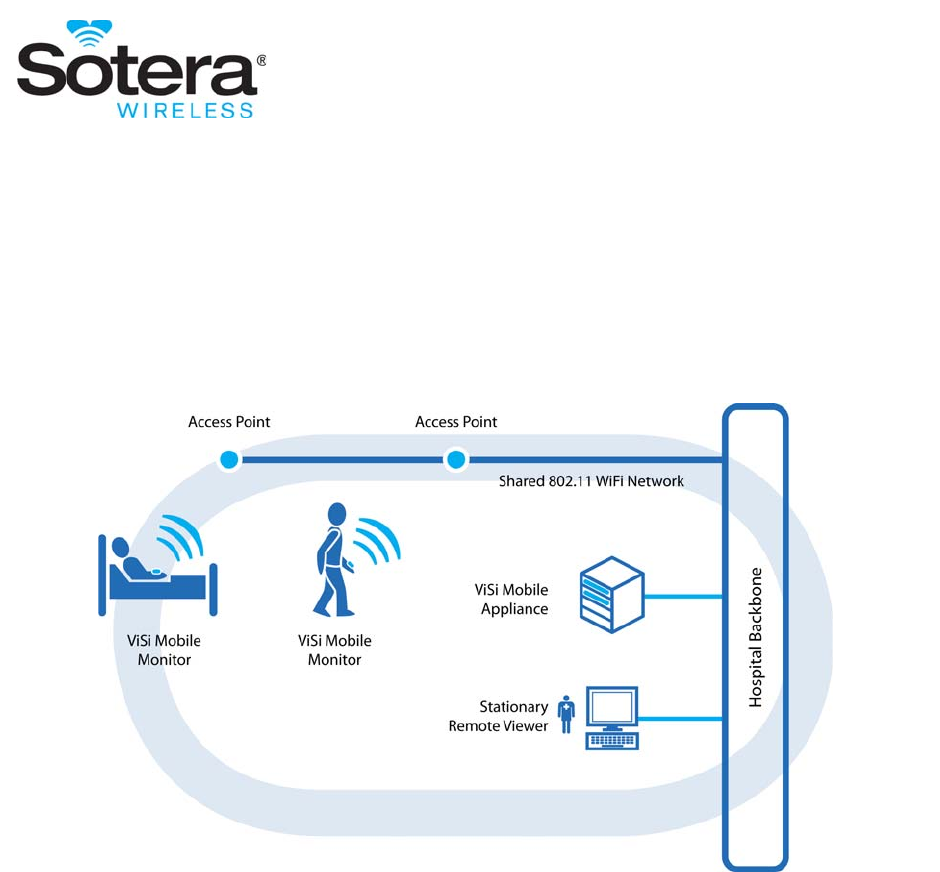
25
3. Overview
The ViSi Mobile Monitoring System enables clinicians to remotely monitor patients who are connected to
ViSi Mobile Monitors. A system includes ViSi Mobile Monitors (see 95-10134), a ViSi Mobile Appliance
and a ViSi Mobile Remote Viewer. Information flows wirelessly and bidirectionally between components.
After connecting a patient to a ViSi Mobile Monitor, the patient’s information appears on the ViSi Mobile
Remote Viewer. Once monitoring has been started, the following tasks may be accomplished remotely:
• View vital sign measurements, for the care unit and for individual patients
• Assign room and identification to patients
• Adjust vital sign alarm limits
• View ECG and other waveforms for individual patients
• Receive and acknowledge alarm and alert notifications
ViSi Mobile Monitoring System
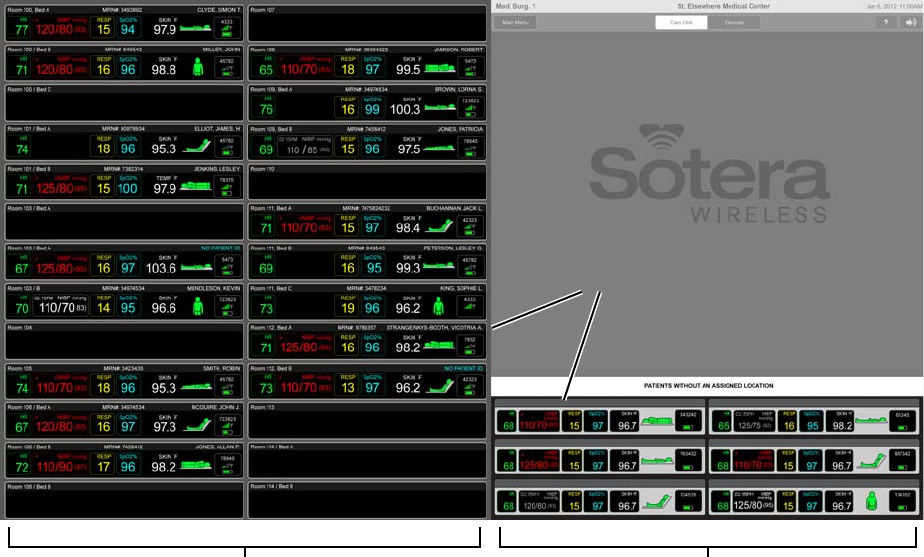
Areas on the ViSi Mobile Remote Viewer
26
3.1 Areas on the ViSi Mobile Remote Viewer
The ViSi Mobile Remote Viewer includes a Care Unit area and a Work Area.
3.1.1 Care Unit Area
The Care Unit Area always appears, displaying Patient Tiles for all actively monitored patients in the unit:
• The Assigned Location Zone shows patients with assigned rooms/beds.
• The Unassigned Location Zone shows patients without assigned rooms/beds.
Depending on your system configuration, the number and appearance of Patient Tiles on your ViSi Mobile
Remote Viewer can vary.
Patient TilesPatient Tiles
Assigned Location Zone Unassigned Location Zone
Care Unit Area
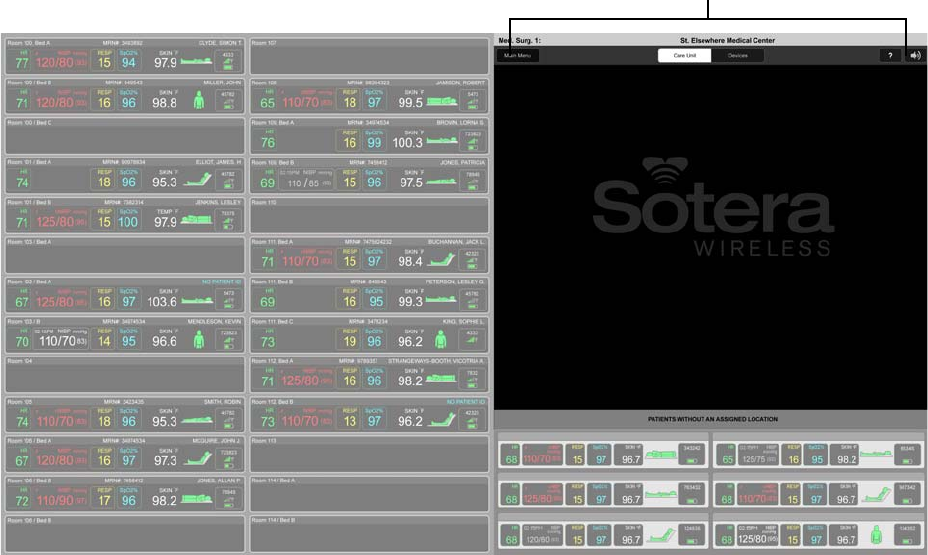
Areas on the ViSi Mobile Remote Viewer
27
3.1.2 Work Area
Views that open in the Work Area display further information about one patient.
Touching a Patient Tile selects the patient and their Patient Home View opens in the Work Area (shown on
page 28). From the Patient Home View, touch or click tabs to navigate to other views for the selected
patient.
In patient views, the following tasks may be performed:
• Edit patient information
• View and adjust alarm limits
• View more in-depth vital sign measurements, such as current waveforms
• Remove a patient from the care unit
To open patient views for a different patient, touch or click the patient’s Patient Tile. To close all patient
views and return to a blank Work Area, touch or click the currently selected Patient Tile.
Work Area
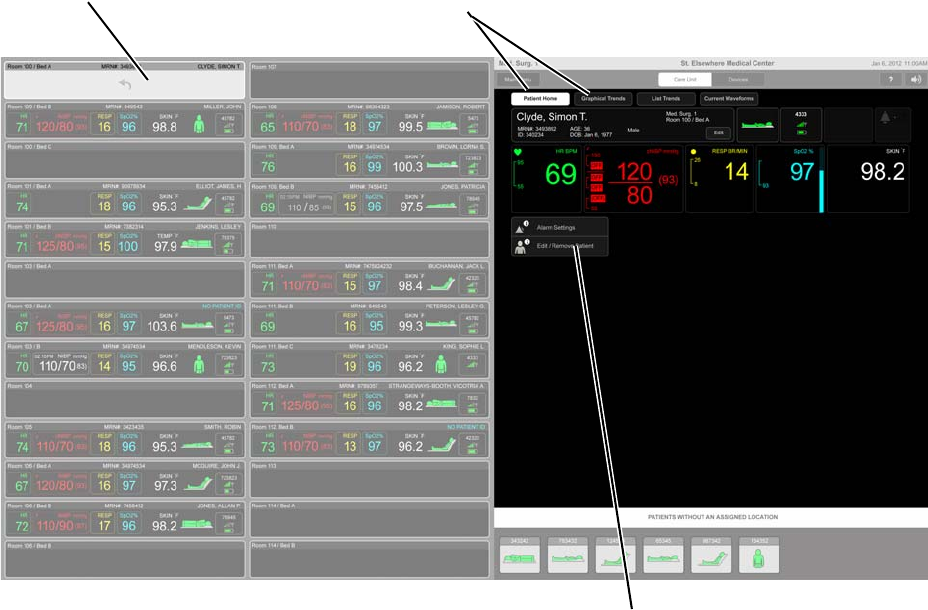
Areas on the ViSi Mobile Remote Viewer
28
Patient Home View and Other Patient Views
When a Patient Tile in the Assigned Location Zone or Unassigned Location Zone is touched or clicked, the
patient is selected and their Patient Home View opens in the Work Area.
When a patient has been selected, a set of Patient Tabs will be displayed at the top of the Work Area.
These tabs enable navigation around the different patient views.
When the Patient Home menu is displayed. These menu items enables the following tasks:
• Adjust the patient’s alarm limits
• Edit the patient’s information
• Remove a patient from the care unit
Selected patient’s Patient Home View
Selected Patient Tile
(Work Area)
Menu
Patient Tabs
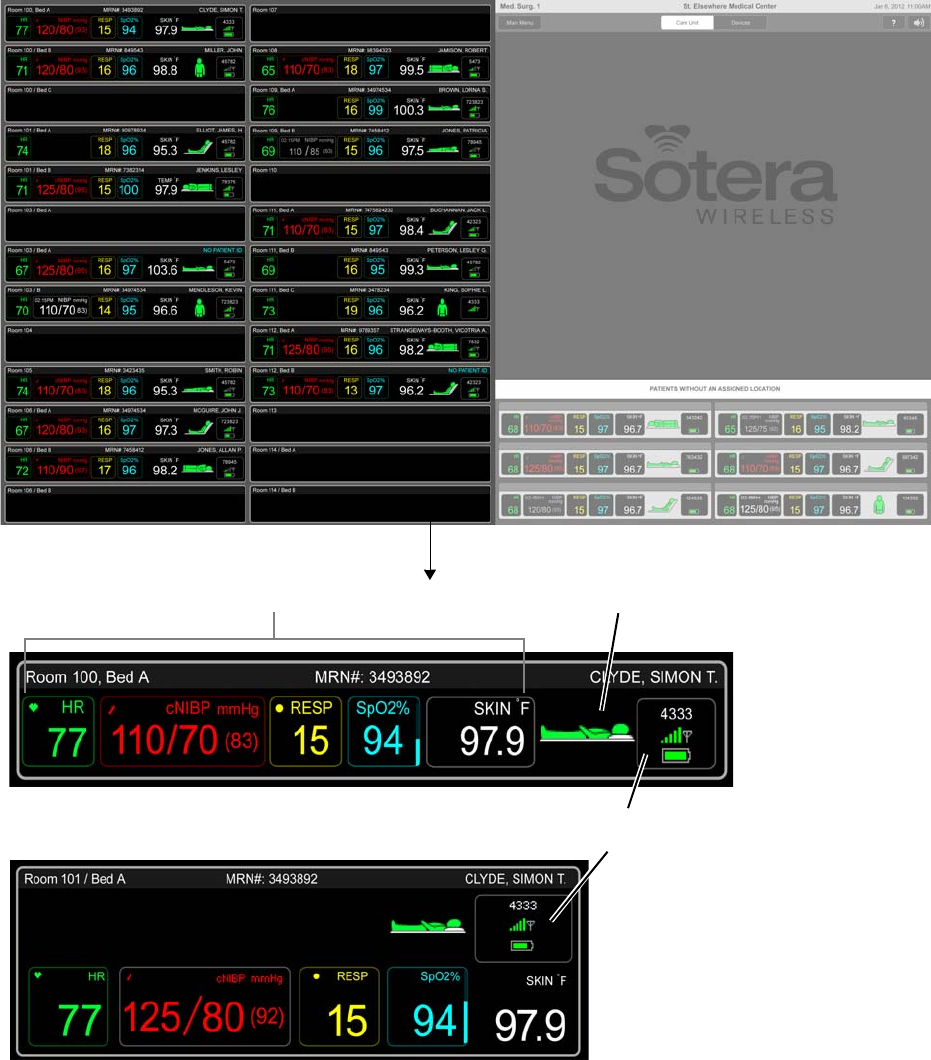
Patient Tiles
29
3.2 Patient Tiles
Patient Tiles appear in the Care Unit Area and in the Work Area.
3.2.1 Care Unit Patient Tiles
Patient Tiles in the Assigned Location Zone
Patient Tiles in the Assigned Location Zone vary in size, depending on your care unit configuration.
Patient’s Vital Sign Patient Posture/Status (ViSi Man™) /
ViSi Mobile Monitor Status
- Monitor Number
Measurements Equipment Status
OR
- Network Connection Strength
- Battery Status
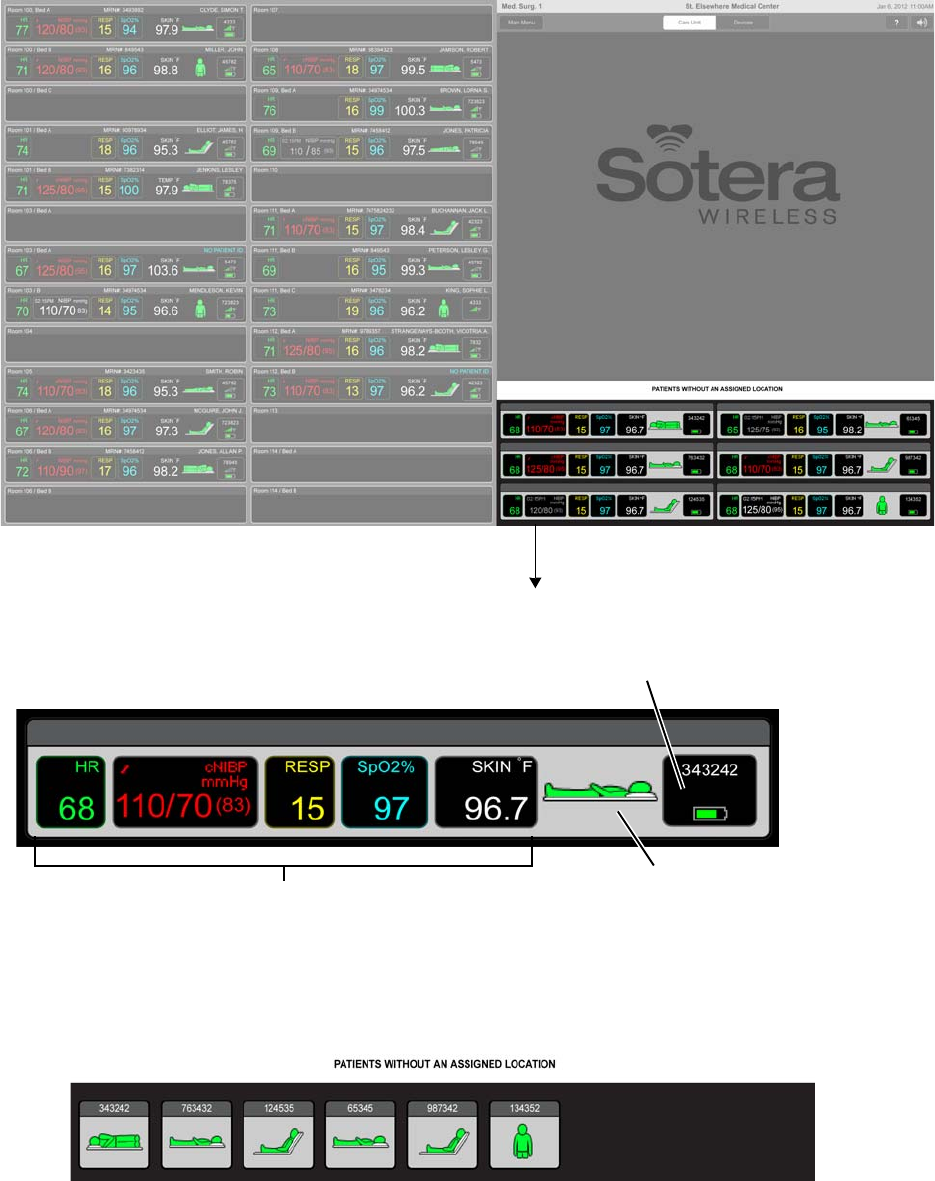
Patient Tiles
30
Patient Tiles in the Unassigned Location Zone
The Unassigned Location Zone of the Care Unit Area holds Patient Tiles for patients that have not been
assigned a room/bed.
Note: When a patient has been selected from either the Assigned Patients or the Unassigned
Patients Zones, the Unassigned Patients Zone will be condensed to provide enough room to
display the selected patient’s details.
Patient’s Vital Sign Patient Posture/Status (ViSi Man™) /
Measurements Equipment Status
ViSi Mobile Monitor Status
- Monitor Number
- Network Connection Strength
- Battery Status
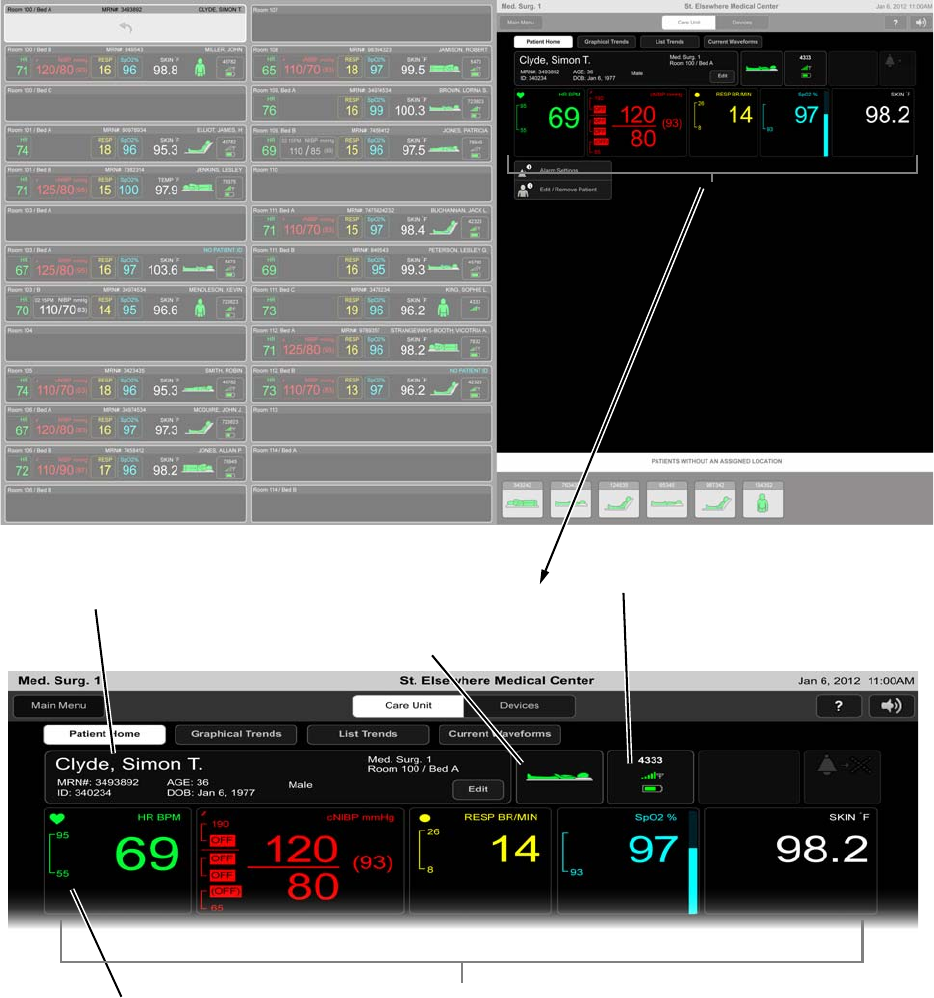
Patient Tiles
31
3.2.2 Work Area Patient Tiles
Patient views in the Work Area include a Patient Tile similar to tiles in the Care Unit Area, but patient view
tiles also show alarm limits and patient information.
Patient Tile in the Patient Home View
Patient’s Vital Sign
Patient Posture/Status (ViSi Man) /
Measurements
Equipment Status
ViSi Mobile Monitor Status
- Monitor Number
- Network Connection Strength
- Battery Status
Patient Information
Alarm Limits
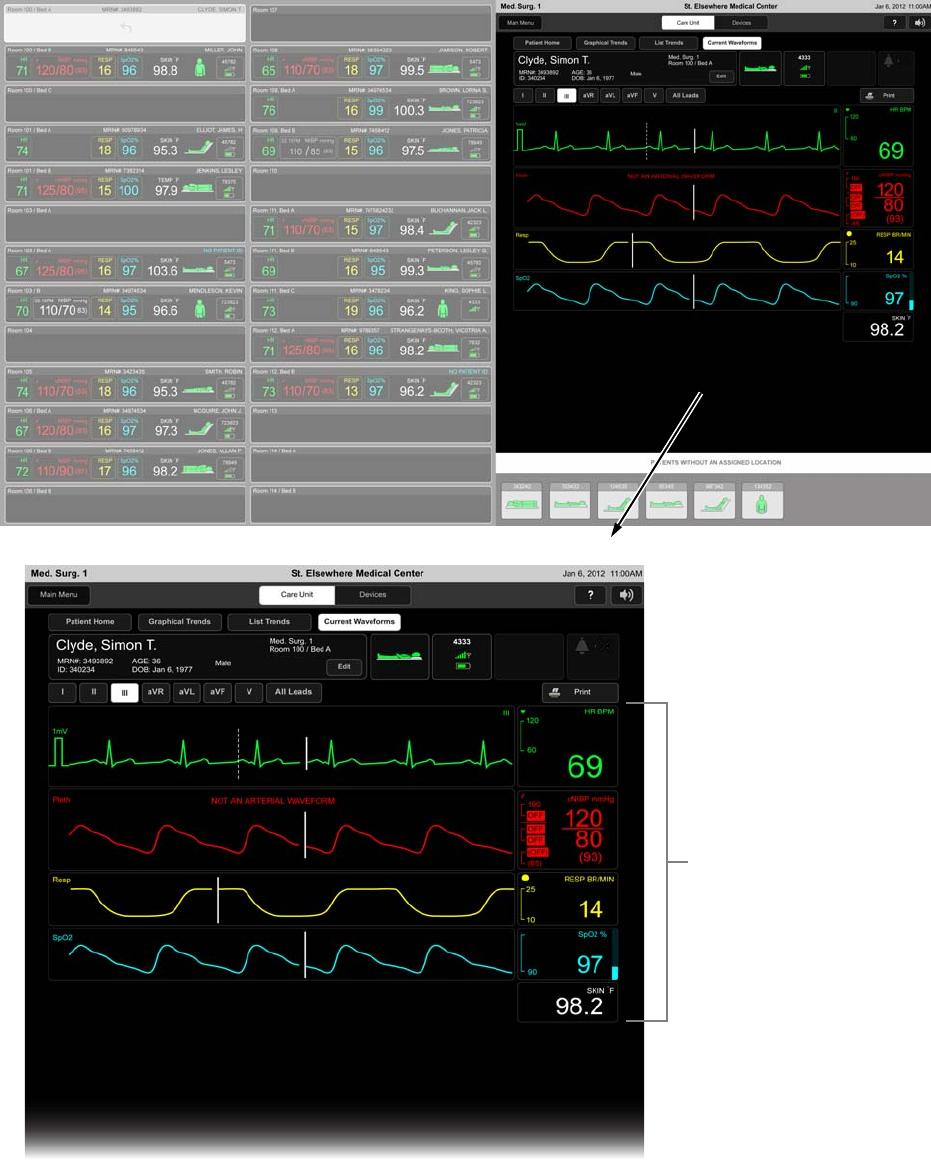
Patient Tiles
32
Patient Tiles in Other Patient Views
In other patient views, vital sign measurements appear on the right side of the view.
Vital sign measurements
and alarm limits
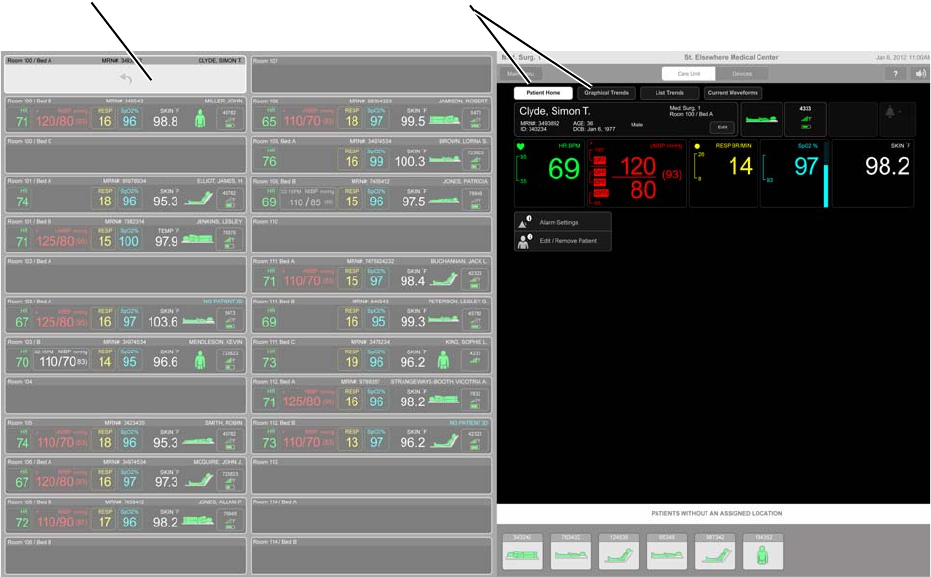
Navigating to a Patient Home View
33
3.3 Navigating to a Patient Home View
Navigation to a patient’s Patient Home View is permissible from any location.
To navigate to a Patient Home View from the Care Unit Area
From anywhere in the Care Unit Area (Assigned Location Zone or Unassigned Location Zone),
touch or click a Patient Tile.
The Patient Tile will display as “selected” and the patient’s Home Page view will be displayed in
the Work Area.
Selected patient’s Patient Home View
Selected Patient Tile
(Work Area)
Patient Tabs
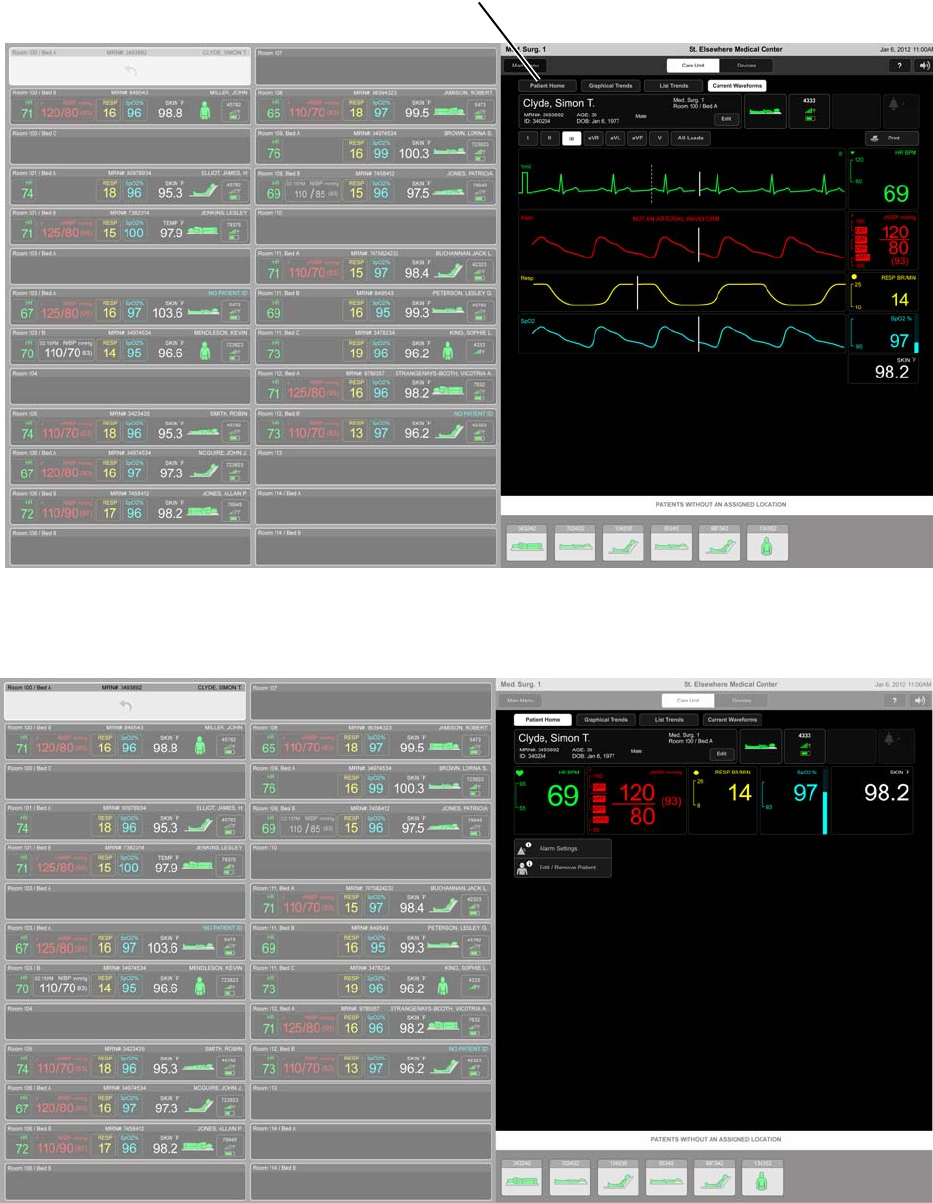
Navigating to a Patient Home View
34
To navigate to the Patient Home View from another patient view
When the Work Area is already open for the desired patient, touch or click the Patient Home Tab.
The patient’s Home Page view will be displayed in the Work Area.
“Patient Home” Tab
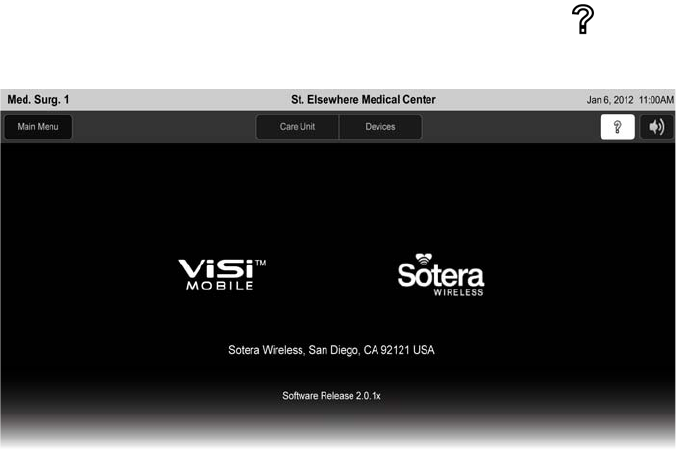
System Help
35
3.4 System Help
The System Help View may be used to identify which software release is currently in use.
To access the system help
In the System Toolbar, touch or click the System Help button.
The System Help screen will be displayed in the Work Area.
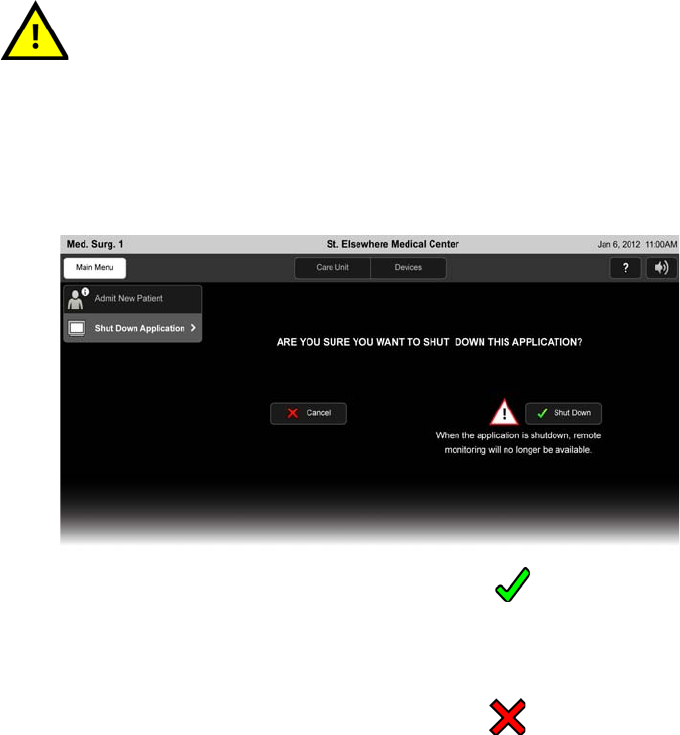
Shutdown the Application
36
3.5 Shutdown the Application
To shutdown the application
1. In the System Toolbar, touch or click the Main Menu button.
The main menu will be displayed in the Work Area.
2. Touch or click the Shut Down Application menu option.
The clinician will be prompted to confirm they wish to shut down the application.
3. Touch Shut Down to shut down the application.
The application will shut down.
-or-
Touch Cancel to cancel the shut down request.
The Shut Down Application menu option will no longer be selected and the shut down request will
be cancelled.
When the application is shutdown, remote monitoring will not be available.

37
4. Wireless Monitoring
4.1 Wireless Monitoring with ViSi Mobile Remote
Viewer
ViSi Mobile Monitors can operate either as standalone devices or in communication with the ViSi Mobile
Remote Viewer through the ViSi Mobile Appliance. While the ViSi Mobile Monitor is connected to the
network, patient data gathered by the monitor is continuously stored by the ViSi Mobile Appliance. This
data is accessible from the ViSi Mobile Remote Viewer. Additional tasks may be performed remotely
from the Remote Viewer:
• Review patient data (vital signs, alarm limits, etc)
• Edit the patient demographics data (name, date of birth, gender, etc)
• Assign a room/bed location
When the ViSi Mobile Monitor is not connected or loses wireless connection to the
ViSi Mobile Appliance, the ViSi Mobile Remote Viewer does not receive patient
alarms or alerts from the ViSi Mobile Monitor.

Communication with ViSi Mobile Remote Viewer
38
4.2 Communication with ViSi Mobile Remote Viewer
ViSi Mobile Monitor’s wireless networking transmission methods are based on the 802.11b standard. This
specification has the marketing name of Wi-Fi. Security is provided by the implementation of WPA2-PSK
security protocols. For specifications pertaining to the wireless radio, see section Wireless
Communications / Radio on page 118. The ViSi Mobile Monitor’s wireless communications depends on
your hospital’s IT infrastructure for connectivity to the ViSi Mobile Appliance, where all data from the
Monitors are aggregated, stored, and interfaced to external systems. For requirements, see Section
11.3.7 ViSi Mobile Appliance on page 124. A risk analysis summary for use by your hospital’s IT
department is provided in Section 11.7 Wireless Network Risk Mitigation on page 140 to assist with ISO
80001-1 compliance. For additional information or assistance, please contact Sotera Wireless or an
authorized Sotera Wireless representative in your area.
The ViSi Mobile Monitor automatically establishes connection whenever the monitor is within range of the
network. Verify that the ViSi Mobile Monitor displays the following symbol (in green) to indicate the
connection to the ViSi Mobile Remote Viewer has been established:
For information on monitoring vital signs, refer to the ViSi Mobile Monitor User Manual, reference#: 95-
10134 (USB).
When the wireless connector symbol is yellow, the ViSi Mobile Monitor is
unable to connect to the ViSi Mobile Remote Viewer (via the ViSi Mobile
Appliance).

Monitoring a patient outside of network range
39
4.3 Monitoring a patient outside of network range
While the ViSi Mobile Monitor typically continually communicates with the ViSi Mobile Appliance and
ViSi Mobile Remote Viewer, occasionally communication may be lost during ambulation or transport
outside the wireless coverage area. When the ViSi Mobile Monitor goes outside of the network range,
monitoring continues locally. The ViSi Mobile Monitor provides local Respiration, NIBP, HR/PR and
SpO2 alarms and alerts. When this happens an alert occurs at the ViSi Mobile Remote Viewer with the
message “CONNECTIVITY LOST”.
When the monitored patient is again within range of the network, the ViSi Mobile Monitor automatically
reconnects to the network and wireless monitoring resumes. Be aware that it can take a few minutes to
restore communication with the network and resume the communication of patient vital signs data.
Moving the ViSi Mobile Monitor out of the network range will break the radio
link, immediately stopping communication of patient vital signs data to the
ViSi Mobile Remote Viewer.
Monitoring a patient outside of network range
40
- Notes -
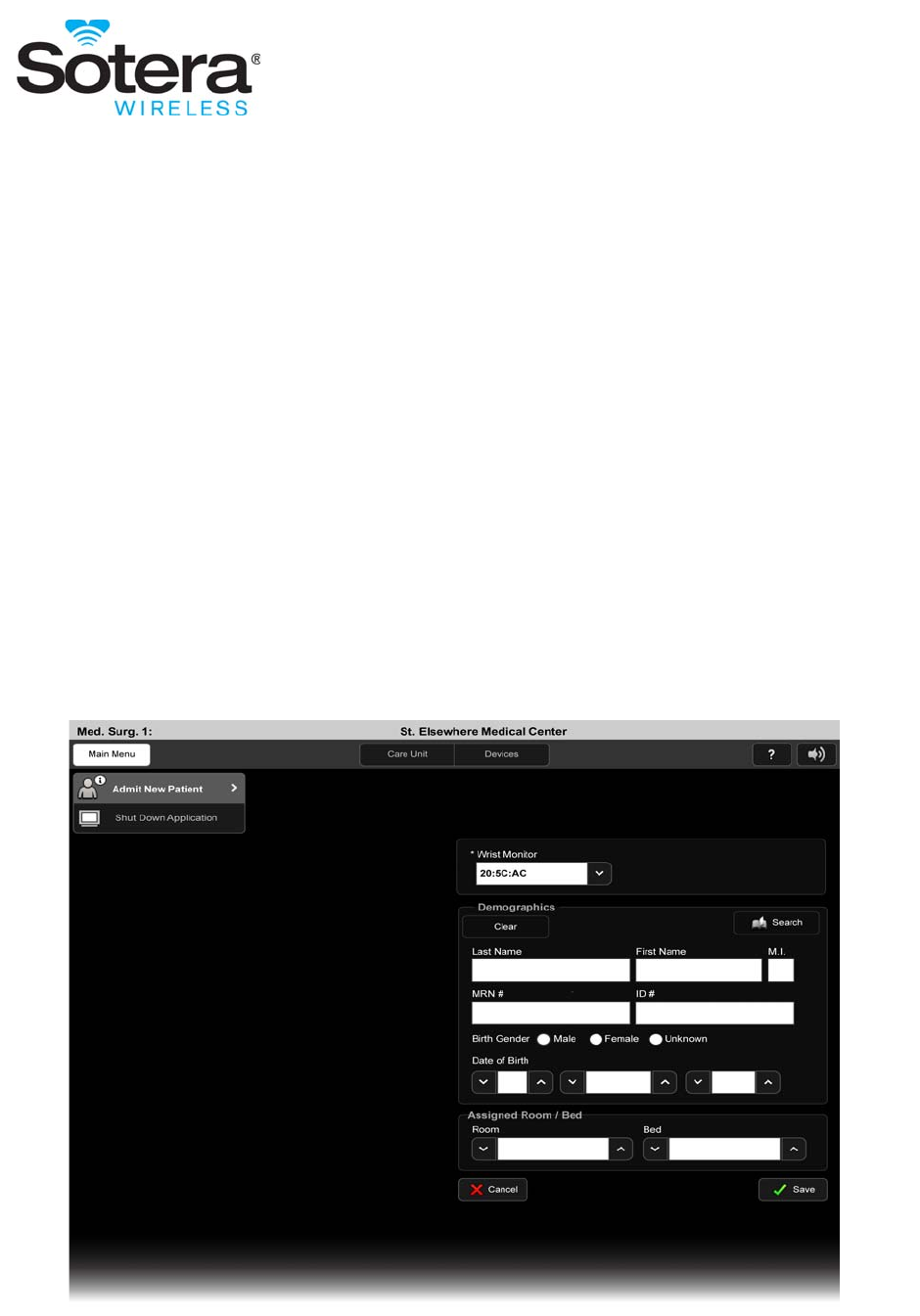
41
5. Setting Up Monitoring
5.1 Admit New Patient
A new patient may be admitted to the ViSi Mobile Monitor / Remote Viewer before monitoring has been
started.
To admit a new patient
1. In the System Toolbar, touch or click the Main Menu button.
The main menu will be displayed in the Work Area.
2. Touch or click the Admit New Patient menu option.
The Admit New Patient pane will be displayed in the Work Area. From the Admit New Patient
pane, the patient’s demographics and room/bed location may be assigned.

Admit New Patient
42
3. In the Admit New Patient pane, select the ViSi Mobile Monitor by its ID# and enter the patient’s
demographics.
When the ViSi Mobile Monitor has been selected and at least one ID field (patient’s name, MRN#
or ID#) the Save button will be enabled.
Note: The ID# is located on the Monitor Status screen in the top row of the display.
4. Touch or click Save to confirm the changes.
-or-
Touch or click Cancel.
If cancelled, no changes will be saved and the Admit New Patient pane will be closed.
If saved, the Patient Tile will be displayed with the message “Monitoring Paused”. If a room/bed
was selected, the Patient Tile will be displayed in the Assigned Location Zone. If no room/bed was
selected, the Patient Tile will be displayed in the Unassigned Location Zone. See 8.1 Pause
Monitoring on page 85.
5. Go to the bedside and place the ViSi Mobile Monitor on the patient, and apply sensors.
The Patient Tile will automatically display the patient’s vital signs.
Patient Tile in Assigned Location Zone Patient Tile in Unassigned Location Zone
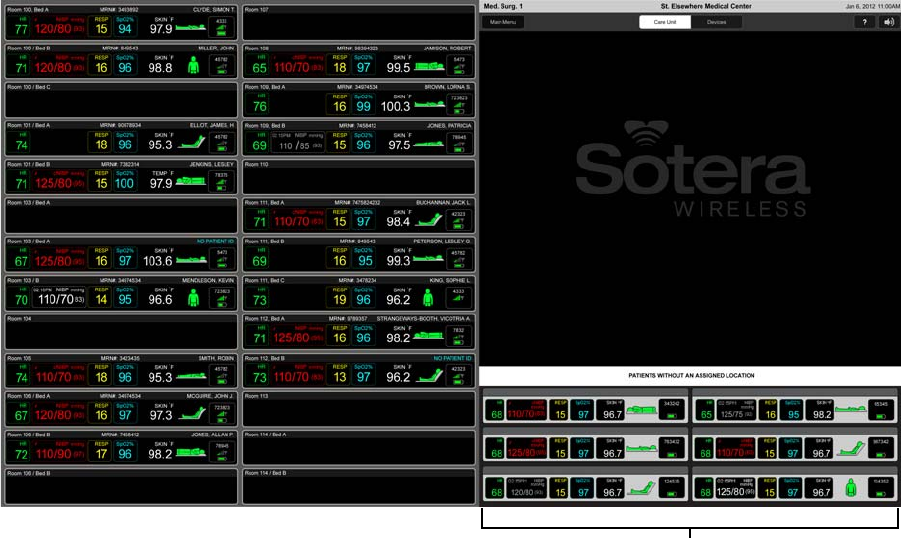
Start Monitoring Before Admit
43
5.2 Start Monitoring Before Admit
Monitoring of a patient may be started before the patient is admitted through the ViSi Mobile Remote
Viewer. When a ViSi Mobile Monitor begins monitoring before the patient is admitted (through the
Remote Viewer), the Remote Viewer shows the patient’s active data in the Unassigned Location Zone of
the Care Unit Area.
Note: Adjusting alarm limits is covered in section Manage Alarm Limits on page 81.
To start monitoring before admit
1. Place the ViSi Mobile Monitor on the patient, and apply sensors.
A Patient Tile will automatically appear in the Unassigned Patients Zone.
Patient will appear in the
Unassigned Location Zone
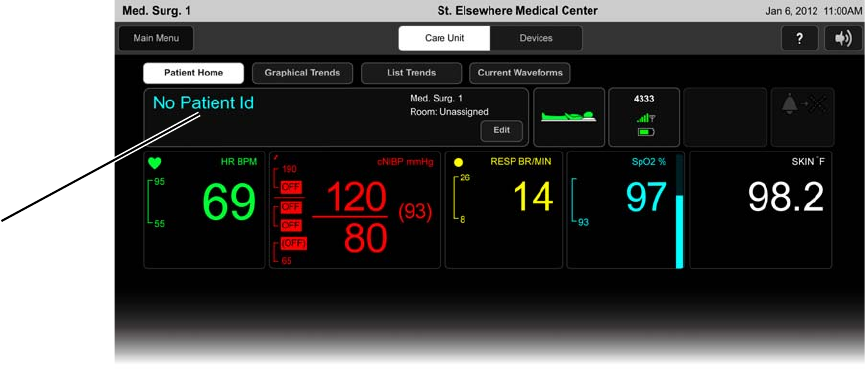
Start Monitoring Before Admit
44
2. At the ViSi Mobile Remote Viewer, touch or click the patient’s Patient Tile in the Unassigned
Location Zone.
The Patient Tile will display as “selected” and the patient’s Home Page view will be displayed in
the Work Area.
3. Navigate to the patient’s Demographics pane and enter the demographic information (for
instructions, see Editing Patient Demographics on page 45).
Demographics
not yet entered
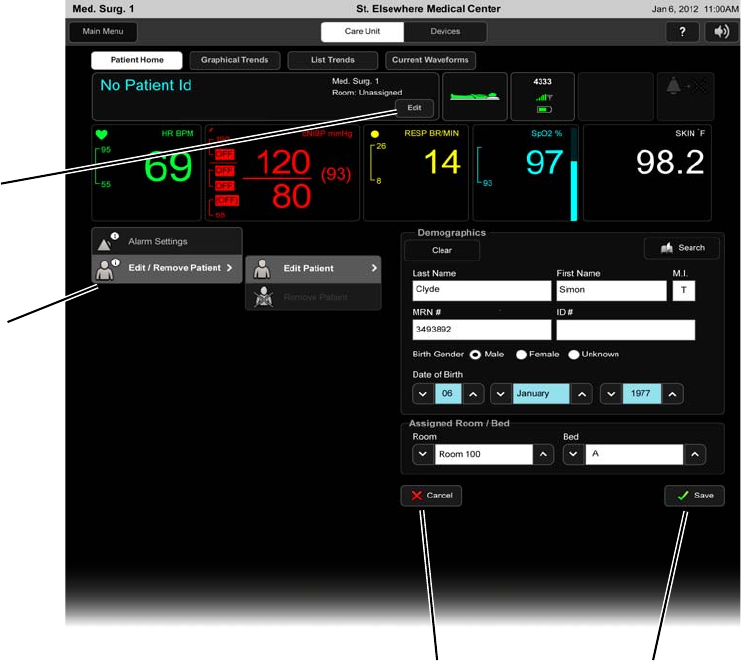
Editing Patient Demographics
45
5.3 Editing Patient Demographics
The Demographics pane may be used to edit information for a patient being monitored by the ViSi Mobile
Monitoring System.
To edit patient information
1. Navigate to the patient’s Patient Home View (for instructions, see Navigating to a Patient Home
View on page 33).
The Patient Tile will display as selected and the patient’s Home Page view will be displayed in the
Work Area.
2. In the Patient Demographics Zone in the Patient Home View, touch or click Edit.
-or-
Touch or click the Edit/Remove Patient menu option followed by the Edit Patient menu option.
The patient Demographics pane will be displayed in the Work Area. From the Demographics
pane, the patient’s demographics and assigned room/bed may be modified.
Edit
Menu options:
- Edit / Remove Patient
- Edit Patient
Save
Cancel
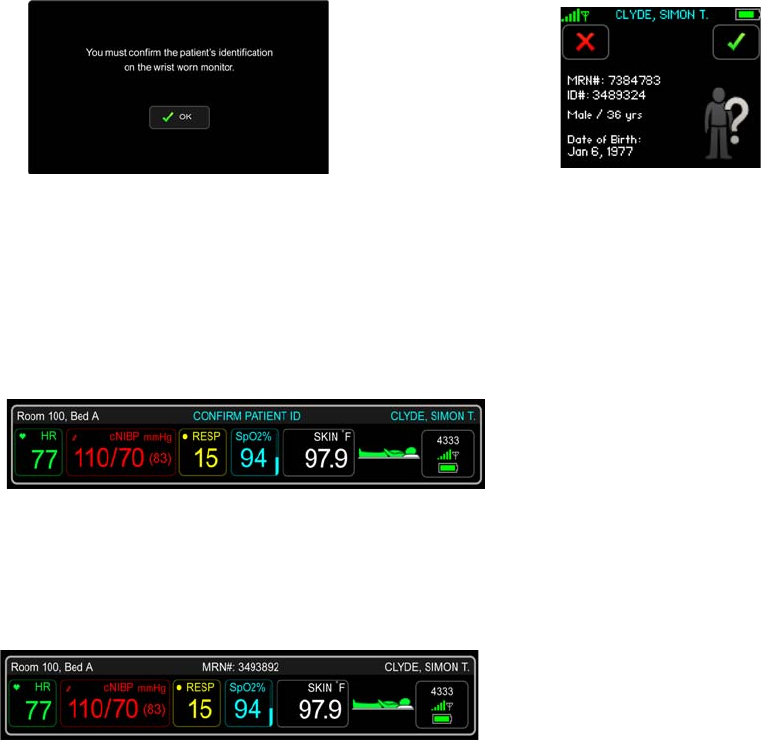
Editing Patient Demographics
46
3. In the Demographics pane, add or change patient information.
When any field within the Demographics pane has been modified, the Save button will be enabled.
4. Touch or click Save to confirm the changes.
-or -
Touch or click Cancel.
If cancelled, no changes will be saved and the Demographics pane will be closed.
If saved and modifications were made to any of the patient’s identification fields (Name, MRN# or
alternative ID), a popup window will appear on the Remote Viewer with instructions on how to
complete the patient confirmation process. Additionally, on the ViSi Mobile Monitor, the Confirm
Patient ID screen will be displayed when navigating from the Patient View screen to the Vital Signs
screen.
5. On the popup window, touch or click OK.
The Patient Tile will display the patient’s primary ID in blue as a reminder that the patient’s ID
must be confirmed at the patient’s bedside (on the ViSi Mobile Monitor).
If a room and bed were entered, the Patient Tile will move from the Unassigned Location Zone to
the Assigned Location Zone.
6. Go to the bedside, wake up the ViSi Mobile Monitor, unlock the Monitor and confirm the patient’s
ID when prompted to do so.
The patient’s primary ID and secondary ID will be displayed in white text to indicate confirmation
is complete.
Note: The patient’s ID will continue to display in blue until the patient’s ID is confirmed on the
ViSi Mobile Monitor. There is no time limit in which you much confirm the patient’s ID.
Instructions on the Remote Viewer Confirmation on the Mobile Monitor
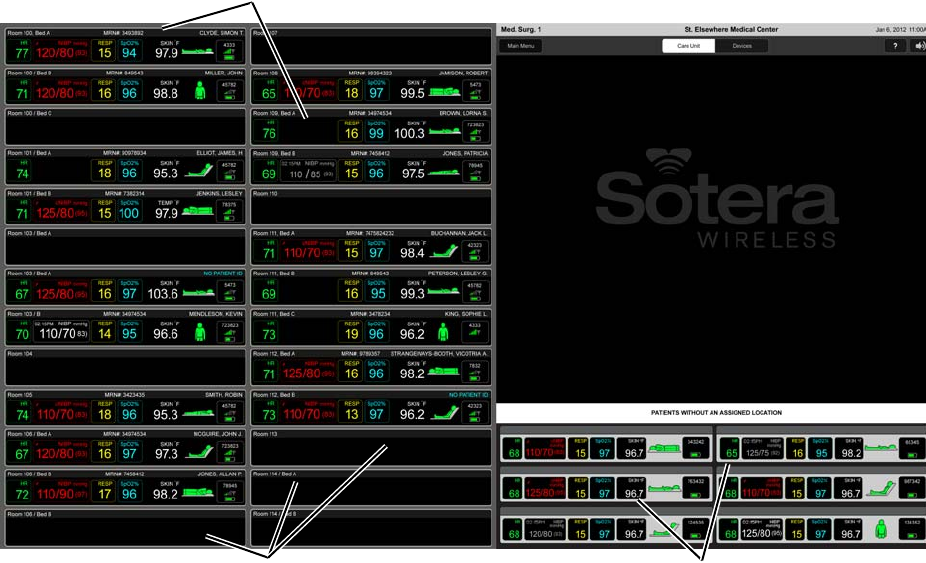
Designating Patient Locations
47
5.4 Designating Patient Locations
A new location for a patient may be designated in any of these ways:
• Drag and drop the patient’s Patient Tile to an unoccupied location in the Care Unit Area.
• Enter or change location information in the Demographics pane in the Patient Home View.
5.4.1 Dragging and Dropping to a New Location
Drag and drop a Patient Tile in the Care Unit Area to accomplish these tasks:
• Move a patient without a room/bed assignment to a room/bed
• Move a patient from one location to another location in your care unit
• Un-assign a patient’s room/bed
To drag and drop a Patient Tile
While touching or clicking on the patient’s Patient Tile, drag and drop the tile to an unoccupied
location in the Care Unit Area.
The patient will be moved to the new location.
Unoccupied Locations
(Assigned Location Zone)
Patient Tiles
(Unassigned Location Zone)
Patient Tiles
(Assigned Location Zone)
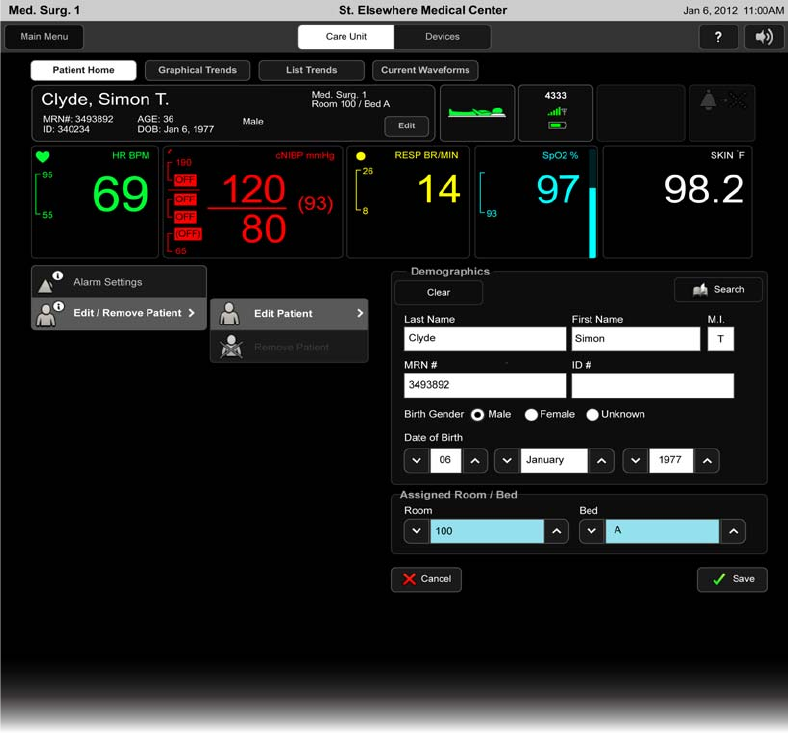
Designating Patient Locations
48
5.4.2 Entering Location Information
Enter a patient’s location in the Demographics pane of the Patient Home View.
To enter location information
1. Navigate to the patient’s Demographics pane (for instructions, see section Editing Patient
Demographics on page 45).
The patient Demographics pane will be displayed in the Work Area.
2. In the Assigned Room/Bed area of the Demographics pane, add or change location information.
When any field within the Demographics pane has been modified, the Save button will be enabled.
Designating Patient Locations
49
3. Touch or click Save to complete the move to a new location.
-or -
Touch or click Cancel.
If cancelled, the patient will remain in their original location.
If saved the patient’s Patient Tile will move to the newly selected location.
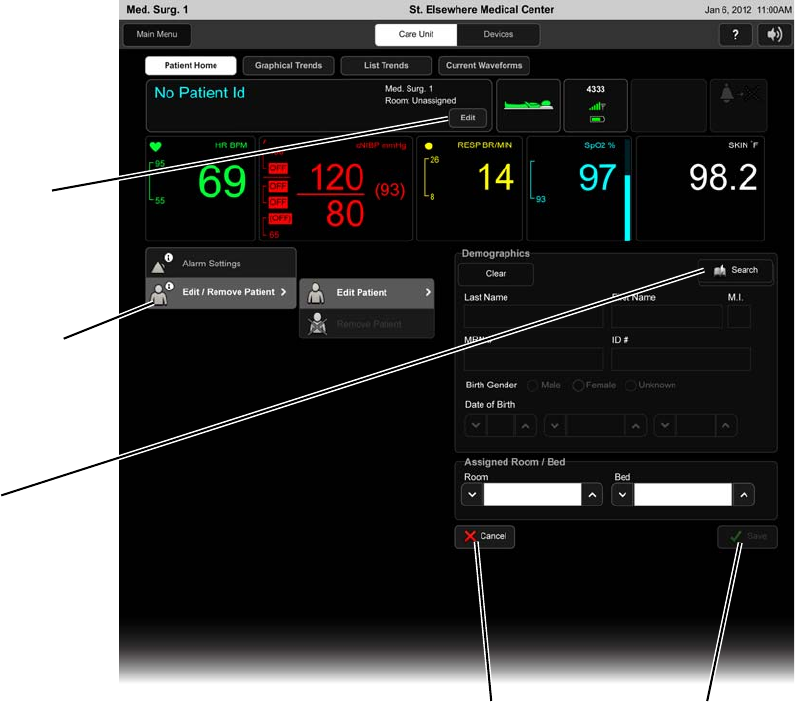
ADT Interface
50
5.5 ADT Interface
When the ViSi Mobile System interfaces with the facilities ADT system, you will not be able to manually
enter the patient’s demographic data. You will need to select patients from the ADT system.
To Select Patients from ADT
1. Navigate to the patient’s Patient Home View (for instructions, see Navigating to a Patient Home
View on page 33).
The Patient Tile will display as selected and the patient’s Home Page view will be displayed in the
Work Area.
2. In the Patient Demographics Zone in the Patient Home View, touch or click Edit.
-or-
Touch or click the Edit/Remove Patient menu option followed by the Edit Patient menu option.
The patient Demographics pane will be displayed in the Work Area.
Edit
Menu options:
- Edit / Remove Patient
- Edit Patient
Save
Cancel
Search
(ADT)
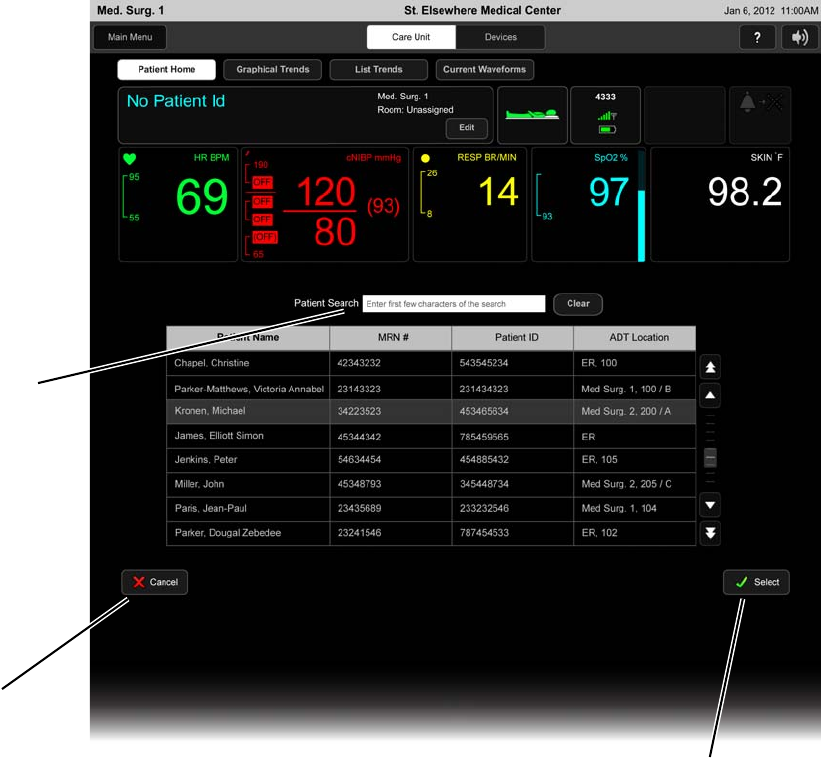
ADT Interface
51
3. In the Demographics area of the Demographics pane, touch or click the Search button.
The ADT Patient Search pane will be displayed.
4. In the ADT Search pane, enter the search criteria in the Patient Search field and then touch or click
on the desired patient in the “Results” table.
As data is typed into the “Patient Search” field, the “Results” table will automatically update with
patients who match the entered search criteria.
5. Touch or click Select to select the highlighted patient.
-or-
Touch or click the Cancel button.
If cancelled, the selected patient will not be displayed in the Demographics area in the
Demographics pane.
Select
Cancel
Patient Search
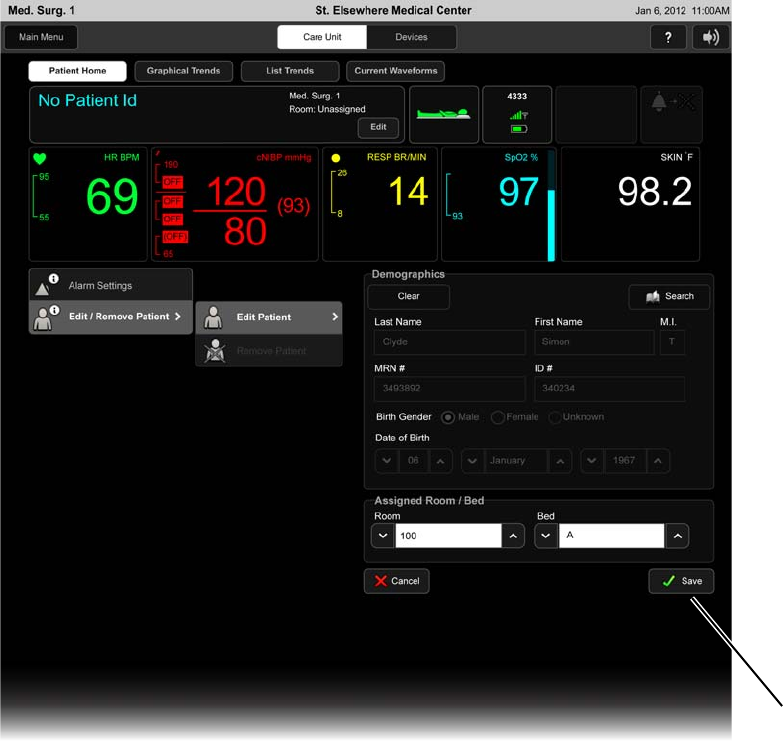
ADT Interface
52
If selected, the patient will be displayed in the Demographics area in the Demographics pane.
Note: The selected patient is not saved until the Save button is clicked or touched on the
Demographics pane.
Save
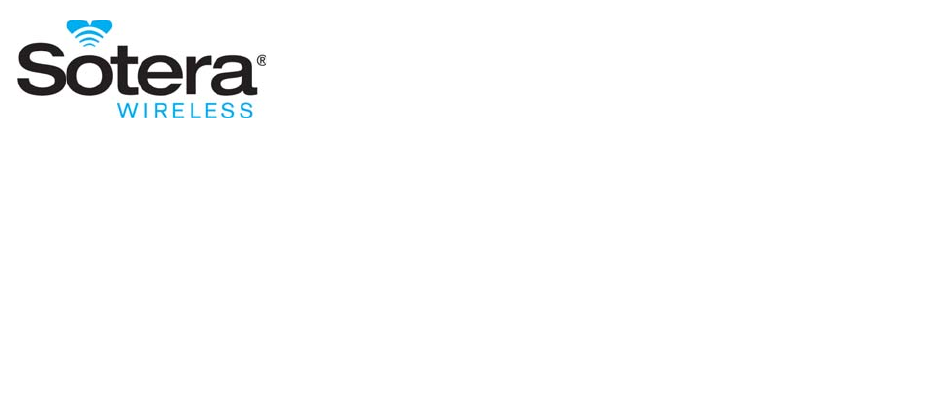
53
6. Patient Monitoring
6.1 Viewing Vital Sign Measurements
Vital sign measurements may be viewed in Patient Tiles.
Vital Sign Measurements Displayed in the Care Unit Area
The Care Unit Area shows Patient Tiles for all patients being monitored by the care unit. Each Patient Tile
shows the patient’s vital sign measurements. The Care Unit Area is always visible on the ViSi Mobile
Remote Viewer.
The HR/PR source is as follows:
• The HR source is from ECG (ViSi Mobile Chest Sensor Module)
• In the absence of an HR source from an ECG, the Pulse Rate (PR) can be measured and displayed
from the SpO2 channel.
• In the absence of an HR source from an ECG and a PR from the SpO2 channel, PR can be
measured and displayed from the NIBP reading.
NIBP measurements will fade to gray after 30 seconds. After 30 minutes, the measurements will no longer
be displayed.
The patient’s posture will only be displayed after the user has confirmed the patient’s posture on the ViSi
Mobile Monitor. Until the patient’s posture has been confirmed, the unknown posture icon will be
displayed.
Note: The vital sign measurements (including the patient’s posture) are refreshed every 3 seconds.
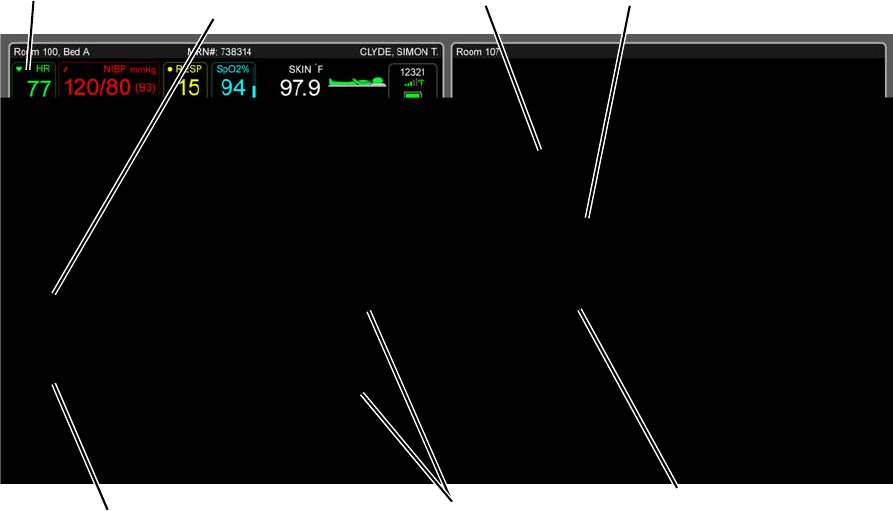
Viewing Vital Sign Measurements
54
NIBP
HR from ECG NIBP
(After 30 seconds)
PR fromSpO2
PR from NIBP NIBP
(Continuous)
(Spot Check)
Patient’s Posture
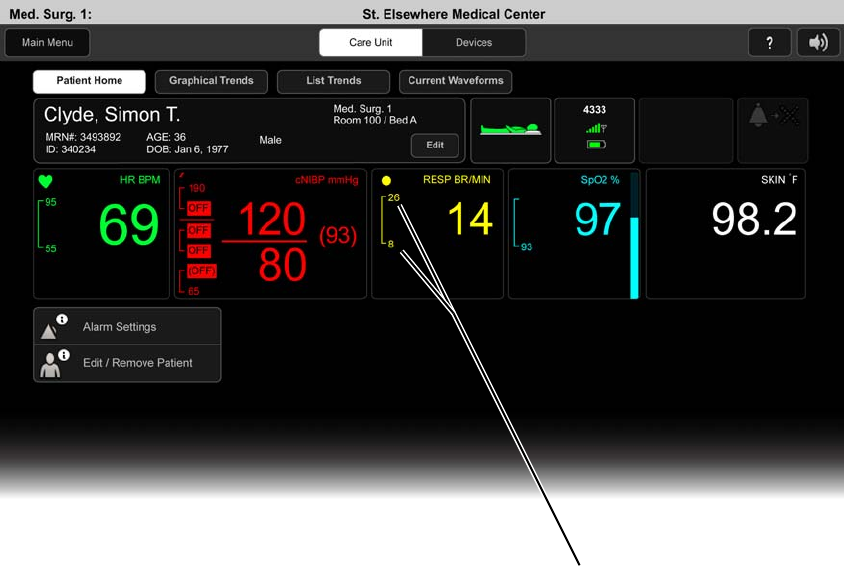
Viewing Vital Sign Measurements
55
To view one patient’s measurements in a patient view
Navigate to the patient’s Patient Home View (for instructions, see Navigating to a Patient Home
View on page 33).
The patient’s Home Page will be displayed in the Work Area.
Note: In the Work Area, only the vital sign measurements for the selected patient will be displayed.
Alarm Limits
(for each vital sign measurement)
Viewing Graphical Trends
56
6.2 Viewing Graphical Trends
Graphical Trends is a view of the patient’s vital signs over time displayed in graphical format. There are
trend lines for the five vital signs monitored by the ViSi Mobile Monitor: heart/pulse rate; NIBP;
respiration rate; SpO2 and skin temperature. Additionally, there is a status bar that shows either the alarm
status or a list of events (such as cuff inflation, demographic updates, etc).
When navigating to the Graphical Trends view from a non-historical view (such as the Patient Home view
or the Current Waveforms view), the Graphical Trends view will display trends for the last hour and the
Time Cursor will be located at tNow - 30 minutes.
When navigating to the Graphical Trends view from a historical view (such as List Trends), the Graphical
Trends view will display the previously selected time scale (if applicable) or the most appropriate time
scale (if not previously selected). The Time Cursor will be located at the selected time line.
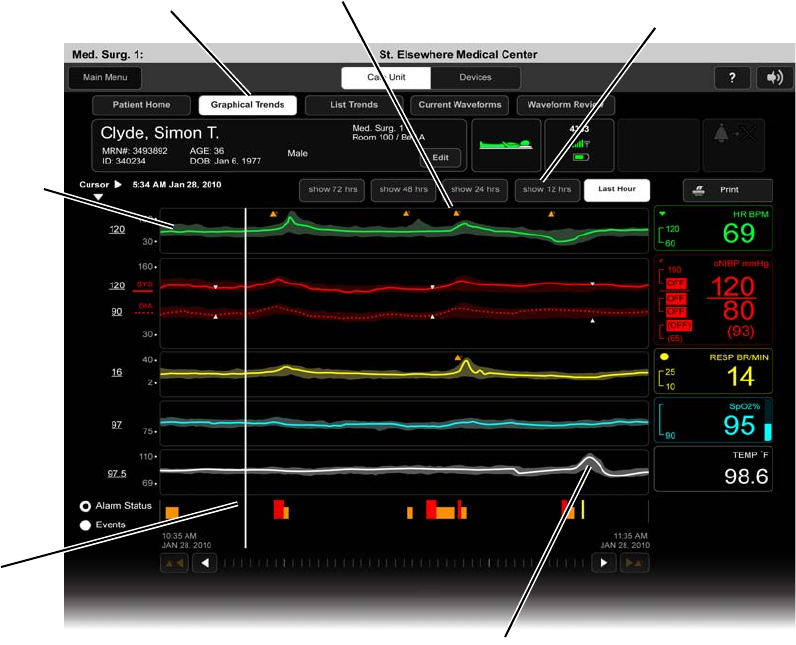
Viewing Graphical Trends
57
6.2.1 Viewing all Vital Sign Trends
To view vital sign trends in graphical format
1. Navigate to the patient’s Patient Home View (for instructions, see Navigating to a Patient Home
View on page 33).
The patient’s Home Page will be displayed in the Work Area.
2. Touch or click the Graphical Trends Tab.
The Graphical Trends View will be displayed in the Work Area.
Note: When monitoring is resumed after an interruption in monitoring (such monitoring paused,
all sensors being disconnected), the graphical trends view will only display the trend data
collected since the resumption of monitoring until the patient’s identity has been confirmed
on the ViSi Mobile Monitor.
Timescale
Time cursor
Graphical Trends
Selection
Tab
High/low measurement for time period
(Shaded area behind trend line)
Vital Sign
Trend
Patient Alarms
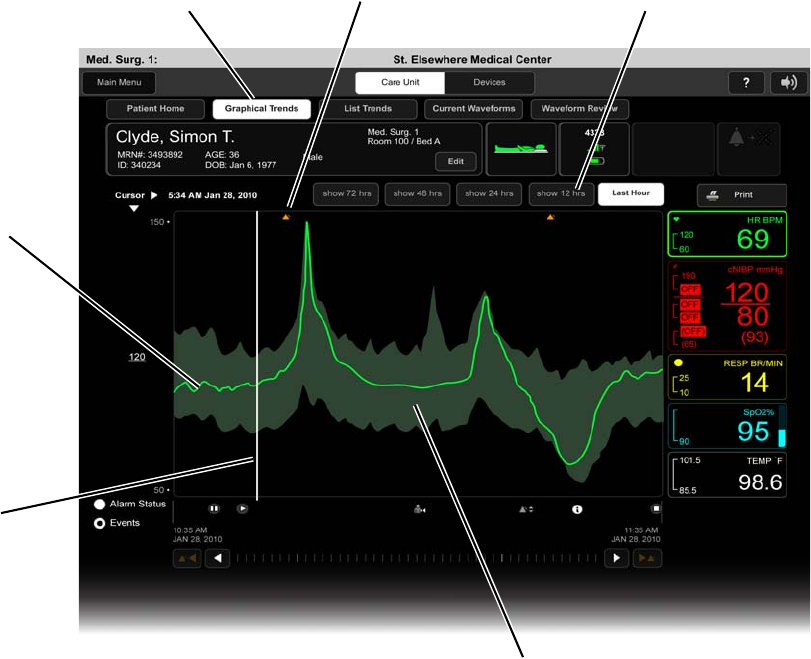
Viewing Graphical Trends
58
6.2.2 Viewing a Single Vital Sign Trend
To view a single vital sign trend in graphical format
1. Navigate to the Graphical Trends view (see above).
The Graphical Trends view will be displayed in the Work Area.
2. Touch or click the Vital Sign box.
The Graphical Trends View showing the selected vital sign trend will be displayed in the Work
Area.
Time Scale
Time Cursor
Graphical Trends Selection
Tab
High/low measurement for time period
(Shaded area behind trend line)
Vital Sign
Trend
Patient Alarms

Viewing Graphical Trends
59
6.2.3 Graphical Trend Features
Time scale Displays
Clicking on any of the time scale buttons will change the time scale display. There are 5 time scales
available: last hour; 12 hours; 24 hours; 48 hours; and 72 hours.
When viewing the last hour time scale, the last hour will always end at tNow (or at the time monitoring was
stopped). The trend will automatically update every minute. The trend will not automatically update when
viewing any other timescale.
Use the scroll bar to move the trend display either left or right of the current view. The scroll bar is not
active when the last hour timescale is displayed.
Clicking on the next/previous alarm buttons will move the trend view to the next/previous alarm and place
the Time Cursor on the alarm event. The next/previous alarm buttons will be disabled when there is no
next/previous alarm.
Trend Line
Each dot (pixel) along the trend line will display the median vital sign measurement over the time period
the dot (pixel) represents. The time period represented will change depending on the view currently
selected. See table below.
Each NIBP measurement taken will be represented as follows:
• Systolic: Downward arrowhead
• Diastolic: Upward arrowhead
• MAP: White dot (expanded view only)
Behind each trend line, there is a shaded graph representing the minimum and maximum vital sign
measurement during the time period the pixel represents. See High/low measurement for time period label
in the diagram above.
The alarm limits for each vital sign are displayed as gray shaded blocks behind the trends lines.
Time Cursor
The date/time corresponding to the Time Cursor position will be displayed to the right of the “Cursor”
label and the vital signs will be displayed to the left of the corresponding trend line.
When the Time Cursor has been moved, the time selected will become the central point when switching to
one of the other historical views, such as List Trends.
Selected View Time Period
Last Hour 30 seconds
12 Hours 12 minutes
24 Hours 24 minutes
48 Hours 48 minutes
72 Hours 72 minutes
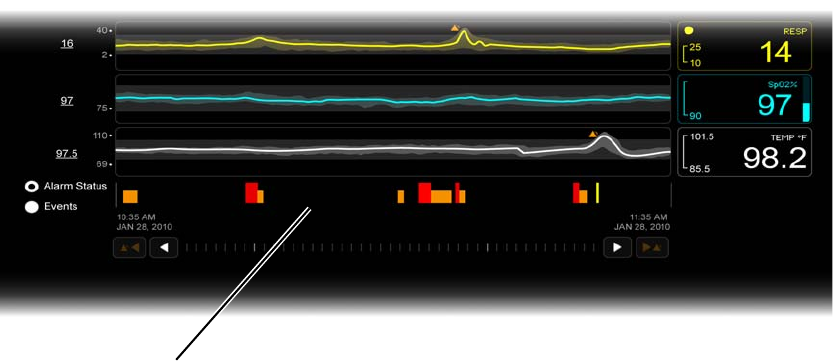
Viewing Graphical Trends
60
Grabbing and moving the Time Cursor will move it in the direction of the move; the trend display will
remain static.
Patient Alarms
Alarm event markers will be displayed at the top of their corresponding trend box to indicate when the
patient went into alarm. Double clicking on the alarm event marker will navigate to the List Trends view.
Hovering the mouse over the event marker will display the details of the event: alarm type and date/time
of occurrence.
Alarm/Events Status Bar
When the “Alarms Status” radio button is selected, the Alarms/Events Status Bar will display the alarm
states:
• When no alarms have occurred and alarms are turned on for the duration of the time period for
which the “Alarm Status” pixels represent, the pixels will be black.
• When a life-threatening or high severity alarm occurred during the time period for which the
“Alarm Status” pixels represent, the pixels will be red.
• In the absence of any alarms, when the alarms are turned off or paused during the time period for
which the “Alarm Status” pixels represent, the pixels will be orange.
Alarm/Events Status Bar
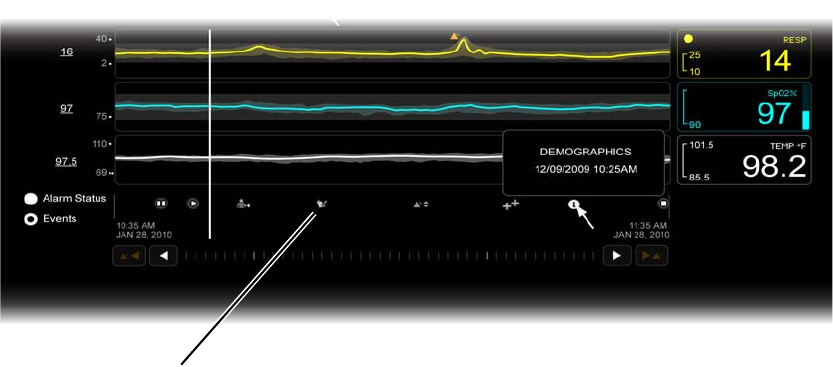
Viewing Graphical Trends
61
When the “Events” radio button is selected, the Alarm/Events Status Bar will display the patient events:
• Start NIBP cuff inflation
• Alarms changed
• Patient demographics changed
• Alarms paused / turned off / resumed
• Monitoring paused
• Monitoring stopped
• All sensors disconnected from the Monitor
Hovering the mouse over the event marker will display the details of the event: event name and date/time
of occurrence.
When multiple event icons overlap, they will be replaced by the “multiple events” icon. Hovering over the
“multiple events” icon will display a list of all events.
Alarm/Events Status Bar
Viewing List Trends
62
6.3 Viewing List Trends
List Trends is a view of the patient’s vital signs over time displayed in tabular format. There are columns
within the List Trends table for the five vital signs monitored by the ViSi Mobile Monitor: heart/pulse rate;
NIBP; respiration rate; SpO2 and skin temperature. In addition to the vital sign measurements, the List
Trends table will include events (such as cuff inflation, demographics updates, etc).
When navigating to the List Trends view from a non-historical view (such as the Patient Home view or the
Current Waveforms view), the List Trends view will display trends and events at 30 minute intervals,
synchronous to the clock.
When navigating to the List Trends view from a historical view (such as Graphical Trends), the List Trends
view will display the previously selected time line in the middle of the trend table. The row associated
with the selected time line will be highlighted.
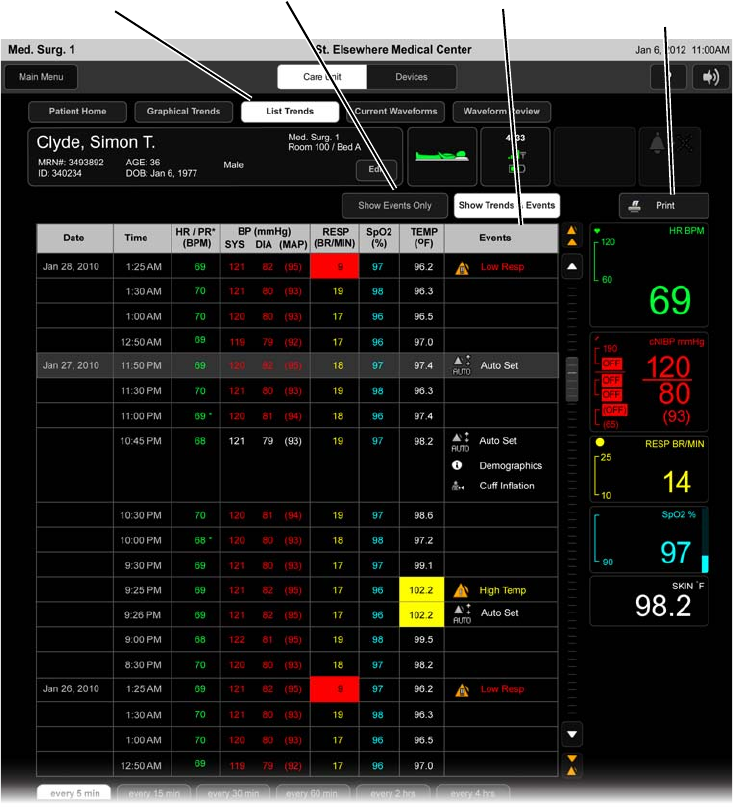
Viewing List Trends
63
To view vital sign trends in tabular format
1. Navigate to the patient’s Patient Home View (for instructions, see Navigating to a Patient Home
View on page 33).
The patient’s Home Page will be displayed in the Work Area.
2. Touch or click the List Trends Tab.
The List Trends View will be displayed in the Work Area.
Note: When monitoring is resumed after an interruption in monitoring (such monitoring paused,
all sensors being disconnected), the list trends view will only display the trend data collected
since the resumption of monitoring until the patient’s identity has been confirmed on the
ViSi Mobile Monitor.
List Trends Events
Tab Display Options Print Report
Viewing List Trends
64
6.3.1 List Trend Features
Trend Displays
There are three different trend displays:
• When “Show Events Only” is selected, the List Trends table will only display a row for each event
occurrence.
• When “Show Trends & Events” is selected, the List Trends table will display a row of vital signs
for each interval time period selected and a row for each event occurrence.
The following events will be displayed within the List Trends table when events are included:
• Start NIBP cuff inflation
• Alarms changed
• Patient demographics changed
• Alarms paused / turned off / resumed
• Monitoring paused
• Monitoring stopped
• All sensors disconnected from the Monitor
The data within the List Trends table may be displayed ascending or descending by date/time. To toggle
between descending/ascending, click the column header for either the date and/or time.
When displaying trends within the List Trends table, the following intervals are available: 5 minutes; 15
minutes; 30 minutes; 60 minutes; 2 hours and 4 hours. Every 30 minutes is the default.
Navigation/Scrolling
Use the scroll bar or arrow keys, to scroll forward or backwards in time to view the trends/events.
Clicking an “alarm” arrow when the next/previous alarm is displayed in the current view, the selection bar
will move to the next/previous alarm. When the next/previous alarm is not displayed in the current view,
the list view will change such that the alarm event will be displayed in the middle row of the List Trend
table.
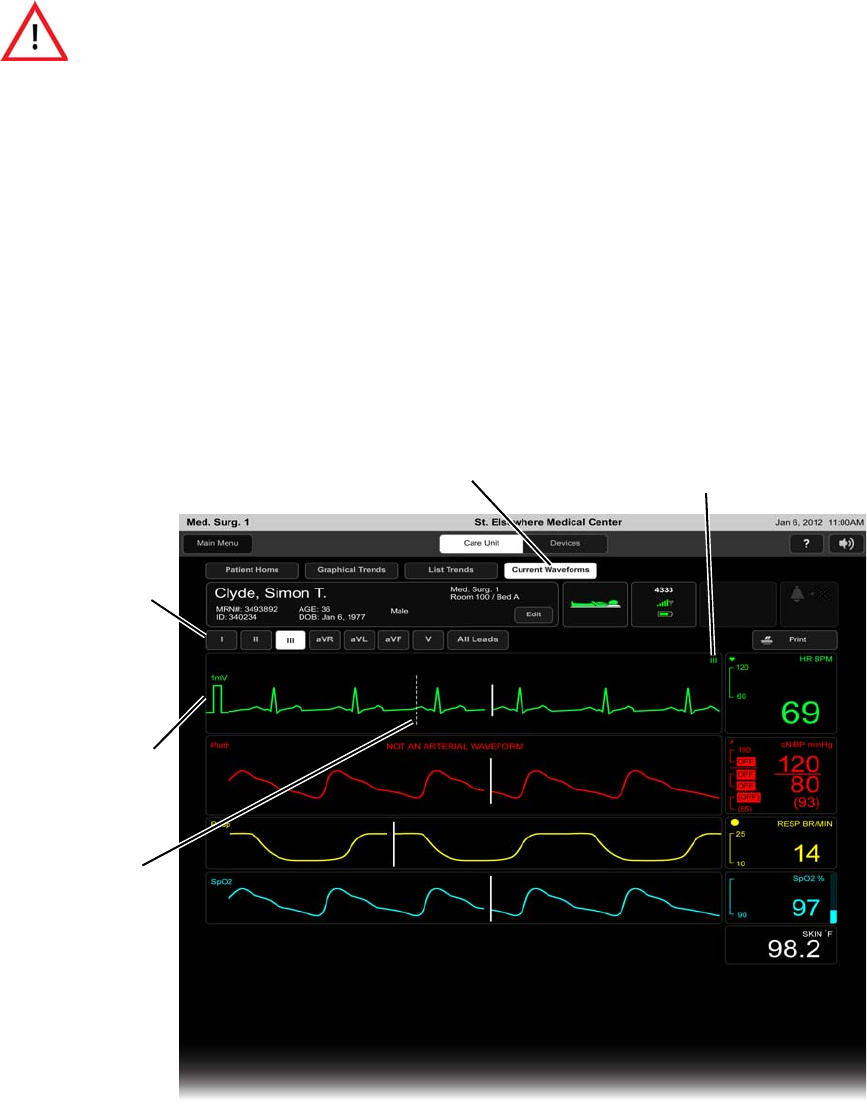
Viewing Current Waveforms
65
6.4 Viewing Current Waveforms
6.4.1 Viewing ECG Waveforms
A patient’s current ECG waveform (generated from one lead) may be viewed.
To view a patient’s current ECG waveform
1. Navigate to the patient’s Patient Home View (for instructions, see Navigating to a Patient Home
View on page 33).
The patient’s Home Page will be displayed in the Work Area.
2. Touch or click the Current Waveforms Tab.
The Current Waveform View will be displayed in the Work Area.
Keep all pacemaker patients under close or constant observation. Pacemaker
signals can differ among pacemakers, ICDs, or CRT devices. The Association for
the Advancement of Medical Instrumentation (AAMI) cautions: “In some devices,
rate meters may continue to count the pacemaker rate during occurrences of
cardiac arrest or some arrhythmias. Do not rely entirely upon rate meter alarms”.
Lead
Voltage
Lead Select
Current Waveforms
Indicator
Buttons
Indicator
Tab
Pacer
Spike
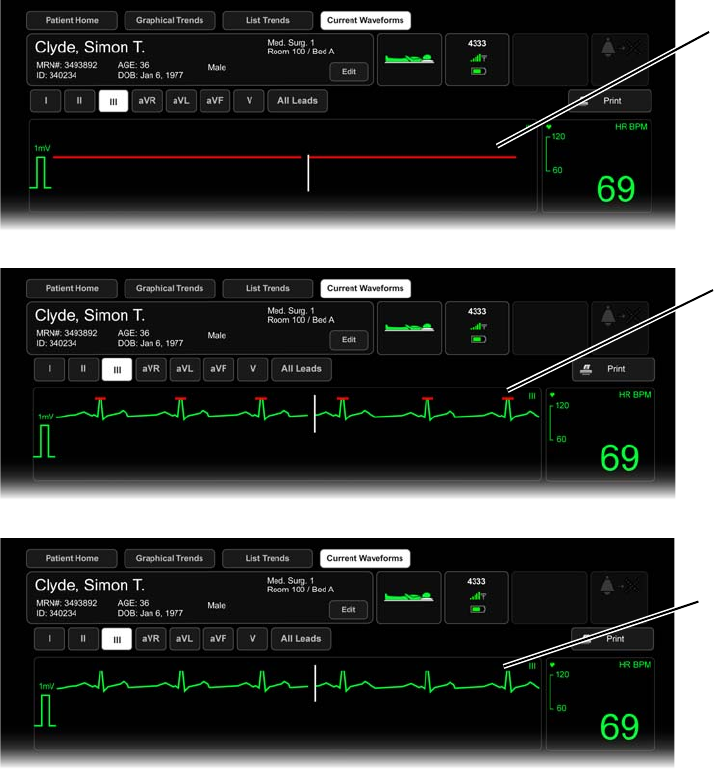
Viewing Current Waveforms
66
3. (Optional) If the patient is monitored with a 5 lead-wire Chest Sensor Cable:
• Touch or click an alternative Lead button to view a waveform derived from a different ECG
lead.
The waveform corresponding to the selected lead button will be displayed.
Input Overload/Dynamic Range
The ViSi Mobile Monitor display indicates an input overload condition (i.e. the input dynamic range of the
amplifier associated with the displayed ECG lead has been exceeded) by displaying the trace in red at the
top (or bottom) of the ECG waveform display area.
Note: When an input overload / dynamic range issue occurs, check the lead fail status.
Amplifier is over-
loaded due to an
the positive limit of
the dynamic range
input that exceeds
on a continuous
basis
Positive limit of
the dynamic range
only at the peaks
of the QRS
is being exceeded
complex of the
ECG waveform
Dynamic range of the
ECG amplifier has not
peaks of the QRS
complex of the ECG
been exceeded. The
waveform extend
beyond the upper edge
of the display area.
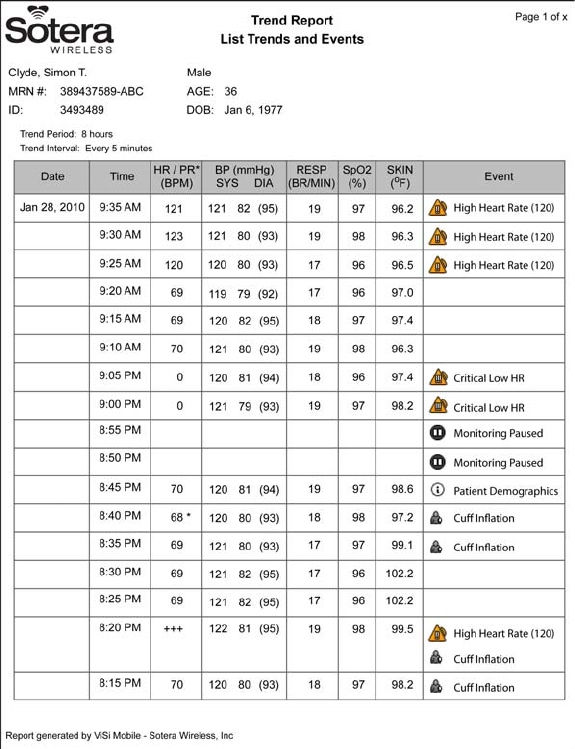
Patient Reports
67
6.5 Patient Reports
Note: The use of a thermal printer is not recommended.
6.5.1 List Trends
To Print the List Trends Report
1. Navigate to the List Trends view (or instructions, see Viewing List Trends on page 62).
The List Trends view will be displayed in the Work Area.
2. Touch or click the Print button.
The list trends report will be printed.
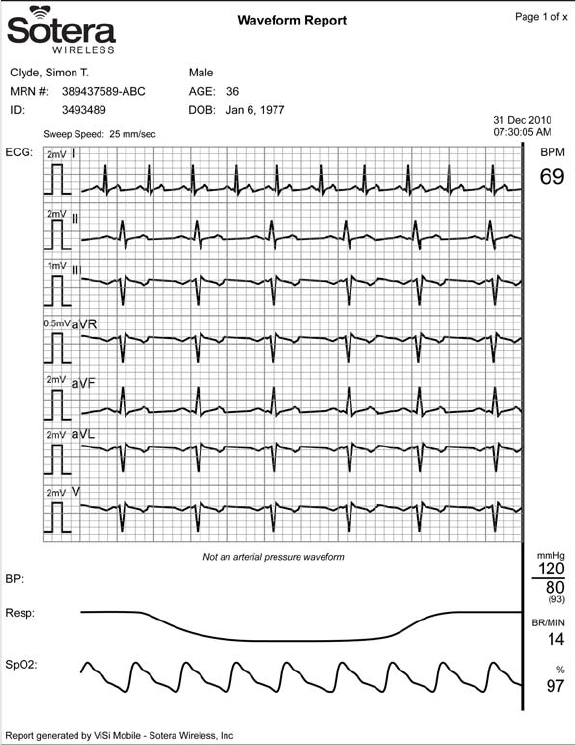
Patient Reports
68
6.5.2 Waveforms
To Print the Waveform Report
1. Navigate to the Current Waveforms view (or instructions, see Viewing Current Waveforms on page
65).
The Current Waveforms view will be displayed in the Work Area.
2. Touch or click the Print button.
The waveforms report will be printed.
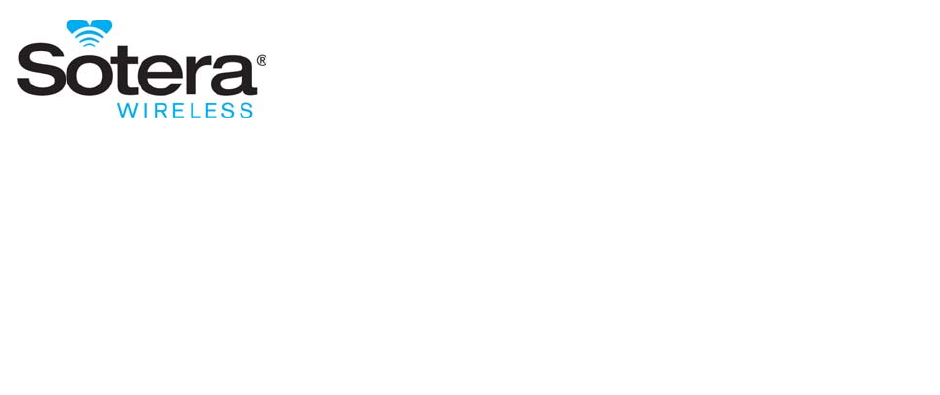
69
7. Alarms
7.1 Introduction
The ViSi Mobile Monitoring System provides a comprehensive alarm system that alarms on changes to the
patient’s physiologic status (alarms) and technical alarms (alerts).
The system provides default alarm limits for physiological alarms. The clinician can manually change the
alarm limits for each patient to provide individualized care.
Note: Changes made to the alarm limits from the ViSi Mobile Remote Viewer do not come into
effect until the ViSi Mobile Monitor has received the change request.
Technical alarms (alerts) are provided to notify the clinician of situations that may impede the ability to
monitor your patient.
7.1.1 System Alarm Management
During the installation of the ViSi Mobile Monitoring System, alarm configurations may be modified to
conform to the alarm policies set by the clinical care unit.
General Alarm Management Rules
The following general alarm management rules pertain to the ViSi Mobile Monitoring System:
• All ViSi Mobile Monitoring System alarms conform to IEC 60601-1-8.
• Alarms and alerts originate from the ViSi Mobile Monitor (worn by the patient).
• Silencing/acknowledging a patient’s alarm or alert suspends the audio tones for up to 2 minutes.
When a new alarm/alert occurs during the 2 minute silenced/acknowledged period, the new alarm/
alert will be immediately annunciated.
Note: When the clinician silences/acknowledges an alarm/alert, all active alarms/alerts in progress
will also be silenced/acknowledged for the 2 minutes. The clinician does not need to silence/
acknowledge each alarm/alert individually.
• Alarm annunciation may be turned off for an indefinite period of time. This disables the
annunciation of alarms and alerts on both the ViSi Mobile Monitor and the Remote Viewer for the
“off” duration. Turning the alarms off must be done directly from the ViSi Mobile Monitor (worn
by the patient), however, alarms may be turned back on from either the ViSi Mobile Monitor or the
Remote Viewer.
• Alarm annunciation may be paused for 2 minutes. This disables the annunciation of alarms and
alerts on both the ViSi Mobile Monitor (worn by the patient) and the Remote Viewer for the
paused duration. Pausing the alarms must be done directly from the ViSi Mobile Monitor (worn by
Introduction
70
the patient), however, alarms may be resumed from either the ViSi Mobile Monitor or the Remote
Viewer.
Note: When the annunciation of alarms/alerts has been turned off or paused, certain important
alarms and alerts will continue to annunciate (known as break-through alarms and alerts).
These are generally equipment alerts that inhibit the ability to monitor the patient
appropriately.
Note: When alarms/alerts are paused, alarms/alerts currently in progress will no longer be
annunciated. The annunciation of any new alarms/alerts will be disabled for the 2 minute
duration.
Note: When alarms/alerts are silenced/acknowledged, the audio tone will be silenced. Any new
alarms/alerts occurring during the 2 minute silenced/acknowledged duration will be
immediately annunciated.
In Network Rules
When the ViSi Mobile Monitor is in network and connected to the ViSi Mobile Remote Viewer:
• When the ViSi Mobile Monitor is connected to the Remote Viewer, the audio alarm and alert tones
will be deferred from the Monitor to the Remote Viewer, for a pre-configured length of time.
Note: Audio tones for life threatening alarms will not be delayed.
• Alarms/alerts may be silenced/acknowledged from either the ViSi Mobile Monitor or Remote
Viewer.
Note: Silencing/acknowledging a life threatening alarm directly from the ViSi Mobile Remote
Viewer will only silence/acknowledge the alarm on the Remote Viewer. To silence/
acknowledge the life threatening alarm on the ViSi Mobile Monitor, the clinician must
silence/acknowledge the alarm directly from the Mobile Monitor (worn by the patient).
• When alarm annunciation has been turned off, alarm annunciation may be turned back on from
either the ViSi Mobile Monitor or Remote Viewer. Turning alarm annunciation off can only be
done directly from the ViSi Mobile Monitor (worn by the patient).
• When alarm annunciation has been temporarily paused, alarm annunciation may be resumed from
either the ViSi Mobile Monitor or Remote Viewer. Pausing alarm annunciation can only be done
directly from the ViSi Mobile Monitor (worn by the patient).
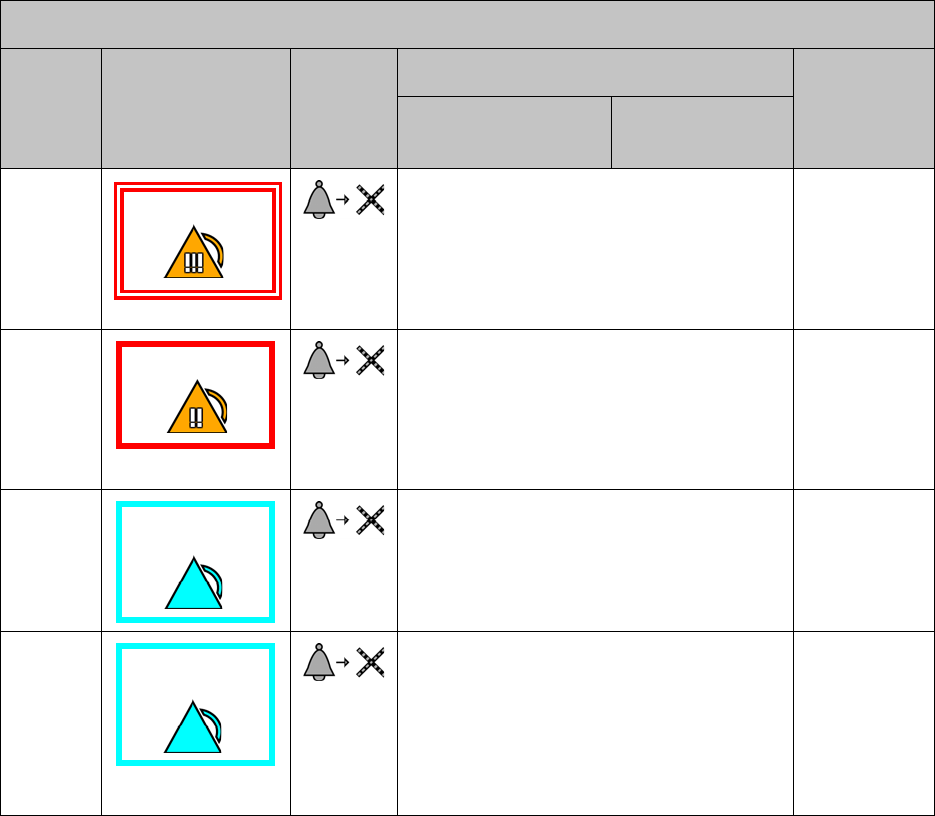
Physiological Alarms (Alarms) / Technical Alarms
71
7.2 Physiological Alarms (Alarms) / Technical Alarms
(Alerts) Summary
7.2.1 Responding to Alarms/Alerts
Silencing Audible Alarms/Alerts from ViSi Mobile Remote Viewer
Priority Type of Alarm Silence
Button
Where to Respond to Alarm
Audio Tones
Remote Viewer
(At Clinician’s Station) Mobile Monitor
(At Patient)
1 Silence at Remote Viewer or Mobile Monitor.
(2 minute audible silenced on both Remote
Viewer and Mobile Monitor.)
Beep
Beep
Beep
- Pause -
Beep
Beep
2 Silence at Remote Viewer or Mobile Monitor.
(2 minute audible silenced on both Remote
Viewer and Mobile Monitor.)
Beep
Beep
Beep
- Pause -
Beep
Beep
3 Silence at Remote Viewer or Mobile Monitor.
(2 minute audible silenced on both Remote
Viewer and Mobile Monitor.)
Beep
Beep
- Pause -
4 Visual Only - No Sound
Acknowledge at the Remote Viewer or Mobile
Monitor.
(Acknowledged for 2 minutes at both the
Remote Viewer and Mobile Monitor.)
No audio
tones.
Life Threatening
High
(High)
Alerts
(Low)
Alerts
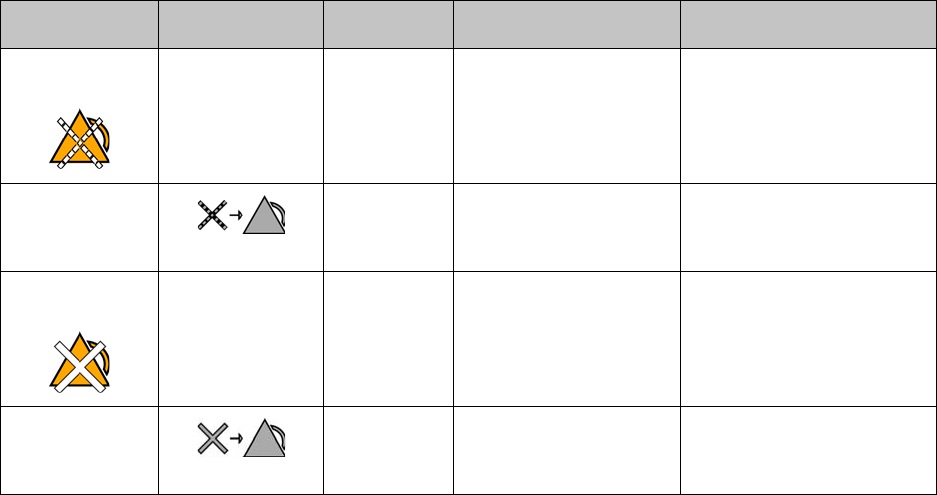
Physiological Alarms (Alarms) / Technical Alarms (Alerts) Summary
72
7.2.2 Managing Alarm/Alert Annunciations
Annunciation: Refers to the audible and visual display of alarms/alerts.
Note: When multiple alarms and alerts occur simultaneously, the message text will only display
messages associated with the highest alarm severity. The vital measurements will display all
existing alarms, regardless of their severity.
Action Action Button Duration Allow Where Effects
Pause Alarms/
Alerts
N/A 2 Minutes May only be paused
from the ViSi Mobile
Monitor.
Annunciation disabled at
both the ViSi Monitor and
Remote Viewer.
Resume Alarms/
Alerts
N/A ViSi Mobile Monitor and
Remote Viewer.
Annunciation resumed at
both the ViSi Mobile
Monitor and Remote Viewer.
Turn Alarms/
Alerts Off
N/A Indefinitely May only be turned off
from the ViSi Mobile
Monitor.
Annunciation disabled at
both the ViSi Monitor and
Remote Viewer.
Turn Alarms/
Alerts On
N/A ViSi Mobile Monitor and
Remote Viewer.
Annunciation turned on at
both the ViSi Mobile
Monitor and Remote Viewer.
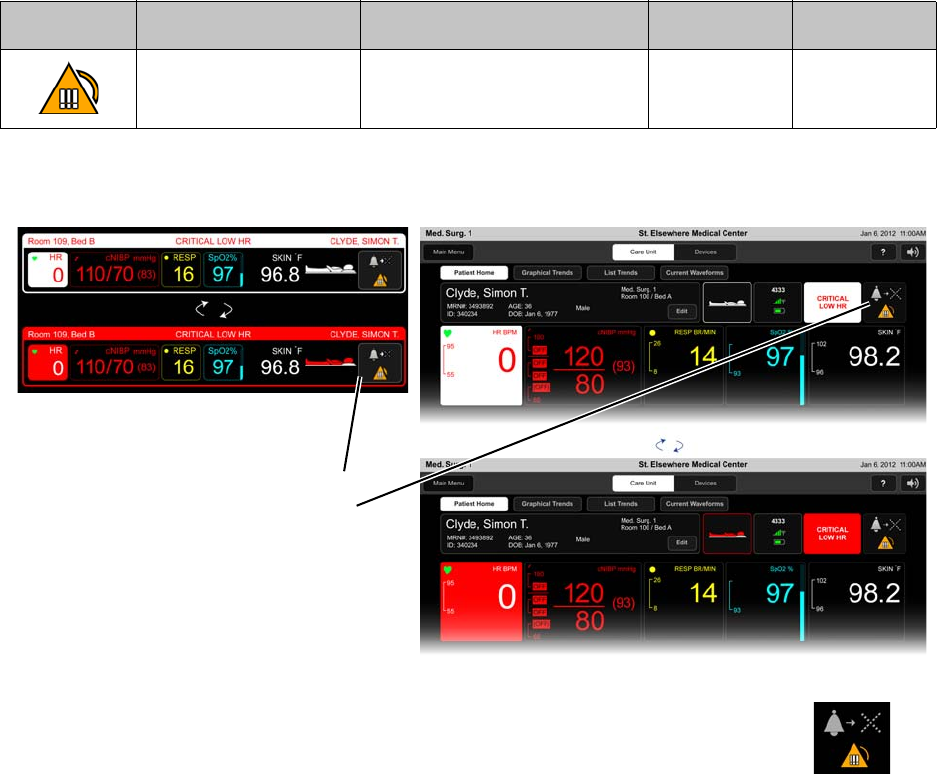
Responding to Physiological Alarms (Alarms)
73
7.3 Responding to Physiological Alarms (Alarms)
7.3.1 To Silence/Acknowledge Life Threatening Severity Alarms
Life threatening severity alarms require urgent clinician response.
To silence/acknowledge the alarm, touch the Silence/Acknowledge Alarm button.
The alarm is silenced/acknowledged and the “Silenced/Acknowledged” symbol and countdown
will be displayed. After the 2 minute countdown has expired, the alarm will be re-annunciated
Symbol Annunciation Color Audio Tone Duration (ms) Spacing (ms)
White / Red BBB P BB P BBB P BB...
B - Beep / P - Pause
100 50
Silence/Acknowledge
Alarm
Detail ViewSummary View
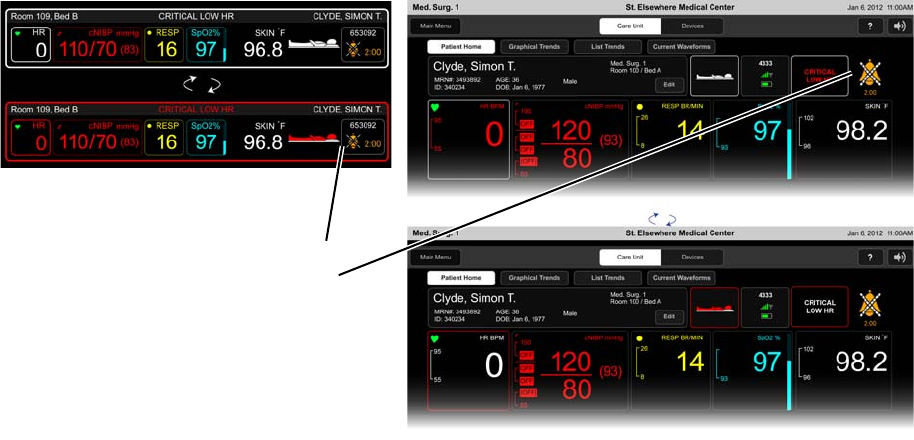
Responding to Physiological Alarms (Alarms)
74
Silenced/Acknowledged
symbol and countdown
Detail ViewSummary View
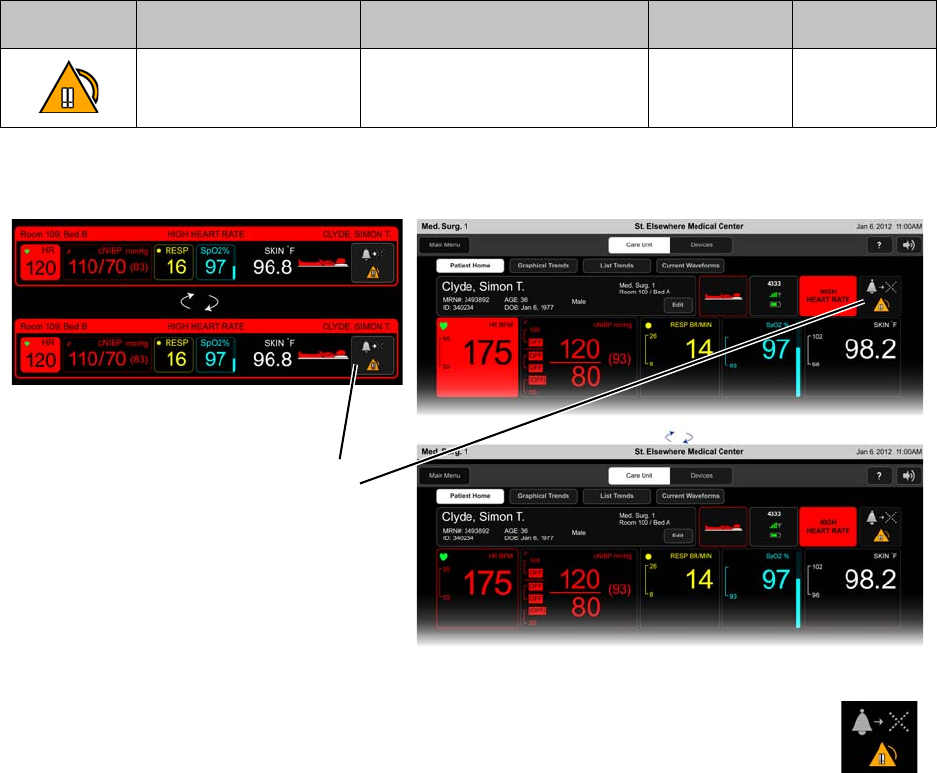
Responding to Physiological Alarms (Alarms)
75
7.3.2 To Silence High Severity Alarms
High severity alarms require immediate clinician response at the bedside.
To silence/acknowledge a high alarm, touch the Silence/Acknowledge Alarm button.
The alarm is silenced/acknowledged and the silenced/acknowledged symbol and countdown will
be displayed.
Symbol Annunciation Color Audio Tone Duration (ms) Spacing (ms)
Red BBB P BB P BBB P BB...
B - Beep / P - Pause
200 100
Silence/Acknowledge
Alarm
Detail ViewSummary View
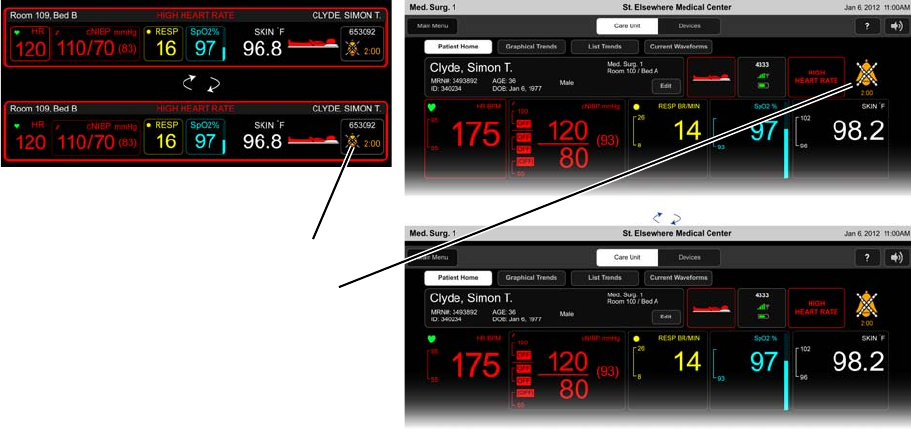
Responding to Physiological Alarms (Alarms)
76
Note: When a high alarm occurs and the alarming condition resolves itself before a clinician is able
to respond, the high alarm message will be displayed (in gray) for up to 5 minutes in the
message area. This serves as a reminder to the clinician that the high alarm has occurred.
Silenced/Acknowledged
symbol and countdown
Detail ViewSummary View
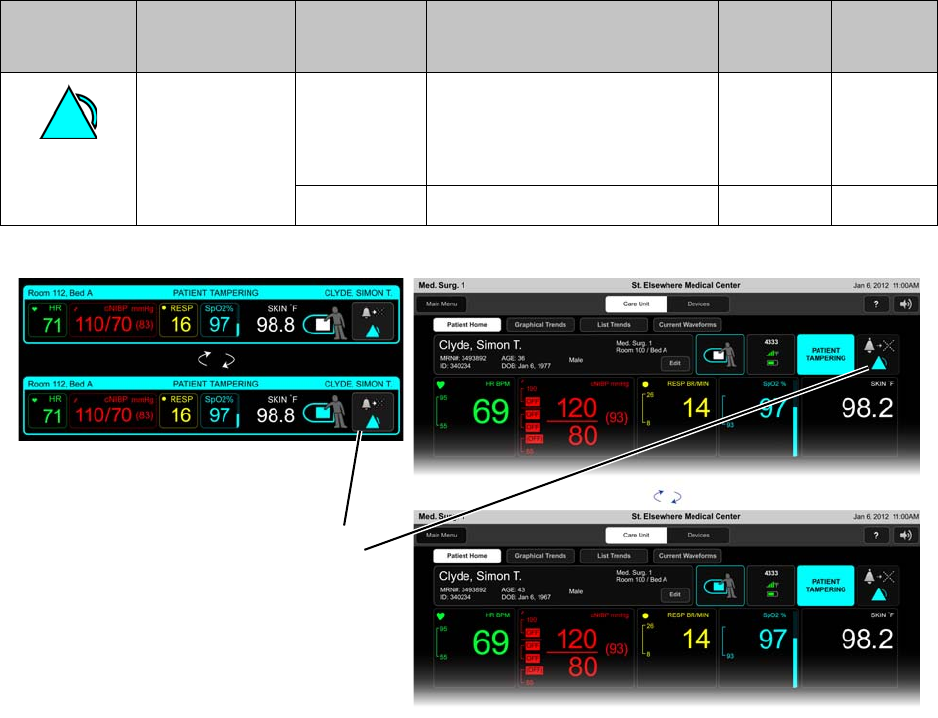
Responding to Equipment Alarms (Alerts)
77
7.4 Responding to Equipment Alarms (Alerts)
7.4.1 To Silence/Acknowledge Alerts (All Severities)
Equipment alerts are used when the ability to monitor the patient and detect a patient’s physiological
alarms may be affected.
Symbol Annunciation
Color Severity Audio Tone Duration
(ms) Spacing
(ms)
Cyan High B B P
B - Beep / P - Pause
There will be a 15 second pause
after each sequence.
250 250
Low No audio tones. N/A N/A
Silence/Acknowledge
Alert
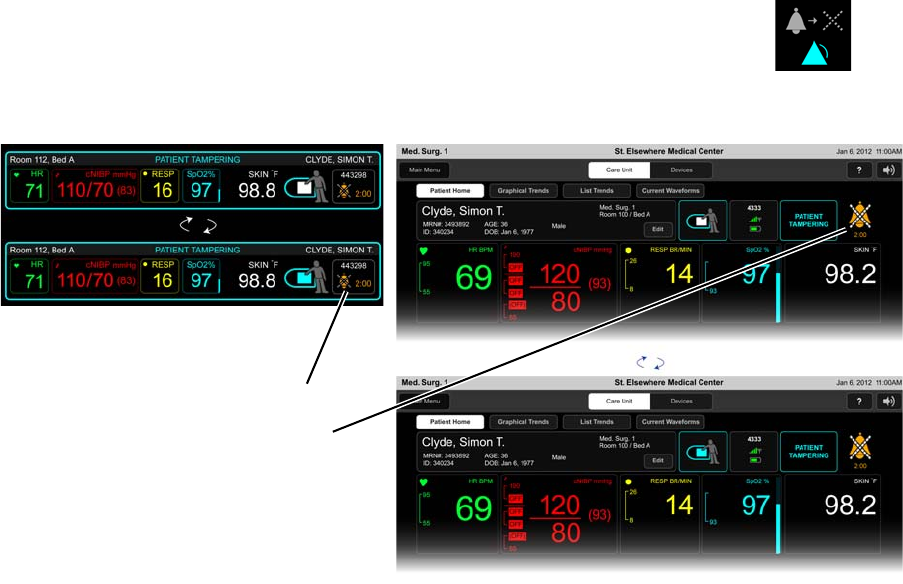
Responding to Equipment Alarms (Alerts)
78
To silence/acknowledge an alert, touch the Silence/Acknowledge Alert button.
The alert is silenced/acknowledged and the silenced/acknowledged symbol and countdown will be
displayed.
Note: When an alert condition (of any severity) resolves itself before a clinician is able to respond,
the alert condition will no longer be annunciated.
Silenced/Acknowledged
symbol and countdown
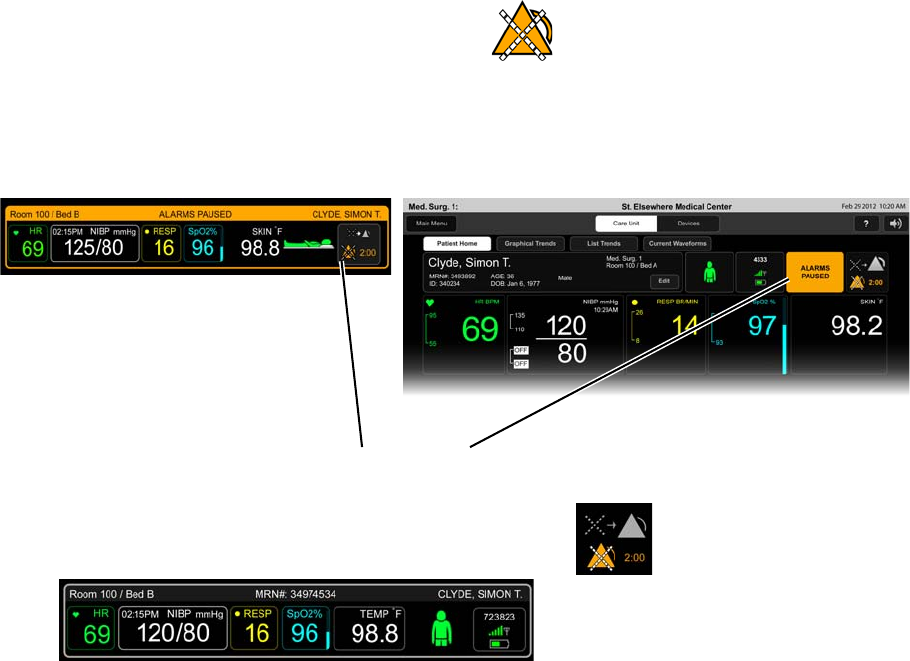
Resume / Turn On Alarm Annunciation
79
7.5 Resume / Turn On Alarm Annunciation
7.5.1 To Resume Alarm Annunciation
When alarms are paused, the annunciation of any existing and new alarm will be disabled at both the ViSi
Mobile Monitor and Remote Viewer. Alarms may be resumed from either Mobile Monitor or Remote
Viewer.
To resume alarm annunciation, touch the Resume button.
Note: Alarm annunciation will resume at both the ViSi Mobile Monitor and Remote Viewer.
Alarms are currently paused.
Rii“P d”dti
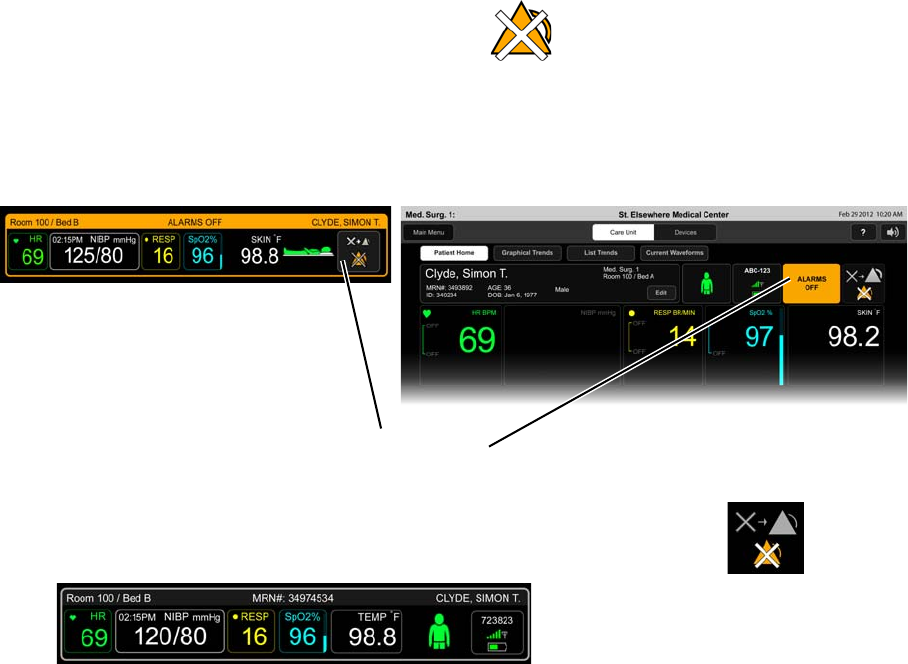
Resume / Turn On Alarm Annunciation
80
7.5.2 To Turn On Alarm Annunciation
When alarms are turned off, the annunciation of any existing and new alarm will be disabled at both the
ViSi Mobile Monitor and Remote Viewer. Alarms may be turned back on directly from the Remote
Viewer.
To turn the alarm annunciation back on, touch the Turn Alarms On button.
Note: Alarm annunciation will be turned on at both the ViSi Mobile Monitor and Remote Viewer.
Alarms are
currently turned off.
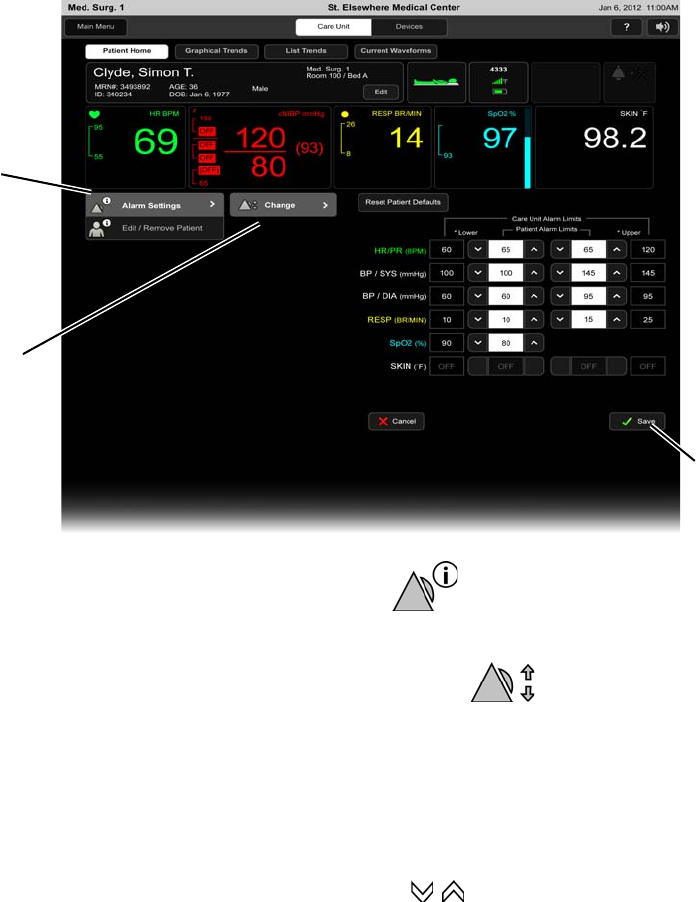
Manage Alarm Limits
81
7.6 Manage Alarm Limits
Alarm limits for the selected patient may adjusted individually or reset back to their factory default values.
7.6.1 To change alarm limits individually
1. Navigate to the patient’s Patient Home View.
The Patient Home View for the selected patient will be displayed. The patient menu is located
directly below the patient’s vital signs.
2. Touch/click the Alarm Settings option from the menu.
The Alarm Settings menu will be displayed to the right of the selected Alarm Settings menu option.
3. Touch/click the Change option from the Alarm Settings menu.
Alarm limits for all sensors currently connected to the ViSi Mobile Monitor will be displayed.
4. Touch/click the data entry box for the alarm limit to be changed.
The cursor will now be placed into the selected alarm limit.
5. Directly type in the new alarm limit using the keyboard.
-or-
Click/touch the up/down arrows to adjust the alarm limit.
The new alarm limit will be displayed.
6. Repeat steps 4 through 6 for all alarm limits to be changed.
Save
Alarm Settings
Change
Menu Option
Menu Option

Manage Alarm Limits
82
7. Touch Save to save the new alarm limits.
The new alarm limits will be communicated to the ViSi Mobile Monitor and will become active
immediately. If the alarm limits are not communicated to the Monitor, a message will be displayed
on the ViSi Mobile Remote Viewer.
-or-
Touch Cancel to return to close the current view.
Any modifications to the alarm limits will be discarded.
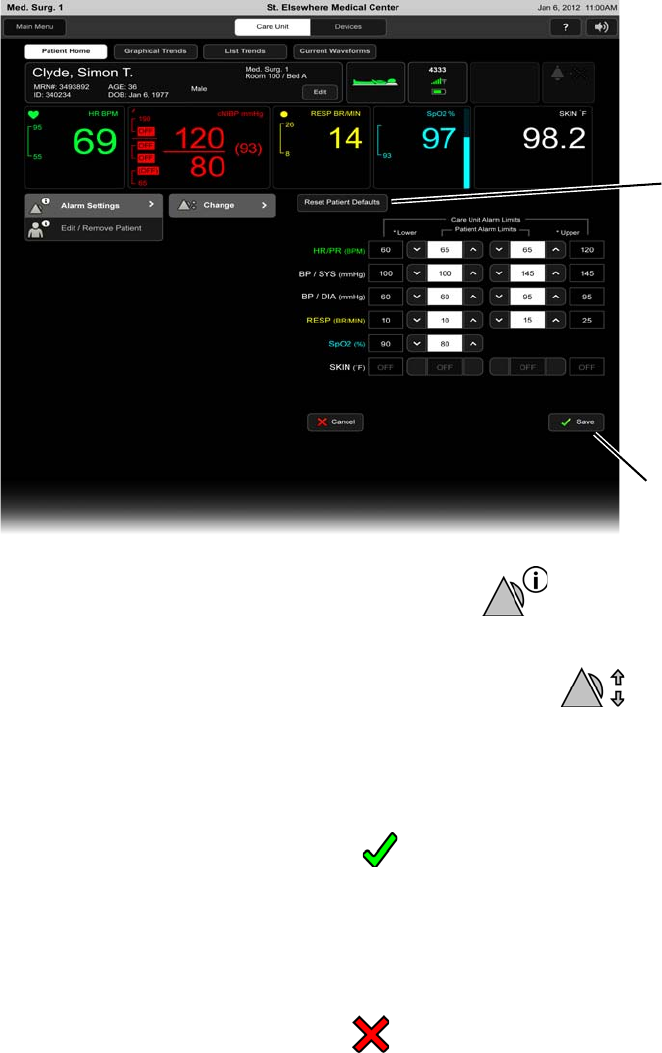
Manage Alarm Limits
83
7.6.2 To reset alarm limits to default values
1. Navigate to the patient’s Patient Home View.
The Patient Home View for the selected patient will be displayed. The patient menu is located
directly below the patient’s vital signs.
2. Touch/click the Alarm Settings option from the menu.
The Alarm Settings menu will be displayed to the right of the selected Alarm Settings menu option.
3. Touch/click the Change option from the Alarm Settings menu.
Alarm limits for all sensors currently connected to the ViSi Mobile Monitor will be displayed.
4. Touch/click the Reset Patient Defaults button.
The new alarm limit will be displayed.
5. Touch Save to save the new alarm limits.
The new alarm limits will be communicated to the ViSi Mobile Monitor and will become active
immediately. If the alarm limits are not communicated to the Monitor, a message will be displayed
on the ViSi Mobile Remote Viewer.
-or-
Touch Cancel to close the current view.
Any modifications to the alarm limits will be discarded.
Save
Reset
Button
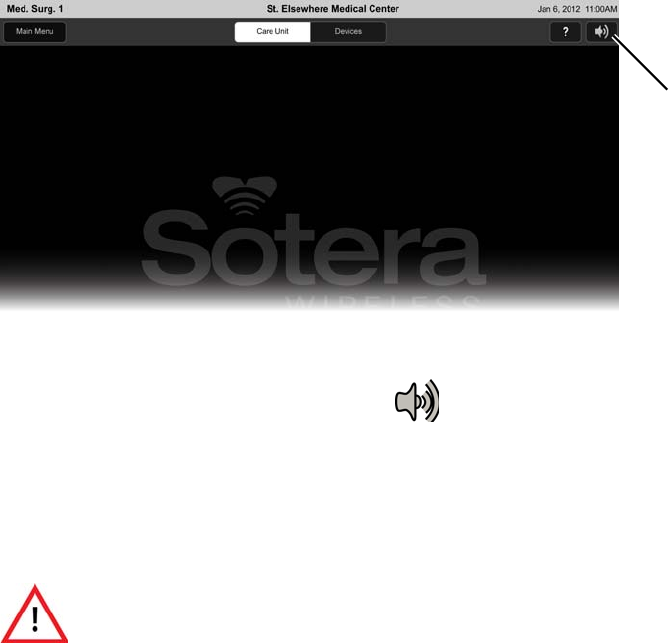
ViSi Mobile Remote Viewer Audio Test
84
7.7 ViSi Mobile Remote Viewer Audio Test
7.7.1 To test the ViSi Mobile Remote Viewer Speaker
Test the ViSi Mobile Remote Viewer speaker to determine if audio tones sound at the Remote Viewer and
how loud they are.
Touch/click the Speaker Test button.
An audio tone will start to play and the speaker icon on the Speaker Test button will animate.
Click/touch the Speaker Test button to stop the speaker test.
When testing the speaker at the ViSi Mobile Remote Viewer, if the tone
does not sound or it is not loud enough check the speaker volume is turned
up. If the sound is still not sound loud enough, immediately contact a
biomedical engineer. The test indicates how alarm and alert tones sound at
the Remote Viewer. If the volume is inadequate, clinicians could miss
alarms and alerts.
Speaker Test
Button
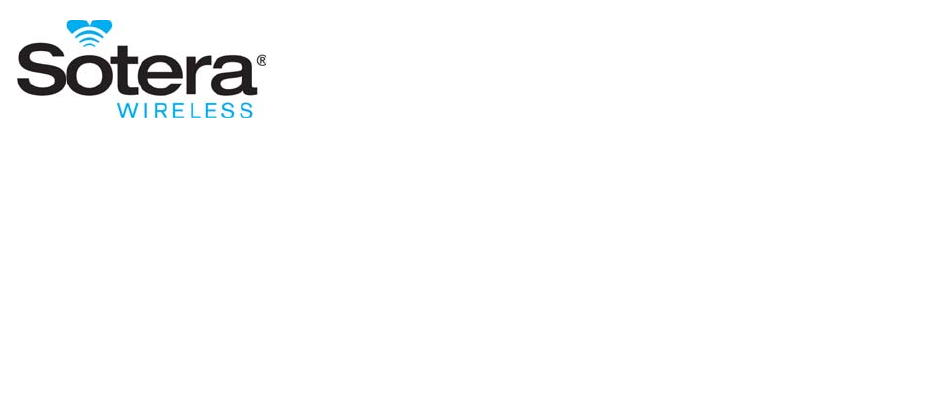
85
8. Pause / Stop Monitoring
8.1 Pause Monitoring
When monitoring is paused on the ViSi Mobile Monitor, the corresponding Patient Tile on the ViSi Mobile
Remote Viewer will display an acknowledged MONITORING PAUSED alert the time at which
monitoring was paused. If monitoring of the patient is not going to be resumed, monitoring may be
stopped by removing the patient from the Remote Viewer using the Remove Patient workflow, outlined
below.
For information on how to Pause Monitoring on the ViSi Mobile Monitor, see the ViSi Mobile Monitor
User Manual.
Note: It is not possible to stop monitoring directly from the ViSi Mobile Monitor after monitoring
has been paused.
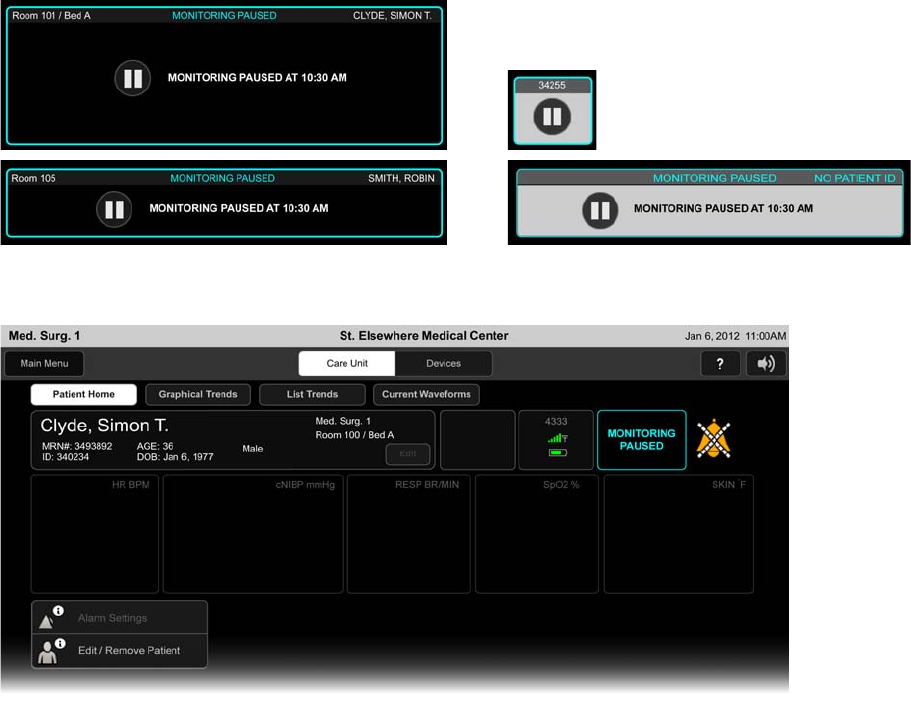
Pause Monitoring
86
Patients tiles with assigned locations Patients tiles with no assigned location
Patient Home View
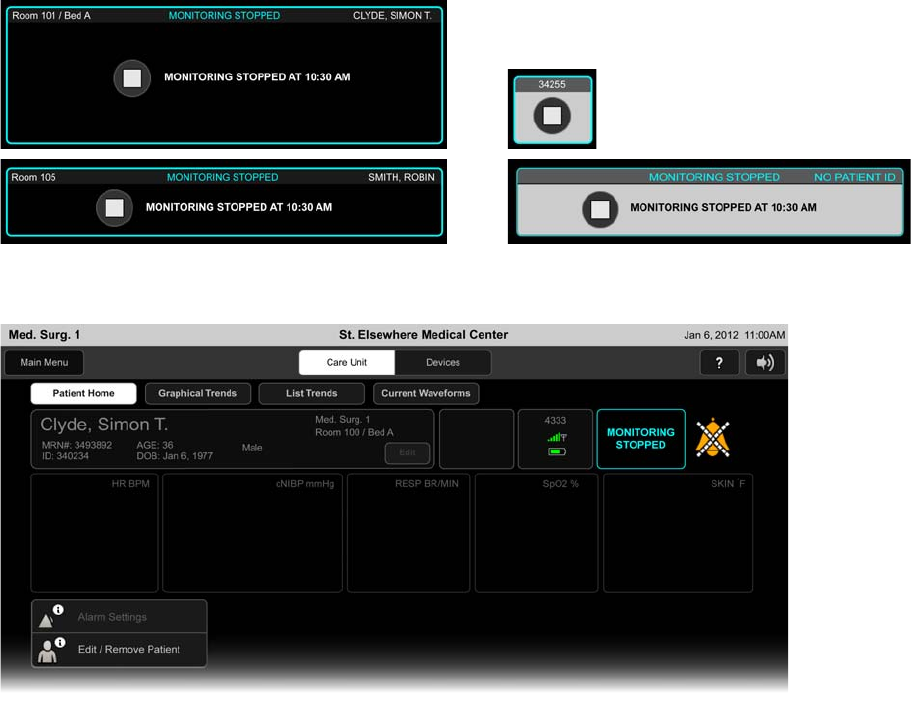
Stop Monitoring
87
8.2 Stop Monitoring
When monitoring is stopped on the ViSi Mobile Monitor, the corresponding Patient Tile on the ViSi
Mobile Remote Viewer will display an acknowledged MONITORING STOPPED alert and the time at
which monitoring was stopped. To remove the patient from the Remote Viewer and complete the “stop”
process, follow the Remove Patient workflow, outlined below.
For information on how to Stop Monitoring on the ViSi Mobile Monitor, see the ViSi Mobile Monitor User
Manual.
Patients tiles with assigned locations Patients tiles with no assigned location
Patient Home View
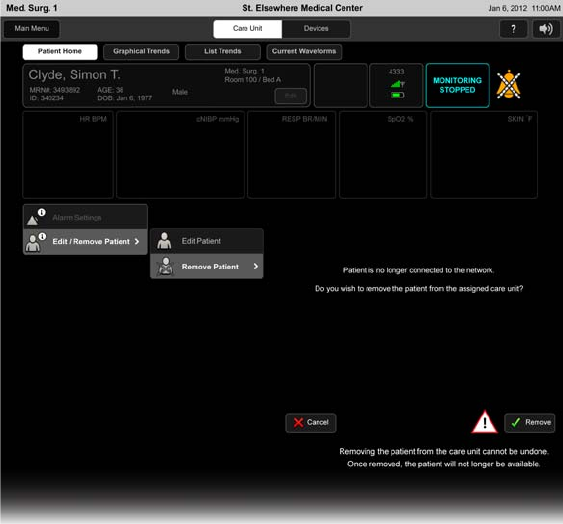
Removing Patients from the Care Unit
88
8.3 Removing Patients from the Care Unit
Remove Patient will be enabled for the selected patient when one of the following has occurred:
• Monitoring has been stopped
• Monitoring has been paused
• The patient’s monitor is not currently connected to the network.
To remove the patient (and their information) from the ViSi Mobile Remote Viewer, use the “Remove”
feature.
8.3.1 To remove a patient from the Care Unit View
1. If the patient is not already selected, select the patient from the Care Unit view. See “Work Area”
on page 27.
2. Touch or click the Edit / Remove Patient menu option.
The second level menu associated with the Edit / Remove Patient menu will be displayed to the
right of the Edit / Remove Patient menu.
3. Touch or click the Remove Patient menu option.
The Remove Patient view will be displayed.

Removing Patients from the Care Unit
89
4. Touch or click Remove to remove the patient from the care unit.
-or -
Touch or click Cancel.
If cancelled, the patient will continue to be displayed in the Care Unit Area.
If the removal is confirmed, the patient will be removed from the Care Unit.
After monitoring has been stopped on the ViSi Mobile Monitor, removing the
patient from the ViSi Mobile Remote Viewer cannot be undone. Once
removed, the patient will no longer be available on the Remote Viewer.
Removing Patients from the Care Unit
90
- Notes -
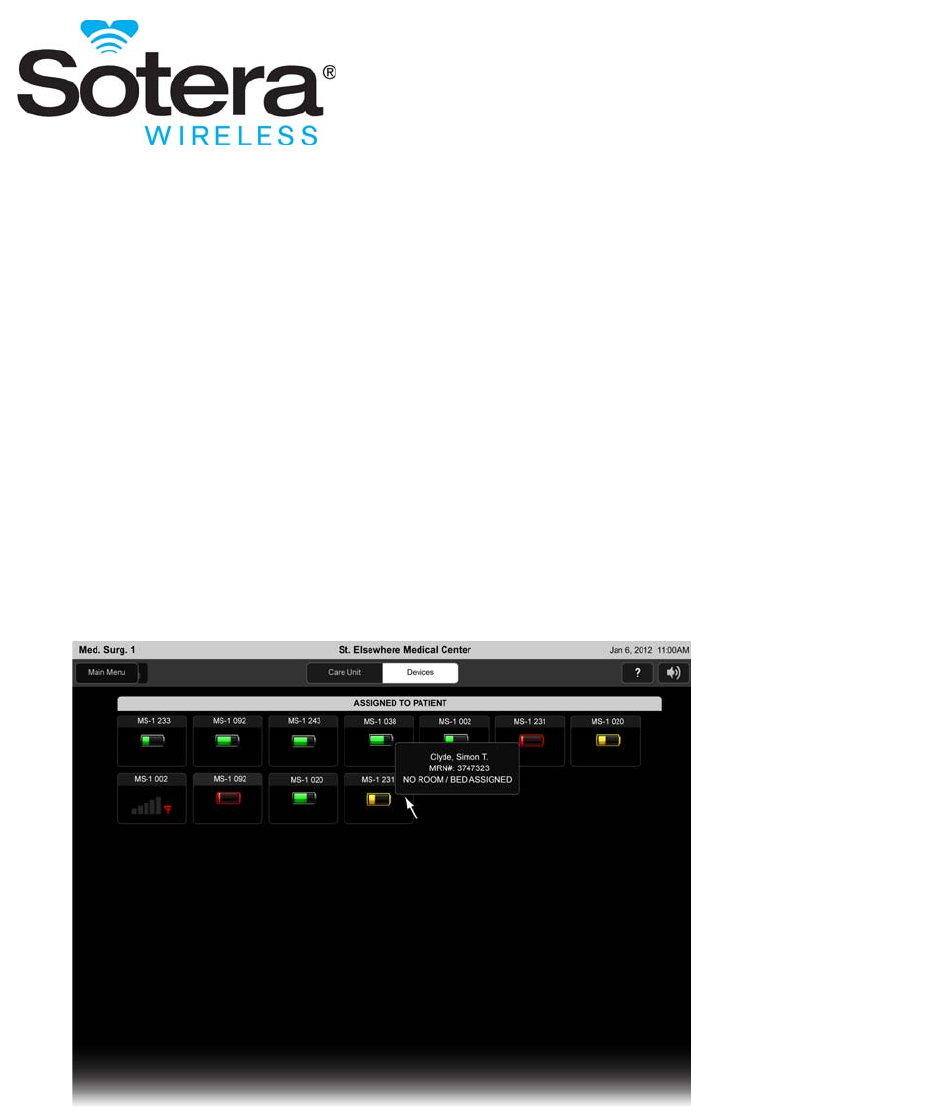
91
9. Care Unit Views
9.1 Care Unit Devices
The Care Unit Devices view allows the clinician to see all the ViSi Mobile Monitors currently in use by
patients. The screen provides a view of the battery state for each Monitor.
To view the ViSi Mobile Monitors currently in use
Touch or click on the Devices Tab in the System Menu.
The Care Unit Devices view will be displayed in the Work Area.
Note: Hovering the mouse over any of the Devices boxes will display the patient’s primary ID,
secondary ID and their assigned location. See image above.
Care Unit Devices
92
- Notes -
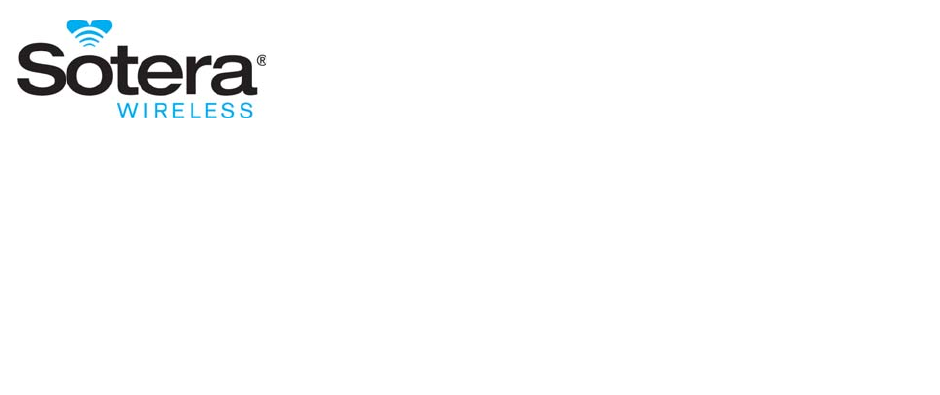
93
10. Troubleshooting
10.1 Introduction
The ViSi Mobile Monitoring System is designed to alert the clinician to technical issues that may occur
while monitoring a patient’s vital signs.
The following tables provide troubleshooting solutions to potential problems that may be encountered
while monitoring a patient.
10.1.1 Customer Support
Toll-Free: +1-866-232-6126
International: +1-858-427-4620
Fax: +1-858-427-4639
E-mail: support@soterawireless.com

ViSi Mobile Monitor
94
10.2 ViSi Mobile Monitor
10.2.1 Screen Access
Problem Potential Cause Solution
The screen is blank The display is in Quiet
Monitoring Mode.
Touch the screen with one finger for two
seconds to activate display.
Plug in a sensor to initiate monitoring.
The display is in Hibernation
Mode.
Plug in a sensor to initiate monitoring.
The battery charge is too low. Disconnect all sensors from the Monitor,
clean the Monitor, and place it in the
Charger.
Sensors won’t plug into the
Monitor
Plug is oriented with the
connector contacts facing
downwards.
Orient the Plug so that the connector
contacts are facing upwards.
Trying to Plug into wrong end of
the Monitor.
Only the Thumb Sensor is designed to be
Plugged into the rounded end of the
Monitor. All other sensors can be Plugged
into any port on the flat end of the
Monitor.
Monitor is not seated in the
cradle correctly.
Ensure the Monitor is pushed all the way
into the cradle and secure with either the
Thumb Sensor or Locking Plug.
Problem Potential Cause Solution
No response to touching any
buttons
Touching the screen with more
than one finger.
Touch the button with only a single
finger.
Button is not an active button. Active buttons are those with borders, and
are not dimmed in appearance compared
to other buttons.
Touching the screen with a pen
or stylus.
Note: May cause damage
to the touch screen.
Touch the button with only a single
finger.
Cannot access the Vital Signs
screen
Screen is locked. Touch the Unlock button and enter the
correct PIN.
Access denied due to entering
the wrong PIN code.
Enter the correct PIN code.

ViSi Mobile Chest Sensor Cable
95
10.3 ViSi Mobile Chest Sensor Cable
Patient has accessed the
monitoring functions
Screen was not locked after last
clinician interaction.
• Once all interactions are complete,
make sure to lock the screen.
• Remind the patient that this is a med-
ical device, and that tampering may
result in missing important clinical
events.
Patient guessed PIN correctly. • Define appropriate PIN codes (not
0000 for example).
• Remind the patient that this is a med-
ical device, and that tampering may
result in missing important clinical
events.
Problem Potential Cause Solution
Chest Sensor Cable is too short
to plug into the Monitor
Monitor is oriented in the wrong
direction.
Make sure that the flat end of the Monitor
is oriented towards the elbow.
The Chest Sensor Cable is
secured to the side of the chest
opposite the arm with the
Monitor.
Secure the Chest Sensor Cable midway
between the sternum and the shoulder of
the same arm that the Monitor is on.
The Chest Sensor Module has
been put on upside down.
Rotate the Chest Sensor Module 180o
such that the analog cable is facing
upwards from the top of the Chest Sensor
Module and the digital cables are facing
downwards.
No HR numeric ECG electrodes not connected to
lead-wires.
Ensure that the lead-wires are snapped
securely onto the ECG electrodes.
ECG electrodes not firmly
attached to the patient’s chest.
Ensure that the ECG electrodes are
securely attached to the chest; ECG
electrode sites are clean and free of excess
hair.
ECG electrode gel is dry. Replace ECG electrodes.
Broken/damaged lead-wires. Replace damaged Chest Sensor Cable.
Chest Sensor Cable not securely
Plugged into the Monitor.
Make sure that the Chest Sensor Cable is
securely Plugged into the Monitor.
HR displays “XX” A lead-wire or sensor problem is
affecting the measurement.
If the problem persists, replace the ECG
electrodes and/or Chest Sensor Cable.
Problem Potential Cause Solution

ViSi Mobile Chest Sensor Cable
96
HR is erratic ECG electrodes are not all the
same.
Use all the same ECG electrode type,
size, materials, and manufacturer.
ECG electrode gel is dry. Replace ECG electrodes.
ECG electrodes not firmly
attached to the patient’s chest.
Check the ECG electrodes are securely
attached to the chest; ECG electrode sites
are clean and free of excess hair.
Skin is not prepared correctly. See instructions for skin preparation.
No ECG waveform See No HR numeric above. See No HR numeric above.
ECG waveform too small Using a 3-lead Chest Sensor
Cable:
Lead II has a low amplitude.
Lead II only available with a 3-
lead Chest Sensor Cable.
• Select alternate ECG electrode sites;
prepare skin sites; connect lead-wires
to new ECG electrodes and place on
the chest.
• Replace 3-lead Chest Sensor Cable
with 5-lead Chest Sensor Cable.
Using a 5-lead Chest Sensor
Cable: Selected lead has low
amplitude.
5-lead Chest Sensor Cable: select a
different lead to view.
ECG waveform is noisy; looks
like pacer indicators in the
waveform
ECG electrodes not firmly
attached to the patient’s chest.
Ensure that the ECG electrodes are
securely attached to the chest; ECG
electrode sites are clean and free of excess
hair.
ECG electrode gel is dry. Replace ECG electrodes.
Skin is not prepared correctly. See instructions for skin preparation.
No RESP numeric See No HR numeric above. See No HR numeric above.
The Monitor is not capable of
measuring RESP.
Contact your biomedical engineer.
RESP displays “XX” A lead-wire or sensor problem is
affecting the measurement.
If the problem persists, replace the ECG
electrodes and/or Chest Sensor Cable.
RESP is erratic ECG electrodes not firmly
attached to the patient’s chest.
Ensure that the ECG electrodes are
securely attached to the chest; ECG
electrode sites are clean and free of excess
hair.
ECG electrode gel is dry. Replace ECG electrodes.
Problem Potential Cause Solution

ViSi Mobile Chest Sensor Cable
97
No SKIN temperature numeric The Chest Module sensor is
placed on the patient with the
Temperature Sensor facing away
from the patient.
Place the Chest Module sensor on the
patient such that the Temperature Sensor
is in direct contact with the patient’s
chest.
Sensor is not attached to the
patient’s chest.
Secure the Chest Sensor Cable to the
chest. Make sure that a change in position
does not affect the sensor’s contact with
the skin.
SKIN temperature displays
“XX”
The Temperature Sensor may
have failed.
If the problem persists, replace the Chest
Sensor Cable.
SKIN temperature is erratic Chest Sensor Cable is not in
contact with the skin completely/
securely.
Secure the Chest Sensor Cable to the
chest. Make sure that a change in position
does not affect the sensor’s contact with
the skin.
Skin is not clean and dry. Clean and dry the skin thoroughly and
secure the Chest Sensor Cable to the
chest.
Problem Potential Cause Solution

ViSi Mobile Thumb Sensor
98
10.4 ViSi Mobile Thumb Sensor
Problem Potential Cause Solution
Sensor cable too short to Plug
into Monitor
Monitor is oriented in the wrong
direction.
Make sure that the rounded end of the
Monitor is oriented towards the hand.
Thumb sensor is routed wrong. Make sure the cable is routed around the
outside of the thumb.
No SpO2 numeric Broken/damaged Thumb Sensor. Replace the Thumb Sensor
Something is blocking the optics
or detector in the Thumb Sensor.
Make sure nothing is blocking the optics
or detector.
Thumb Sensor not secured in the
Thumb Sensor Cradle.
Place the Thumb Sensor securely in the
Thumb Sensor cradle.
Thumb Sensor not secured to the
base of the thumb.
Secure the Thumb Sensor to the base of
the thumb.
Thumb Sensor not securely
Plugged into the Monitor.
Make sure that the Thumb Sensor is
securely Plugged into the Monitor.
SpO2 displays “XX” A sensor problem is affecting the
measurement.
If the problem persists, replace the
Thumb Sensor.
SpO2 is erratic Something is partially blocking
the optics or detector in the
Thumb Sensor.
Make sure nothing is blocking the optics
or detector.
Thumb Sensor not secured to the
base of the thumb.
Secure the Thumb Sensor to the base of
the thumb.
Thumb Sensor is not in the
correct location.
Reorient the Thumb Sensor at the base of
the thumb and secure with the Thumb
Wrap.
Thumb Strap is too tight. Loosen the Thumb Strap making sure that
it is still secure.

ViSi Mobile Cuff Module
99
10.5 ViSi Mobile Cuff Module
Problem Potential Cause Solution
Cuff Module cable is too short to
Plug into Monitor
Monitor is oriented in the wrong
direction.
Make sure that the flat end of the Monitor
is oriented towards the arm.
Cuff Module is on the arm
opposite the Monitor.
Place the Cuff Module on the same arm
that the Monitor is on.
No NIBP measurement Battery charge is too low. Replace the Cuff Module.
Cuff Module not Plugged
securely into the Monitor.
Make sure that the Cuff Module is
Plugged securely into the Monitor.
Not set up for automatic
measurements.
From the NIBP Settings screen, select an
automatic interval.
The time from the last
measurement exceeds the period
of time to display a
measurement.
Initiate a measurement from the Vital
Signs screen.
Disposable Cuff was touched
during inflation.
Avoid touching the ViSi Mobile
Disposable Cuff during inflation as this
may disrupt the measurement.
Disposable Cuff not placed
correctly.
Ensure Disposable Cuff is placed onto the
patient’s arm correctly. Line up the
arterial line as indicated on the
Disposable Cuff.
NIBP measurement doesn’t
match an auscultatory
measurement
Measurements were not taken at
the same time.
Measurements are taken at the same time.
Measurements were taken on
different arms.
The BP in both arms is the same,
sometimes there is a difference between
arms.
Different size cuffs were used. Ensure the BP cuff size is the same on
both arms, and the correct size for the
arm.
Both arms were not at the same
level when the BP was
measured.
The arms are positioned at the same level
relative to the heart.
Disposable cuff was touched
during inflation.
Avoid touching the ViSi Mobile
Disposable Cuff during inflation as this
may disrupt the measurement.

ViSi Mobile Cuff Module
100
Blood pressure mode set to
continuous NIBP but only one
NIBP measurement taken.
The patient’s PATis not stable. Ensure the patient is still before
calibration is started and remains still
during the calibration process.
Note: When the patient’s PAT is
stable, the “c” on the
Calibrate cNIBP button will
be displayed in red. When
PAT is not stable, the “c”
will be displayed in gray.
LED on Cuff Module displays
red when in the Charger.
Voltage level has exceeded
expectation.
• Remove Cuff Module from the Char-
ger.
• Report the problem to Sotera Wire-
less Inc. Customer Service Depart-
ment or the Sotera Wireless
representative in your area.
Current level has exceeded
expectation.
• Remove Cuff Module from the Char-
ger.
• Report the problem to Sotera Wire-
less Inc. Customer Service Depart-
ment or the Sotera Wireless
representative in your area.
Over temperature protection
current temperature has
exceeded expectation.
• Remove Cuff Module from the Char-
ger.
• Report the problem to Sotera Wire-
less Inc. Customer Service Depart-
ment or the Sotera Wireless
representative in your area.
Problem Potential Cause Solution

ViSi Mobile Battery Charger
101
10.6 ViSi Mobile Battery Charger
Problem Potential Cause Solution
Batteries in the Monitor and
Cuff Module do not charge
The Monitor and Cuff Module
are not securely seated in the
Charger.
Make sure that the Monitor and Cuff
Module are securely seated in the
Charger.
The monitor and Cuff Module are
designed to fit into the Charger in one
direction.
The Charger is not completely
Plugged in to the wall socket.
• Make sure that the Plug is securely
Plugged into an active wall socket
and there is a green light on the Bat-
tery Charger.
• Make sure that the power cord is not
damaged.
AC Adapter is not Plugged into
the Charger.
• Plug the AC Adaptor into the Char-
ger.
The Monitor and/or Cuff Module
were insterted into the Charger
without being thoroughly dried
(after cleaning/disinfecting).
• Dry equipment thoroughly before
placing in the Charger.
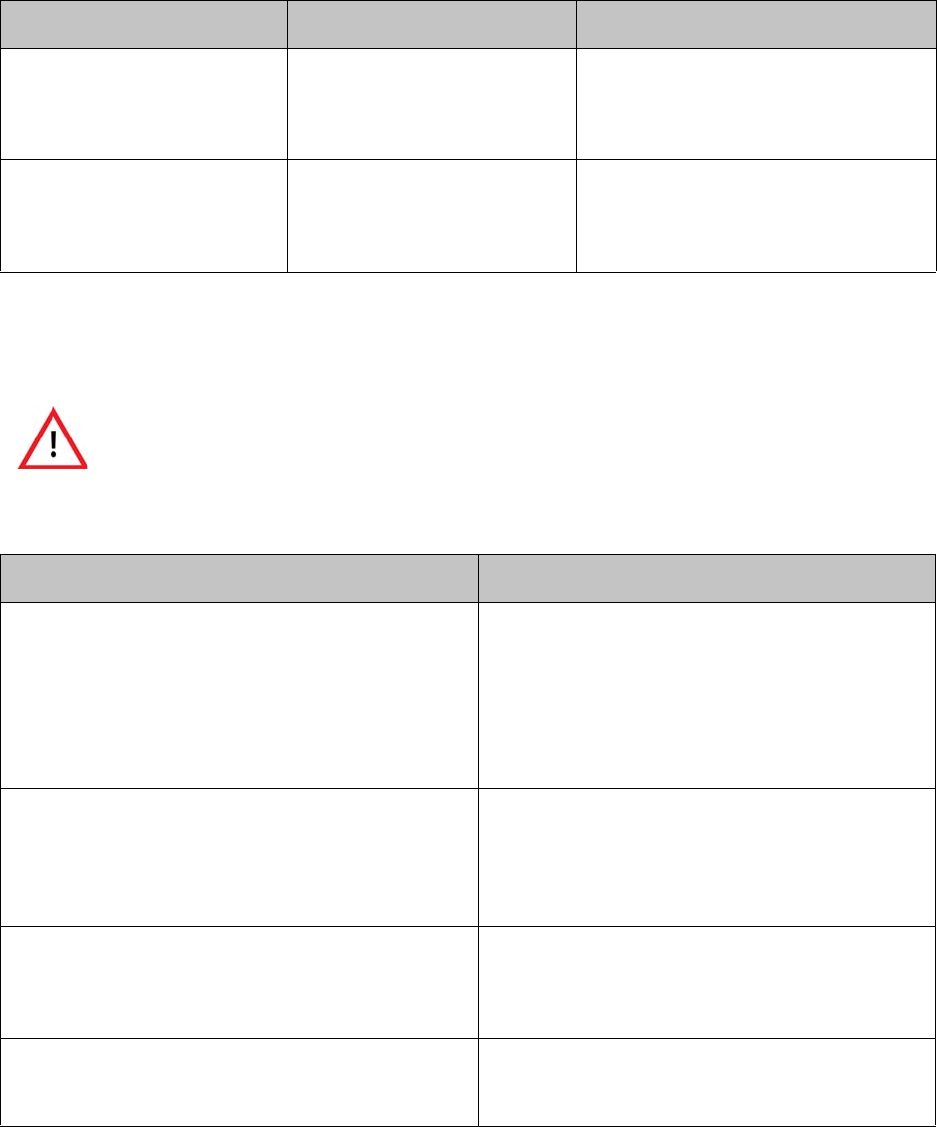
General Troubleshooting
102
10.7 General Troubleshooting
10.7.1 Connectivity Lost
10.7.2 Alarms and Alerts
Problem Potential Cause Solution
On the ViSi Mobile Remote
Viewer, “XX” appears where all
vital sign measurements should
be displayed.
The patient wearing the ViSi
Mobile Monitor has moved
outside of the wireless network
area.
Move the patient back into the wireless
network area.
On the ViSi Mobile Remote
Viewer, all patients have
disappeared from the Care Unit
Area.
The network cable has been
disconnected from the ViSi
Mobile Remote Viewer.
Reconnect the network cable to the
Remote Viewer.
When testing the speaker at the ViSi Mobile Remote Viewer, if the tone
does not sound or it is not loud enough check the speaker volume is turned
up. If the sound is still not sound loud enough, immediately contact a
biomedical engineer. The test indicates how alarm and alert tones sound at
the Remote Viewer. If the volume is inadequate, clinicians could miss
alarms and alerts.
Problem Explanation
I acknowledge an alarm at the ViSi Mobile Remote
Viewer, but the audio tone still occurs at the ViSi Mobile
Monitor.
• Life-Threatening alarms latch at the ViSi Mobile
Monitor until they are acknowledged there, even
if the alarm condition resolves.
• Certain alerts (such as a sensor being discon-
nected) continue to annunciate at the ViSi Mobile
Monitor until the alert is acknowledged at the
Monitor.
An alarm occurs, but the audio tone stops before I
acknowledge it.
• If an alarm or alert condition resolves before it is
acknowledged, the audio tones stops.
• If the alarm condition was a high-level severity,
the alarm message will remain visible (in gray)
for five minutes.
I stop monitoring a patient at the ViSi Mobile Monitor,
according to procedure, but a MONITOR STOPPED
alert still appears on the ViSi Mobile Remote Viewer.
The alert informs all clinicians who are remotely
monitoring the patient that monitoring has stopped.
Acknowledge the alert to remove the patient from the
care unit.
My patient had a vital sign alarm. I did not acknowledge
the alarm, but I removed the sensor from the patient. The
vital sign alarm continued.
The vital sign alarm must be acknowledged, even if
the sensor is removed.

General Troubleshooting
103
An alert with the icon and PATIENT
TAMPERING message occurred. What does it mean?
Someone has unsuccessfully tried to log in to the ViSi
Mobile Monitor five or more times.
The visual indications go away after the alert is
acknowledged and after a clinician successfully logs
in at the Monitor.
When an alarm or alert occurs, the audio annunciation is
heard on the ViSi Mobile Remote Viewer, but there is no
audio on the ViSi Mobile Monitor.
Most alarms and alerts will audibly annunciate at the
ViSi Mobile Remote Viewer before they audibly
annunciate at the ViSi Mobile Monitor.
This is to minimize disturbing the patient.
Sometimes if more than one alarm or alert occurs for a
patient at the same time, one or more of the messages
don’t show.
• If the alarms or alerts are the same severity level,
the messages will cycle through.
• Messages for alarms or alerts that are at a lower
severity level will not be displayed.
• If alarms and alerts occur simultaneously, only
messages associated with the alarms will be dis-
played.
• Other visual indications usually show for lower
level alarms and alerts.
Sometimes I acknowledge an alarm or alert, and all
alarm or alert indications go away. The audio tone never
returns.
Some alarms and alerts are acknowledged
permanently.
At the ViSi Mobile Monitor, I set all alarming to OFF, or
I set all alarming to PAUSED. But some alarms and
alerts continue to be annunciated.
Some important alarms and alerts (such as sensor
being disconnected) will continue to annunciate even
when all alarms are turned off, or paused.
When an alarm or alert occurs, the ViSi Mobile Remote
Viewer does not sound an audio tone, or the tone is not
loud enough.
• Some alerts do not have an audio tone. When an
audio tone is associated with an alarm or alert, the
Speaker Test button will animate.
• When an audio tone is expected, but not present
(or not loud enough), immediately contact your
biomedical engineer.
• The speaker volume for the ViSi Mobile Remote
Viewer can be tested at any time.
The ViSi Mobile Remote Viewer displays a
CONNECTIVITY LOST alert, what does it mean?
The ViSi Mobile Monitor is no currently connected to
the network.
Problem Explanation

ViSi Mobile Remote Viewer
104
10.8 ViSi Mobile Remote Viewer
10.8.1 Setting Alarm Limits
Problem Explanation
When I try to adjust individual limits in the Alarm
Settings pane, I cannot go past certain limit values.
Patient alarm limits may not be set beyond the care
unit alarm limits.
When I adjust an upper limit, the lower limit also
changes, or vice versa.
When a vital sign limit is adjusted to equal the
opposite limit, the opposite limit adjusts. Upper and
lower limits for a vital sign cannot be the same value.
The alarm limits on the ViSi Mobile Monitor and the
limits at the ViSi Mobile Remote Viewer do not match.
The alarm limits were set on the ViSi Mobile Monitor
while the Monitor was not connected to the network.
The new limits will not be communicated back to the
ViSi Mobile Remote Viewer until the Monitor
reconnects to the network.
The alarms were changed on the ViSi Mobile Remote
Viewer but before the new alarm limits were
communicated to the ViSi Mobile Monitor, the
Monitor moved out of network.
The limits on the Monitor are the operating limits at
all times.

105
11. Specifications
11.1 Introduction
This section provides specifications regarding measurement ranges, accuracy levels and environmental
operating conditions for the ViSi Mobile Monitoring System.
Do not use the ViSi Mobile Monitoring System in neonatal or pediatric
patients under the age of 18 years since the System has not been tested for
these patient groups.

Vital Sign Measurements
106
11.2 Vital Sign Measurements
11.2.1 Heart Rate
Heart Rate
Display Range 0 to 240 BPM
Accuracy Range 30 to 240 BPM
Accuracy ±3 BPM
Resolution 1 BPM
Pacemaker • The monitor detects and rejects pacemaker impulses in accordance with
AAMI EC13:2002
• Performs heart rate calculations on a patient with a pacemaker
• Will not recognize a pacemaker impulse as a QRS
• Displays pacer markers on ECG waveforms
Pacemaker Pulse Rejection
Without Overshoot
Tested per EC13:2002, 4.1.4.1:
Pulse Rejection Range: Amplitude from ±2 mV to ±700 mV
Pulse Width from 0.1 ms to 2 ms
Note: Amplitude limited to 660mV for
pulse widths from 1.5 to 2.0ms
Note: Pulses with polarization overshoot
> 25mS may cause R-Wave
detection.
Indicated Heart Rate:
Ventricular Pacing: Case (a): 0 BPM
Case (b): 60 BPM
Case (c): 30 BPM
Atrial / Ventricular Pacing: Case (a): 0 BPM
Case (b): 60 BPM
Case (c): 30 BPM

Vital Sign Measurements
107
Pacemaker Pulse Rejection
With Overshoot
Tested per EC13:2002, 4.1.4.2, Method A:
Pulse Rejection Range: Amplitude from ±2 mV to ±700 mV
Pulse Width from 0.1 ms to 2 ms
Note: Amplitude limited to 660mV for
pulse widths from 1.5 to 2.0ms
Note: For pulse width > 1.0mS,
recovery time limited to 25mS.
Indicated Heart Rate:
Ventricular Pacing: Case (a): 0 BPM
Case (b): 60 BPM
Case (c): 30 BPM
Atrial / Ventricular Pacing: Case (a): 0 BPM
Case (b): 60 BPM
Case (c): 30 BPM
Pacer Pulse Detector
Rejection of Fast ECG
Signals
Tested per EC13:2002, 4.1.4.3:
• Minimum Slew Rate: 25 V/s
Defibrillation Response • Defibrillator protected
• Displays HR measurement < 30 seconds after a defibrillation event
• Displays an ECG waveform < 10 seconds after a defibrillation event
Note: Defibrillation events may be implanted or external.
Note: Defibrillation recovery is dependent upon using proper
disposable electrodes. Use only Ag-AgCl disposable
electrodes.
T-Wave Rejection Tested per EC13:2002, 5.1.2.1:
• T-waves up to 1.2 mV in amplitude:
• T-waves not detected, no change in indicated heart rate.
Heart Rate Averaging Tested per EC13:2002, 5.1.2.1 d):
• 20 second moving average
Heart Rate Accuracy and
Response to Irregular
Rhythm
Tested per EC13:2002, 5.1.2.1 e):
• Waveform 3a: 80 BPM
• Waveform 3b: 48 BPM
• Waveform 3c: 90 BPM
• Waveform 3d: 90 BPM
Change in Heart Rate Tested per EC13:2002, 5.1.2.1 f):
• 80 BPM to 120 BPM: < 13 seconds
• 80 BPM to 40 BPM: < 13 seconds
Time to Alarm for Cardiac
Standstill
Tested per EC13:2002, 4.2.8.4:
• < 10 seconds
Heart Rate

Vital Sign Measurements
108
Time to Alarm for
Tachycardia
Tested per EC13:2002, 5.1.2.1 g):
Figure 4a:
• Gain = 1.0x: 5 seconds
• Gain = 2.0x: 5 seconds
• Gain = 0.5x: 9 seconds
Figure 4b:
• Gain = 1.0x: 6 seconds
• Gain = 2.0x: 6 seconds
• Gain = 0.5x: 7 seconds
Input Impedance > 20 Mohms
Frequency Response 0.5 to 125Hz
Lead Off Detection Current < 24 nA
Common Mode Rejection
Ratio
> 85 dB
Heart Rate

Vital Sign Measurements
109
11.2.2 Respiration
Respiration
Method Impedance Pneumography
Display Range 0 to 50 BR/MIN
Accuracy Range 3 to 50 BR/MIN
Accuracy ± 3 BR/MIN or 10% of reading, whichever is greater
Resolution 1 BR/MIN
Respiration Drive Voltage: 1.00 V P-P ±5%
Frequency: 32.0 KHz ±2%

Vital Sign Measurements
110
11.2.3 Pulse Oximetry (SpO2, Functional Oxygen Saturation)
Pulse Oximetry (SpO2, Functional Oxygen Saturation)
Normative Reference ISO 9919: 2005
SpO2Display Range 49 to 100%
Accuracy Range 70 to 100%
Accuracy ≤ 2% from 70-100% (no motion)a
Unspecified from 49-69%
a. Bench testing indicates accuracy may be compromised at pulse rates below 50BPM at modulations less
than 0.6% and extremely low pulse rates of 30BPM at modulations less than 0.8%.
Resolution 1%
Pulse Rate Display Range 0 to 240 BPM
Accuracy Range 30 to 240 BPM
Accuracy
(No Motion)
± 3 BPM; < 50 BPM @ ≥ 0.6% Pulsatile Modulation
± 3 BPM; ≥ 50 BPM @ ≥ 0.4% Pulsatile Modulation
Accuracy (RMS Error) ≤ 3 BPM
Rate Resolution 1 BPM
Validation Study Per ISO 9919. The ViSi SpO2 is calibrated to display functional oxygen saturation
and validated against human subjects arterial blood sample reference measured with
CO-Oximeter (see Bland-Altman: ViSi Mobile Pulse Oximetry table).
Note: A functional tester cannot be used to assess the accuracy of a
pulse oximeter probe or a pulse oximeter monitor.
Calculation Rate Every pulse
Display Refresh Rate Every 3 seconds
Averaging 12 beat average following initialization
Alarm Range Low - Fixed at 85%
Alarm Delay 30 seconds (fixed)
Waveform Display • Amplitude is normalized
• Sweep speed is scaled to 25mm/sec to match ECG
Sensor Application Time Sensor should be checked every 8 hours
Optical Wavelengths /
power
Red: 660nm / max 6.5mW (±15%)
Infra-Red: 905nm / max 5.2mW (±15%)
Interference SpO2 can be adversely effected by the presence of dyshaemoglobins, ambient light
(including photosynamic therapy); electromagnetic interference; electrosurgical units;
dysfunctional hemoglobin; presence of certain dyes; inappropriate positioning of the
pulse oximeter probe.
Toxicity Thumb sensor uses white silicone which has no known toxicity effects.
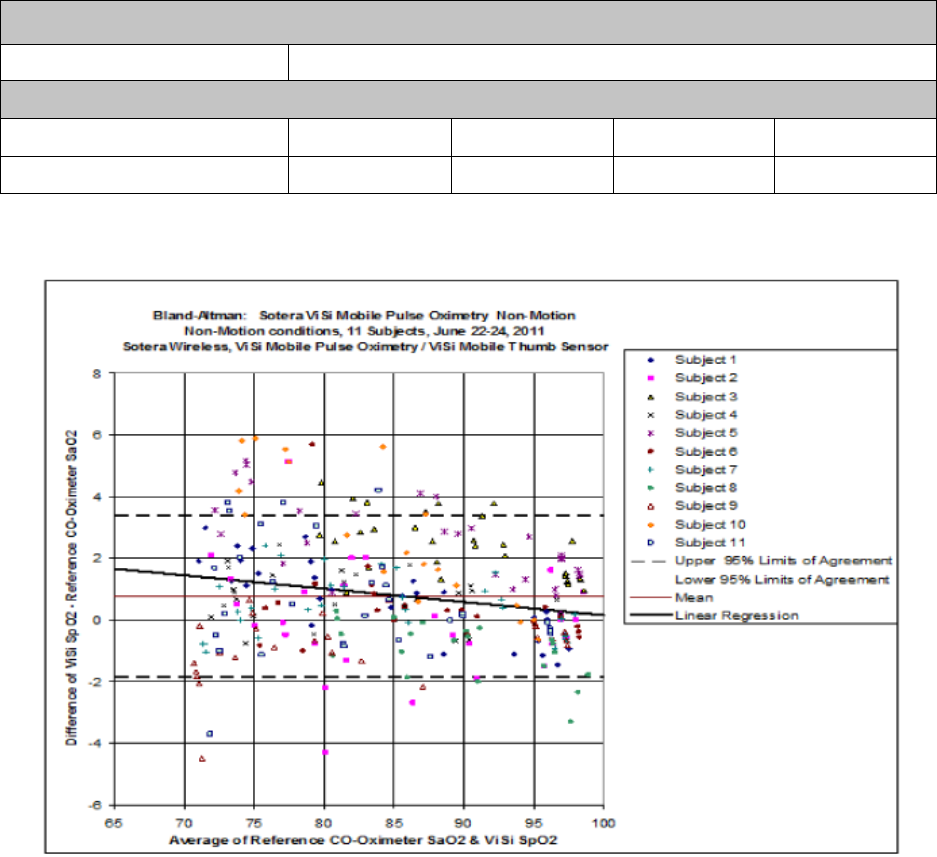
Vital Sign Measurements
111
The table below shows Arms values measured using the ViSi Mobile Thumb Sensor (Model 92-10020) with
the ViSi Mobile Monitoring System in a clinical study:
Validation Data (per ISO 9919)
Age of Volunteers 18 - 45
SpO2 Accuracy (No Motion)
SpO2 Range 70-100% 90-100% 80-90% 70-80%
Accuracy (Arms) - No Motion 1.9 1.2 1.9 2.4
Bland-Altman: ViSi Mobile Pulse Oximetry
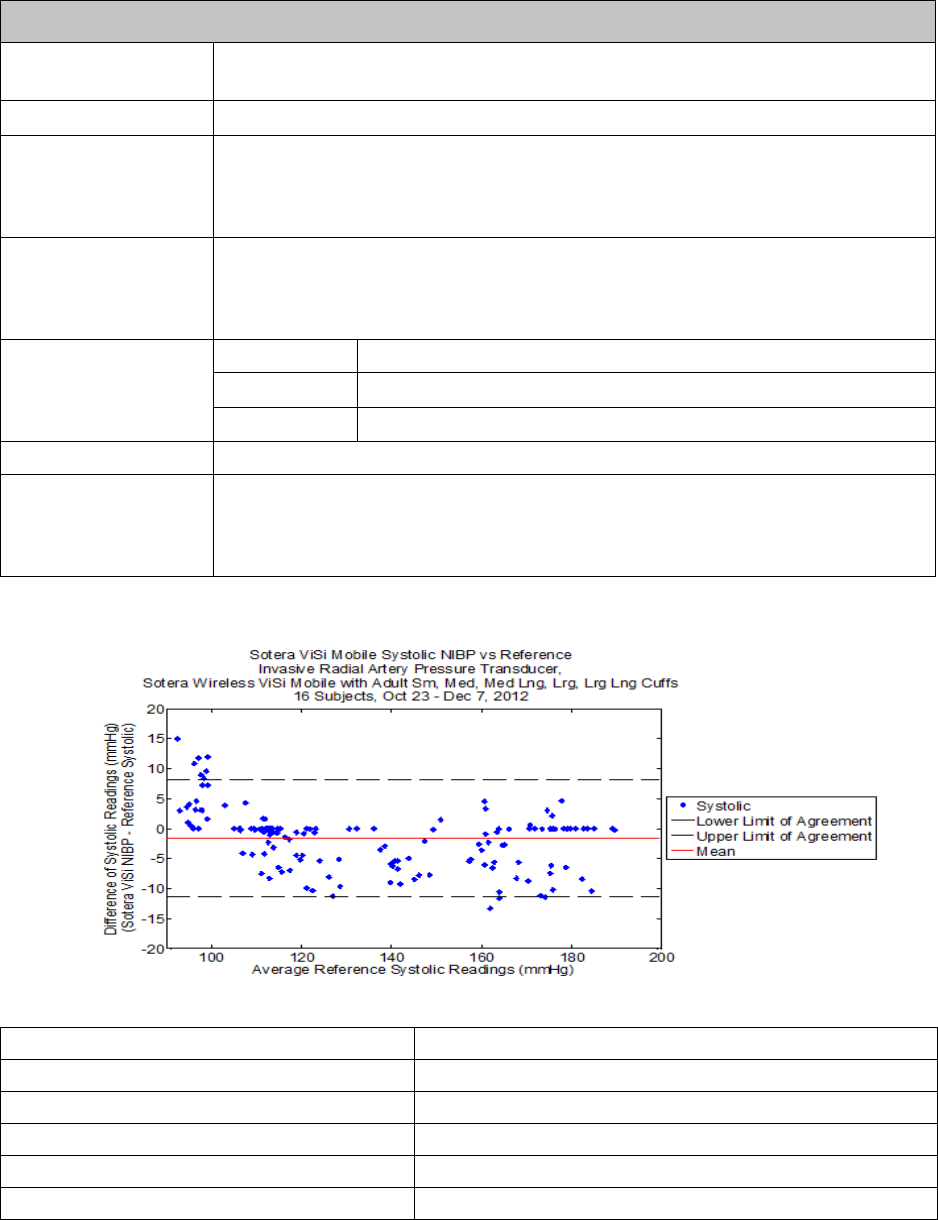
Vital Sign Measurements
112
11.2.4 Non-Invasive Blood Pressure (NIBP)
Non-Invasive Blood Pressure (NIBP)
Normative Reference ISO 81060-2: Non-invasive Sphygmomanometers - Part 2: Clinical validation of
automated measurement type.
Principle of Operation Oscillometry
Systolic Range: 60 to 240 mmHg
Accuracy: Mean error of less than ± 5 mmHg and a std. dev. of ≤ 8 mmHg
Resolution: 1 mmHg
Diastolic Range: 40 to 160 mmHg
Accuracy: Mean error of less than ± 5 mmHg and a std. dev. of ≤ 8 mmHg
Resolution: 1 mmHg
Mean Arterial Pressure Range: 50 to 185 mmHg
Accuracy: Mean error of less than ±5 mmHg and a std. dev. of ≤ 8 mmHg
Resolution: 1 mmHg
Pulse Rate Accuracy (NIBP) <3 BPM
Validation Study Invasive blood pressure (radial artery) reference
Number of subjects: 16
Subject Age Range: 19-48
Sample Size: 152 data points
Mean: -1.65 mmHg
Standard Deviation: 5.01 mmHg
Upper 95% Limits of Agreement (+1.96 SD): 8.2 mmHg
Lower 95% Limits of Agreement (-1.96 SD): -11.5 mmHg
Systolic Bland Altman Analysis (NIBP)
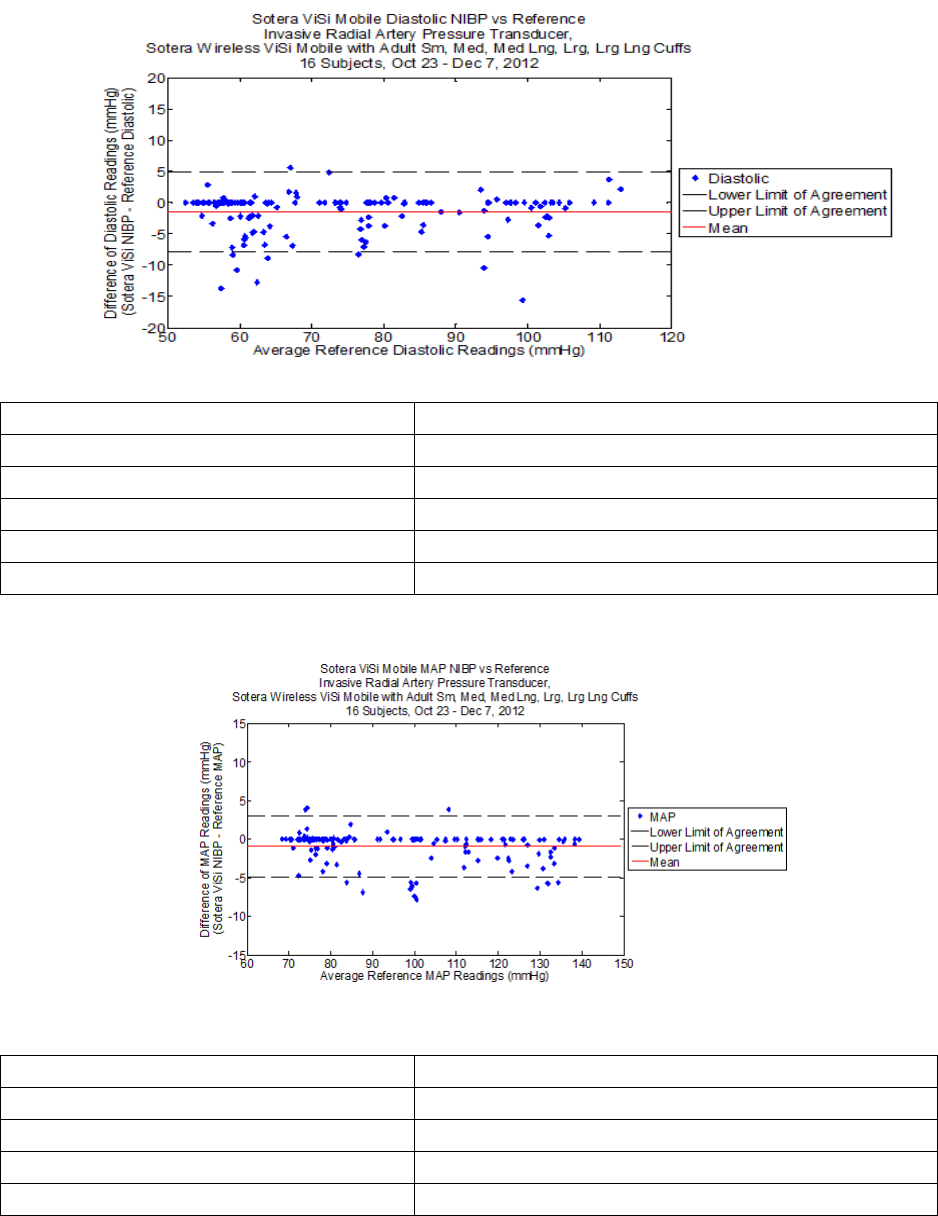
Vital Sign Measurements
113
Sample Size: 152 data points
Mean: -1.49 mmHg
Standard Deviation: 3.22 mmHg
Upper 95% Limits of Agreement (+1.96 SD): 4.8 mmHg
Lower 95% Limits of Agreement (-1.96 SD): -7.8 mmHg
Sample Size: 152 data points
Mean: -0.91 mmHg
Standard Deviation: 2.04 mmHg
Upper 95% Limits of Agreement (+1.96 SD): 3.1 mmHg
Lower 95% Limits of Agreement (-1.96 SD): -4.9 mmHg
Diastolic Bland Altman Analysis (NIBP)
Mean Arterial Pressure Bland Altman Analysis (NIBP)

Vital Sign Measurements
114
11.2.5 Continuous Non-Invasive Blood Pressure (cNIBP)
cNIBP Clinical Study Results
Sotera ViSi cNIBP vs. Reference Invasive Radial Artery Transducer (n=15 subjects)
Continuous Non-Invasive Blood Pressure (cNIBP)
Normative Reference ISO 81060-2: Non-invasive Sphygmomanometers - Part 2: Clinical validation of
automated measurement type.
Principle of Operation cNIBP is based on the relationship between blood pressure and the time it takes a pulse
that originates from a cardiac contraction to arrive at a peripheral location.
Display Update Continuous blood pressure is displayed based on averaging PAT calculations from the
previous 60 seconds and updating the display every 3 seconds.
Systolic Range: 60 to 240 mmHg
Accuracya,b:
a. ViSi Mobile Monitoring System accuracy claim is not met when the subject is inclined more than 30
degrees from horizontal.
b. The accuracy and precision of the cNIBP measurement met ISO 81060-2 requirements for the first 2.5
hours of testing.
Mean error of ≤ ± 5 mmHg and a std.dev. of ≤ 8 mmHg
Resolution: 1 mmHg
Diastolic Range: 40 to 160 mmHg
Accuracya,b:Mean error of ≤ ± 5 mmHg and a std.dev. of ≤ 8 mmHg
Resolution: 1 mmHg
Mean Arterial Pressure
(MAP)
Range: 50 to 185 mmHg
Accuracya,b:Mean error of ≤ ± 5 mmHg and a std.dev. of ≤ 8 mmHg
Resolution: 1 mmHg
Validation Study Invasive blood pressure (radial artery) reference
Number of subjects: 15
Subject age range: 19-48 years
Arm circumference range tested: 21-38 cm
Subject Position Supine 30o60oOverall
Systolic Bias -1.61 -4.77 -7.36 -1.88
Std. Dev. 5.69 7.87 9.97 6.17
Diastolic Bias -1.33 -3.97 -8.31 -1.65
Std. Dev. 3.16 4.49 6.07 3.62
MAP Bias -0.33 -3.01 -7.23 -0.67
Std. Dev. 3.36 5.37 6.67 3.86
Data Points 47,572 1,774 1,724 54,179
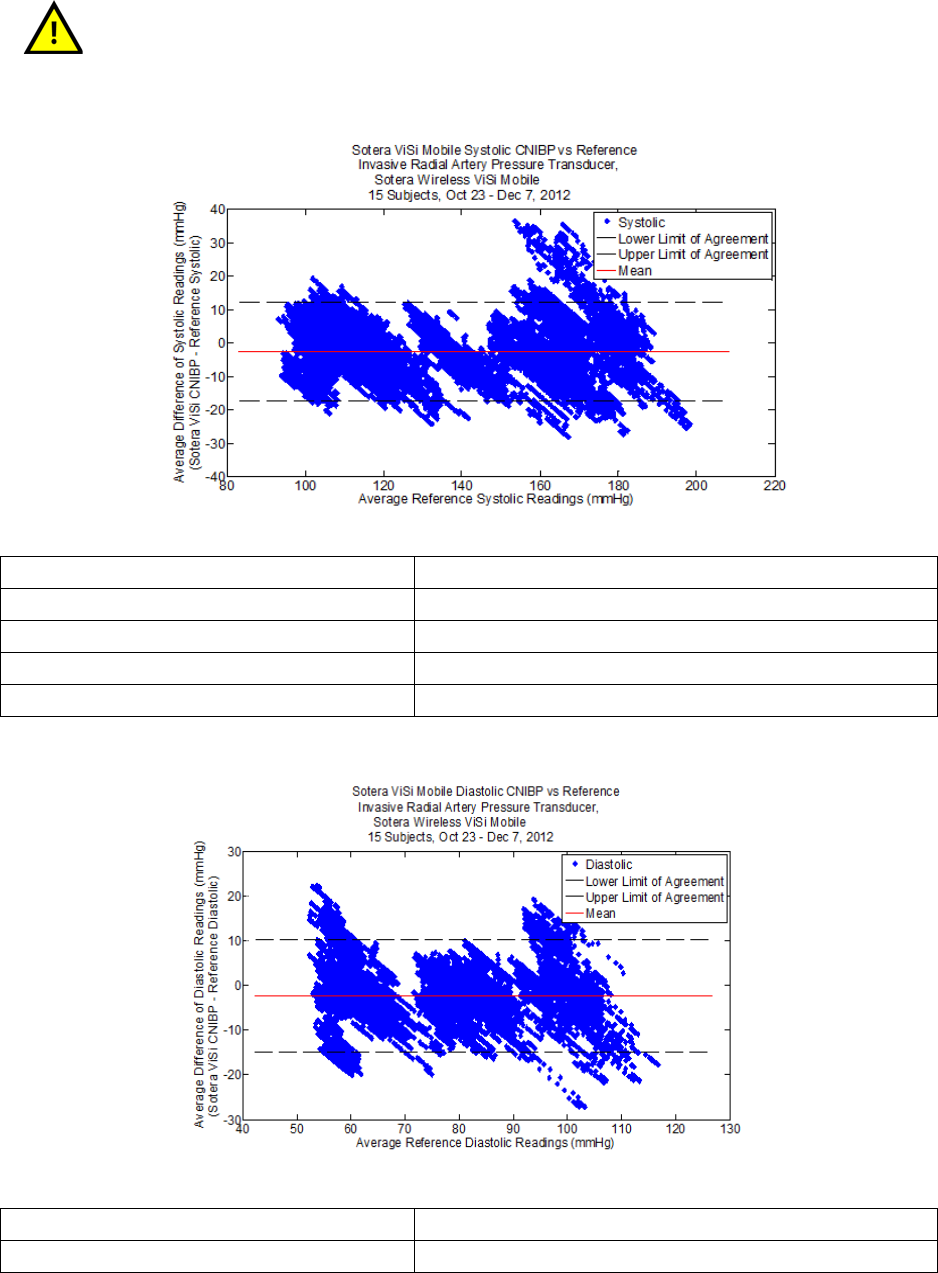
Vital Sign Measurements
115
Changes in posture can affect ViSi cNIBP accuracy. Recalibrate ViSi cNIBP
whenever torso changes by more than 30o above supine position.
Sample Size: 54,179 data points
Mean: -1.88 mmHg
Standard Deviation: 6.17 mmHg
Upper 95% Limits of Agreement (+1.96 SD): 10.2 mmHg
Upper 95% Limits of Agreement (-1.96 SD): -14.0 mmHg
Sample Size: 54,179 data points
Mean: -1.65 mmHg
Systolic Bland Altman Analysis (cNIBP)
Diastolic Bland Altman Analysis (cNIBP)
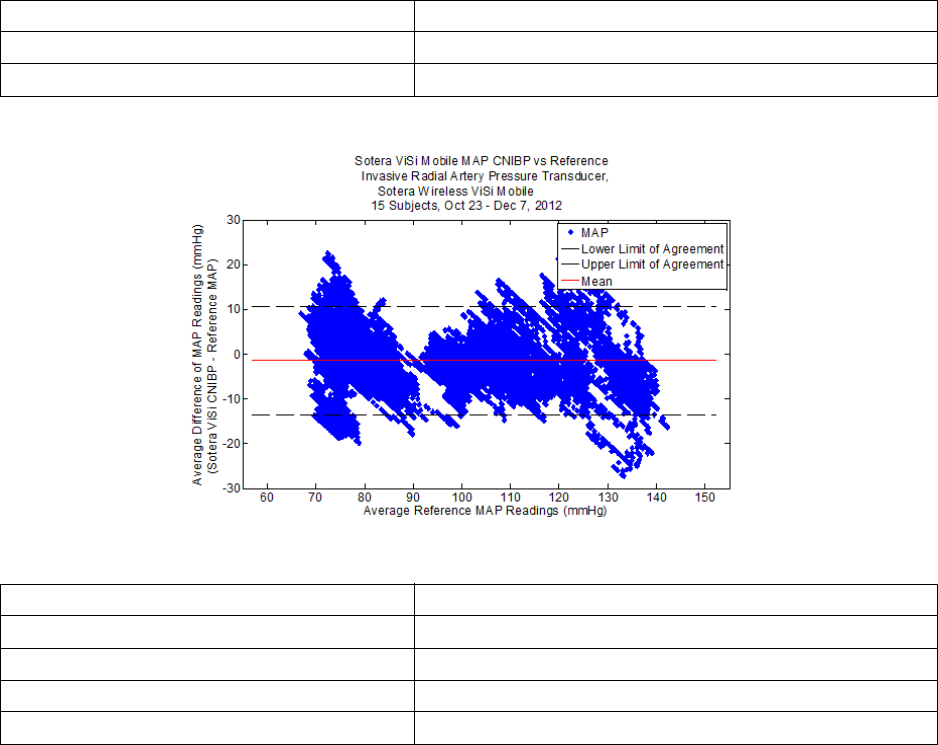
Vital Sign Measurements
116
Standard Deviation: 3.62 mmHg
Upper 95% Limits of Agreement (+1.96 SD): 5.4 mmHg
Upper 95% Limits of Agreement (-1.96 SD): -8.7 mmHg
Sample Size: 54,179 data points
Mean: -0.67 mmHg
Standard Deviation: 3.86 mmHg
Upper 95% Limits of Agreement (+1.96 SD): 6.9 mmHg
Upper 95% Limits of Agreement (-1.96 SD): -8.2 mmHg
MAP Bland Altman Analysis

Vital Sign Measurements
117
11.2.6 Skin Temperature
Temperature
Scale oCoF
Range / Accuracy
(measurement at
approximately 102 kPa
/ 768 mmHg)
Range Accuracy Range Accuracy
0o - 19.9o±0.3o 32o - 67.9o±0.5o
20o - 24.9o±0.3o68o - 76.9o±0.5o
25o - 35.9o±0.2o77o - 96.7o±0.3o
36o - 39.9o±0.1o96.8o - 103.9o±0.2o
40o - 41.9o±0.2o104o - 107.5o±0.3o
42o - 50.0o±0.3o107.6o - 122o±0.5o
Resolution ± 0.1o± 0.1o
Transient Response < 6 min (25o - 37o) < 6 min (77o - 98.6o)

Physical Components
118
11.3 Physical Components
11.3.1 ViSi Mobile Monitor
Wireless Communications / Radio
ViSi Mobile Monitor
Physical Characteristics Dimensions 2.59 cm H x 4.85 cm W x 9.35 cm L
1.02 in. H x 1.91 in. W x 3.68 in. L
exclusive of connectors and Wrist Cradle
Weight 110 g / 3.92 oz
Monitor Display OLED, 160 x 128 pixels, full color
Audio Alarm annunciation, QRS, self-test
Waveforms One waveform, user selectable
Aspect Ratio: 0.4 Sec/mV
Scaled equivalent to 25 mm/sec sweep speed
Respiration waveform scaled equivalent to 6.25
mm/sec sweep speed
Battery Operating Time > 12 hours
Fuel Charge Display Battery Symbol
Charge Level with Full Indication
Charge Time Less than 4 hours
Battery Type Li-Ion, 3.7 V., 2000 mAh, single cell
Maximum Temperature 45oC / 113oF
Refer to IEC 60601-1:2005 (Section 11)
Cleaning / Disinfecting Liquid Ingress Rating IPX7
During cleaning cycle only, not during monitoring
Solutions / Compounds • Isopropyl alcohol (IPA)
• Detergent (Alconox)
Wireless Communications
Frequency 2.402 - 2.480 GHz
Protocol 802.11b
Modulation Direct Sequencing Spread Spectrum
Security WPA2 / PSK
Power Output (max) 8 mW (9 dBm)
WiFi Alliance Compliant Yes; Reference Protocol: ASD 0478
Data Throughput < 20 KBps

Physical Components
119
Mode Plugs
If you have any concerns regarding a cyber security breach or vulnerability, contact
Sotera Wireless or an authorized Sotera Wireless representative in your area.
Mode Plugs
Shipping Plug Turns device off completely
Bio Med Pluga
a. The Bio Med Plug is not currently available.
Enables configuration and test functions
Locking Plug Secures Monitor into Wrist Cradle
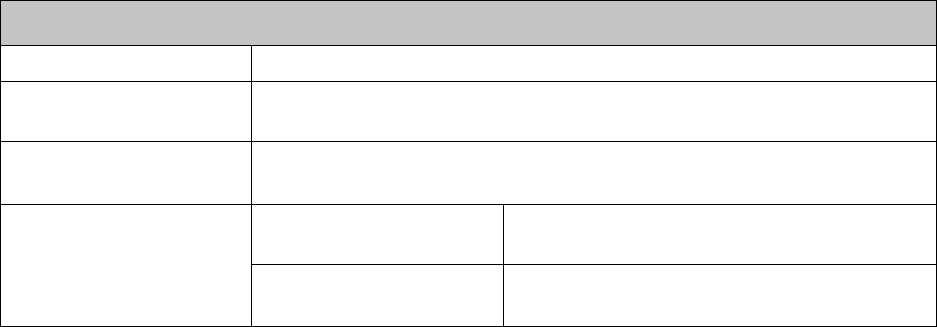
Physical Components
120
11.3.2 ViSi Mobile Chest Sensor Cable
ViSi Mobile Chest Sensor Cable
Mechanical Complies with EC53
Weight
(5 lead-wire / 3 lead-wire)
72 g / 62 g (2.54 oz. / 2.19 oz.)
Maximum Temperature 43oC / 109.4oF
Refer to IEC 60601-1:2005 (Section 11)
Cleaning / Disinfecting Liquid Ingress Rating IPX7
During cleaning cycle only, not during monitoring
Solutions / Compounds • Isopropyl alcohol (IPA)
• Detergent (Alconox)
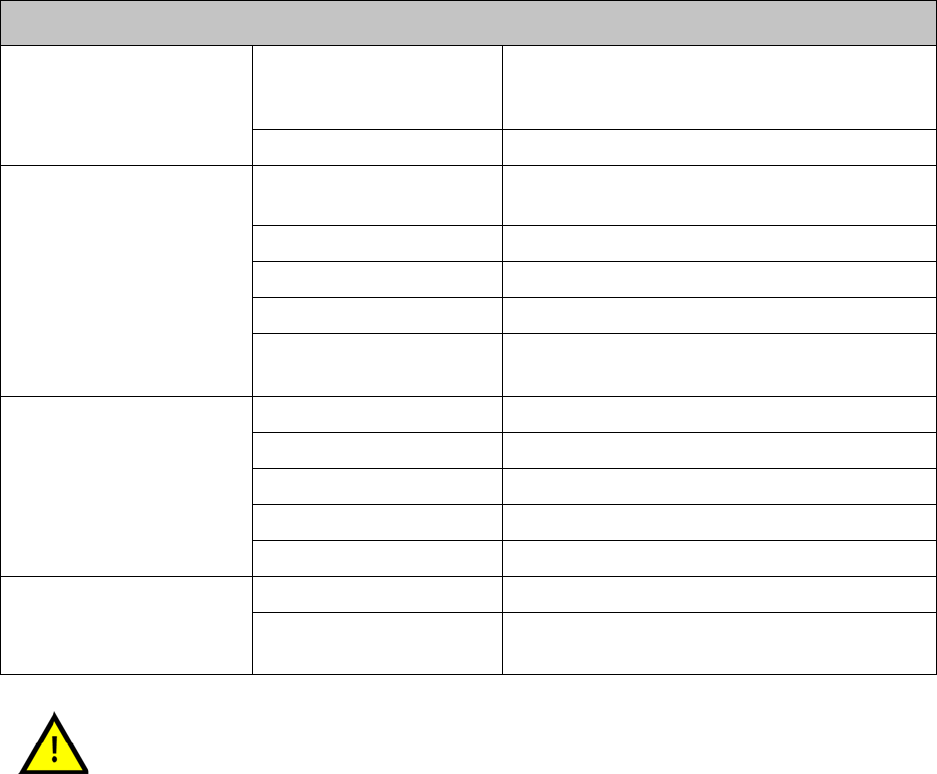
Physical Components
121
11.3.3 ViSi Mobile Cuff Module
ViSi Mobile Cuff Module
Physical Characteristics Dimensions 3.10 cm H x 4.85 cm W x 12.19 cm L
(1.22 in. H x 1.91 in. W x 4.80 in. L)
exclusive of cable
Weight 157 g (5.54 oz)
Battery Operating Time > 30 cuff inflations or 24 hrs, whichever occurs
first
Charge Display Status Eight LEDs: Six levels of Green, Yellow, Red
Charge Time < 4 hours
Battery Type Battery Pack, Li-Ion, 2000 mAh
Maximum Temperature 45oC / 113oF
Refer to IEC 60601-1:2005 (Section 11)
Cuff Sizes
Arm Circumference (cm)
Small 20 – 26
Medium 25 – 34
Medium+ 25 – 34
Large 32 – 43
Large+ 32 – 43
Cleaning / Disinfecting Liquid Ingress Rating IPX0
Solutions / Compounds • Isopropyl alcohol (IPA)
• Detergent (Alconox)
When the ViSi Mobile Cuff Module is connected to the other ViSi Mobile
Components, the entire system has an ingress protection rating of IPX0.

Physical Components
122
11.3.4 ViSi Mobile Thumb Sensor
ViSi Mobile Thumb Sensor
Cleaning / Disinfecting Liquid Ingress Rating IPX7
During cleaning cycle only, not during monitoring
Solutions / Compounds • Isopropyl alcohol (IPA)
• Detergent (Alconox)
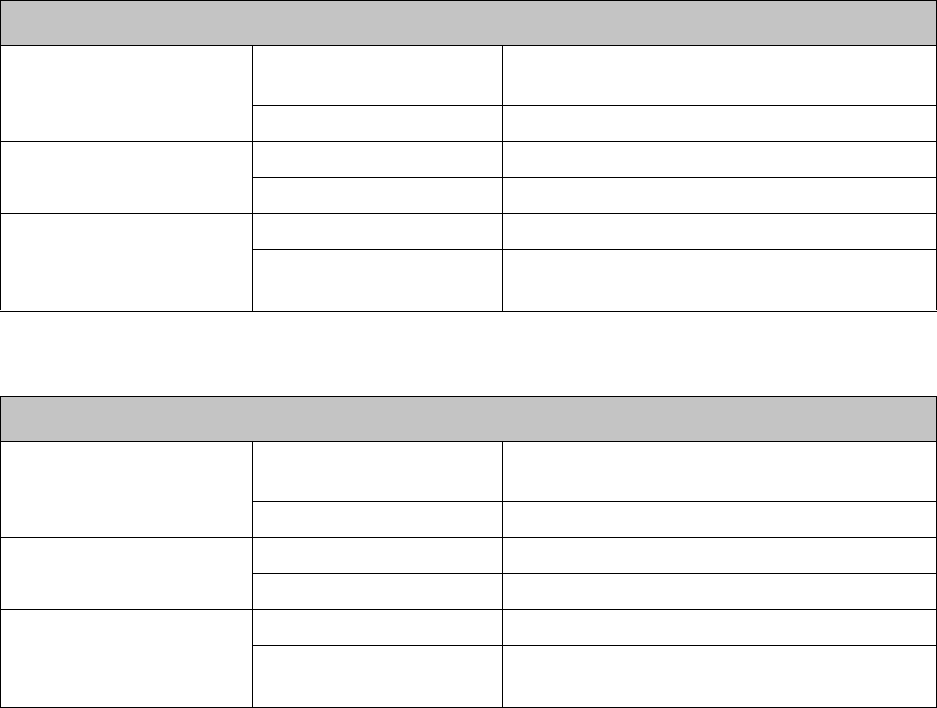
Physical Components
123
11.3.5 ViSi Mobile Charger - 8 Bay
11.3.6 ViSi Mobile Charger - 2 Bay
ViSi Mobile Charger
Physical Characteristics Dimensions 7.7 cm x 46.3 cm x 5.9 cm
(3.0 in x 18.2 in x 2.3 in)
Weight 0.7 kg (1.5 lb)
AC Mains AC Line Voltage 100-240 V, 50-60 Hz
Power (all bays charging) 75 W
Cleaning / Disinfecting Liquid Ingress Rating IPX0
Solutions / Compounds • Isopropyl alcohol (IPA)
• Detergent (Alconox)
ViSi Mobile Charger
Physical Characteristics Dimensions 7.7 cm x 12.9 cm x 5.9 cm
(3.0 in x 5.1 in x 2.3 in)
Weight 0.25 kg (0.6 lb)
AC Mains AC Line Voltage 100-240 V, 50-60 Hz
Power (all bays charging) 30 W
Cleaning / Disinfecting Liquid Ingress Rating IPX0
Solutions / Compounds • Isopropyl alcohol (IPA)
• Detergent (Alconox)

Physical Components
124
11.3.7 ViSi Mobile Appliance
ViSi Mobile Appliance
Server Configuration Single 1u, redundant hardware and internal RAID 10, dedicated hardware.
Processor Single Intel Xeon 5620
2.4 GHz (or equivalent CPU)
8 GB memory
Storage Server contains at a minimum 4 x 500 GB 7200 RPM hard drives in RAID 10
array
Operating System Note: SUSE Linux Enterprise Server (Version 11, Patch Level 2)
Network Requirements Static IP address or DHCP reservation required
Multicast configuration on network backbone devices
Dimensions
(Single Appliance, may vary)
H: 43.0 cm x W: 43.4 cm x L: 62.7 cm (w/o ear, w/o bezel)
H: 1.7 in x W: 17.1 in x L: 24.7 in
Weight
(Single Appliance)
35.02 lb (15.9 kg)
(Maximum configuration weight)
Power Requirements
(Single Appliance)
100-240 VAC, 50-60 Hz, 7 A - 3.5 A w/ redundant power supply
Backup Power Requirement
(Full System)
Customer supplied Uninterruptable Power Supply and Hospital Emergency
Power recommended.

Physical Components
125
11.3.8 ViSi Mobile Remote Viewer
Note: Sotera Wireless recommends installation of Trend Micro anti-virus software on Windows
platforms. Anti-virus software is not installed on the ViSi Mobile Appliance.
Note: For printing capability, Sotera Wireless recommends connecting a printer directly to the
ViSi Mobile Remote Viewer or to an in-network printer via an IP address. Sotera Wireless
does not support additional configurations.
ViSi Mobile Remote Viewer (Desktop PC with Touchscreen Display)
No. of Patients per Remote Viewer Maximum 32
Display 23 in display / 1920 x 1080 resolution
(screen is touch sensitive to issue commands alternative to mouse/keyboard)
Processor Intel i5 2400 CPU 4 Core
3.10 GHz
4 GB Memory
Storage One 500 GB 7200 RPM SATA
Operating Systems Microsoft® Windows® 7 Professional (version 6.1) x64 Bit SP1
Network Requirements Ethernet Connection, DHCP
Dimensions H: 45.0 cm x W: 58.5 cm x D: 10.3 cm
H: 17.7 in x W: 23.0 in x D: 4.1 in
Weight 26.7 lb (12.1 kg)
Power Requirements AC/DC Adapter
Input: 100-240 V ~3.5 A, 50-60 Hz
Output to Viewer: 19.5 V / 11.8 A
Backup Power Requirement Customer supplied Uninterruptable Power Supply and Hospital Emergency
Power recommended.
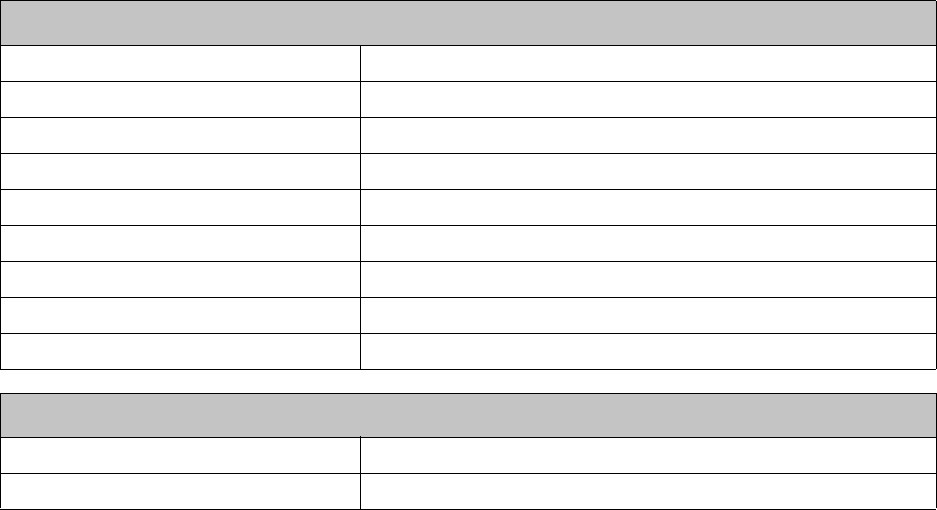
Physical Components
126
11.3.9 Customer Network
Wireless Network
Wireless Network Standard IEEE 802.11b
Recommended Channels 1, 6, 11
Network Latency < 150 ms
Wireless Network Security Support WPA2-PSK
Minimum Receiver Sensitivity -65 dBm (edge coverage)
Wireless access point cell overlap 15-20%
Signal-to-Noise Ratio ≥25 dB
Packet loss ≤6%
SSID Dedicated or shared with other medical devices
Wired Network
Appliance (Server) Requires static IP Address
Network availability >99.9%
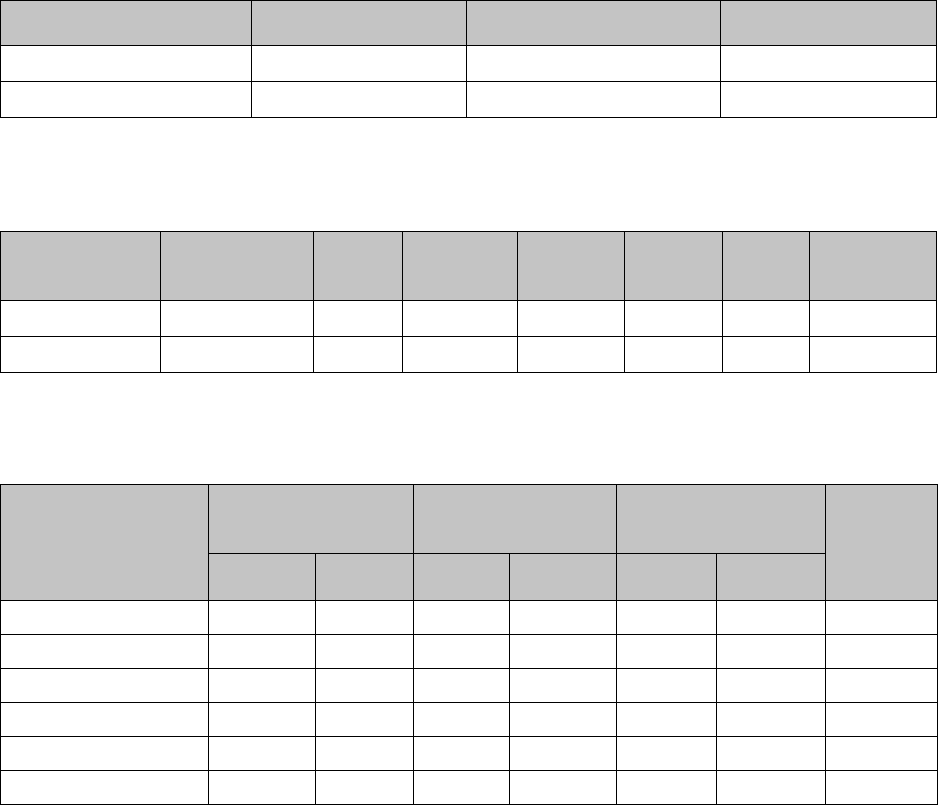
Alarms / Alerts Annunciation
127
11.4 Alarms / Alerts Annunciation
Note: An “Annunciation Delay” is the time that an alarm system deliberately delays the alarm
annunciation (audibly and visually) to ensure clinical relevance of the detected alarming
condition. Within the tables below, see column “Annunciation Delay” for the pre-defined
periods of time.
Note: When the ViSi Mobile Monitor is connected to a network (as indicated by the network
symbol in the top left hand corner of the display), the audio annunciation of non-life-
threatening alarms/alerts will be deferred to the ViSi Mobile Remote Viewer for a pre-
configured period of time. Within the tables below, see column “Deferral Delays” for the
pre-defined periods of time.
11.4.1 Physiological Alarms (Alarms)
Visual Display
The following table outlines the visual display when alarms are in progress:
Audio Tones
The following table outlines the audio tones when alarms are in progress:
Alarm Limits and Delays (factory default settings).
Severity Indicator Attributes Toggle / Flash Speed Duty Cycle
High Priority Red 1.5 Hz 50% ON
Life-Threatening Priority Red / White 1.5 Hz 50% ON
Severity Melodya
a. Melodies are defined as musical notes.
Volume
[dB] Frequency
(fo) [Hz] Duration
(td) [ms] Spacing
(ts) [ms] 5th-6th
[s] Inter-Burst
(tb) [s]
Life Threatening b5.b5.b5..b5.b5 78 987.767 100 50 0.35 2.5
High b5.b5.b5..b5.b5 78 987.767 200 100 0.35 5
Vital Sign Lower Limit Upper Limit Annunciation Delaya
(seconds) Deferral
Delay
(seconds)
Care Unit Patient Patient Care Unit Patient Care Unitb
Critical Low HR (BPM) 18 18 N/A N/A 5 5 30
Heart Rate (BPM) 30 30 150 200 5 5 60
Pulse Rate (BPM) 30 30 150 200 30 30 60
BP Systolic (mmHg) 70 OFF 190 240 60 30 90
BP Diastolic (mmHg) 40 OFF OFF 150 60 30 90
BP MAP (mmHg) 60 65 OFF 170 60 30 90
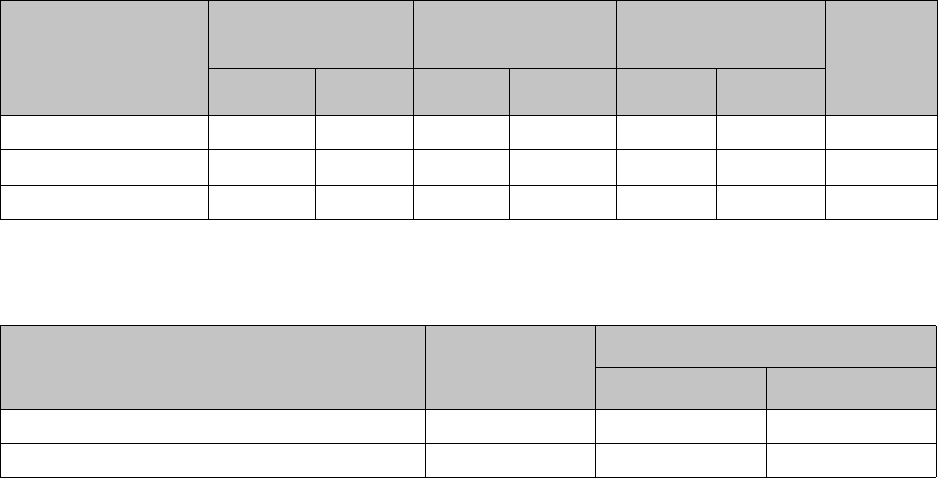
Alarms / Alerts Annunciation
128
Respiration (BR/MIN) 4 4 35 40 120 60 90
SpO2 (%) 85 85 N/A N/A 30 30 60
Skin Temperature N/A N/A N/A N/A N/A N/A N/A
a. When measurement blood pressure as a 1-time measurement or at automatic intervals, there will be no
annunciation delay.
b. As the vital sign measurement approaches the care unit limit, the annunciation delay will decrease linearly.
No Pulse Detected Alarms Limit Delays
Annunciation Deferral
When Thumb Sensor is primary source No Pulse No delay 60
When Cuff Module is primary source No Pulse No delay 60
Vital Sign Lower Limit Upper Limit Annunciation Delaya
(seconds) Deferral
Delay
(seconds)
Care Unit Patient Patient Care Unit Patient Care Unitb

Alarms / Alerts Annunciation
129
Battery Alarms
Battery Alarms Limit Delays (in seconds)
Annunciation Deferral
Monitor
Monitoring Mode 45oC (113oF) No delay No deferral
In the Charger 45oC (113oF) No delay N/A
Not monitoring / Not in the Charger 45oC (113oF) No delay N/A
Cuff
Module
Connected to the Monitor 45oC (113oF) No delay No deferral
In the Charger 45oC (113oF) No delay N/A
Not monitoring / Not in the Charger 45oC (113oF) No delay N/A

Alarms / Alerts Annunciation
130
11.4.2 Equipment Alarms (Alerts)
Visual Display
The following table outlines the visual display when alerts are in progress:
Audio Tones
The following table outlines the audio tones when alerts are in progress:
Note: There are no audio tones associated with low severity alerts.
Alarm Limits and Delays (factory default settings)
Severity Indicator Attributes Toggle / Flash Speed Duty Cycle
All Severities Cyan (Blue) Constant (ON) 100% ON
Severity Melodya
a. Melodies are defined as musical notes.
Volume
[dB] Frequency
(fo) [Hz] Duration
(td) [ms] Spacing
(ts) [ms] Inter-Burst
(tb) [s]
High e5.c5 68/63 659.255, 523.251 250 250 15
Chest Sensor Alerts Limit
(if applicable) Audible
Alert
Delays (in seconds)
Annunciation Deferral
ECG Lead Failure N/A No No delay N/A
All ECG Lead Failure N/A No No delay N/A
Chest Sensor Disconnected N/A No No delay N/A
General Fault Detected N/A No No delay N/A
Multiple Connections N/A No No delay N/A
Temperature Sensor Fault N/A No No delay N/A
Accelerometer Fault - Chest Module N/A No No delay N/A
Accelerometer Fault - Upper Arm N/A No No delay N/A
Thumb Sensor Alerts Limit
(if applicable) Audible
Alert
Delays (in seconds)
Annunciation Deferral
Thumb Sensor Off N/A No < 30 N/A
Thumb Sensor Disconnected N/A No No delay N/A

Environmental Conditions
131
11.5 Environmental Conditions
Cuff Module Alerts Limit
(if applicable) Audible
Alert
Delays (in seconds)
Annunciation Deferral
Low Battery 4% to 10% No No delay N/A
Battery Empty < 4% No No delay N/A
Check Cuff N/A No No delay N/A
Cuff Occluded N/A No No delay N/A
NIBP Unobtainable N/A No No delay N/A
Invalid Software Loaded N/A No No delay N/A
Pressure Accuracy Fault N/A No No delay N/A
General Fault Detected N/A No No delay N/A
Pressure Exceeded 300mmHg Yes No delay No deferral
Multiple Connections N/A No No delay N/A
Wrist Monitor Alerts Limit
(if applicable) Audible
Alert
Delays (in seconds)
Annunciation Deferral
Calibrate cNIBP N/A N/A No delay N/A
Low Battery 3 hours No No delay N/A
Critical Low Battery 1 hour No No delay N/A
Too Low to Monitor 10 minutes No No delay N/A
Invalid Plug Connected N/A Yes No delay No deferral
Audio System Failure N/A No No delay N/A
Wireless Radio Failure N/A No No delay N/A
All Sensors Disconnected N/A No No delay N/A
Accelerometer Failure N/A No No delay N/A
Shock Hazard N/A Yes No delay No deferral
Patient Tampering
(number of incorrect pin code entries)
5 invalid pin
codes
No No delay N/A
Environmental Conditions for all ViSi Mobile Components
(Monitor, Cuff Module, Chest Sensor Cable, Cuff, Thumb Sensor)
Condition Storage
(Packaged / Unpacked) Operating
(Unpack aged)
Temperature -20oC to +55oC (50oC for NIBP)
-4oF to +131oF (122oF for NIBP)
0oC to +50oC / 32oF to +122oF
Battery Charger: 0oC to +40oC
Humidity 15% to 95% non-condensing
(90% for NIBP)
10% to 95% non-condensing
(90% for NIBP)
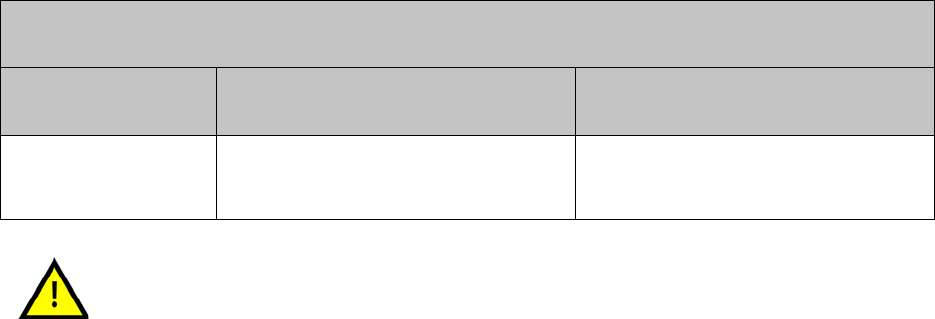
Environmental Conditions
132
Atmospheric Pressure
Range
107 kPa to 50 kPa
803 mmHg to 375 mmHg
1.06 atm to 0.49 atm
107 kPa to 70 kPa
803 mmHg to 525 mmHg
1.06 atm to 0.69 atm
The ViSi Mobile Monitor may not perform to specification if stored or shipped
outside the specified temperature range.
Environmental Conditions for all ViSi Mobile Components
(Monitor, Cuff Module, Chest Sensor Cable, Cuff, Thumb Sensor)
Condition Storage
(Packaged / Unpacked) Operating
(Unpack aged)
Compliances
133
11.6 Compliances
Observe any national regulations on the qualification of the testing personnel and suitable measuring and
testing facilities. See User Maintenance on page 127 for a list of required tests.
11.6.1 Federal Communications Commission (FCC)
The equipment device complies with Part 15 of the FCC Rules. Operation is subject to the following two
conditions: (1) This device may not cause harmful interference, and (2) This device must accept any
interference received including interference that may cause undesired operation.
Changes or modifications not expressly approved by Sotera Wireless could void the user’s authority to
operate the equipment. Manufacturer is not responsible for any radio or TV interference caused by
unauthorized modifications to this equipment.
This equipment has been tested and found to comply with the limits for a Class B digital device, pursuant
to Part 15 of the FCC Rules. These limits are designed to provide reasonable protection against harmful
interference in a residential installation. This equipment generates, uses and can radiate radio frequency
energy and, if not installed and used in accordance with the instructions, may cause harmful interference to
radio communications. However, there is no guarantee that interference will not occur in a particular
installation. If this equipment does cause harmful interference to radio or television reception, which can
be determined by turning the equipment off and on, the user is encouraged to try to correct the interference
by one or more of the following measures:
• Reorient or relocate the receiving antenna
• Increase the separation between the equipment and receiver
• Connect the equipment into an outlet on a circuit different from that to which the receiver is
connected
• Consult the dealer or an experienced radio/TV technician for help
This device complies with Industry Canada license-exempt RSS standard(s). Operation is subject to the
following two conditions: (1) this device may not cause interference, and (2) this device must accept any
interference, including interference that may cause undesired operation of the device.
Le présent appareil est conforme aux CNR d'Industrie Canada applicables aux appareils radio exempts de
licence. L'exploitation est autorisée aux deux conditions suivantes : (1) l'appareil ne doit pas produire de
brouillage, et (2) l'utilisateur de l'appareil doit accepter tout brouillage radioélectrique subi, même si le
brouillage est susceptible d'en compromettre le fonctionnement.
Class B digital device notice / “CAN ICES-3 (B)/NMB-3(B)”.
This equipment complies with the FCC/IC radiation exposure limits set fourth for portable transmitting
devices operation in a controlled environment. End users must follow the specific operating instructions to
satisfy RF exposure compliance.
The equipment should only be used where there is normally at least 22.651mm separation between the
antenna and all person/user.
This transmitter must not be co-located or operation in conjunction with any other antenna or transmitter.
Any changes or modifications not expressly approved by the party responsible for compliance could void
the user’s authority to operate this equipment.

Compliances
134
11.6.2 Electromagnetic Compatibility (EMC) Specifications
Take special precautions regarding electromagnetic compatibility (EMC) when using medical electrical
equipment. Operate your monitoring equipment according to the EMC information provided in this
manual. Portable and mobile radio frequency (RF) communications equipment can affect medical
electrical equipment.
Accessories Compliant with EMC Standards
All accessories (e.g. ViSi Mobile Charger) comply with either IEC 60601-1-2 or IEC 60950-1.
Consult your Biomed department or vendors for assistance in identifying
EMC compliance status of other medical devices when using the ViSi
Mobile Monitoring System.
Using accessories other than those specified may result in increased
electromagnetic emission or decreased electromagnetic immunity of the
monitoring equipment.

Compliances
135
11.6.3 Electromagnetic Emissions
The ViSi Mobile Monitor is suitable for use in the electromagnetic environment specified in the table
below. Ensure that the Monitor is used in such an environment.
Emissions Test Compliance Avoiding Electromagnetic Interference
Radio Frequency (RF) emissions Group 1 The ViSi Mobile Monitor uses RF energy only for
its internal functiona. Therefore, its RF emissions
are very low and are not likely to cause any
interference in nearby electronic equipment.
a. The battery operated ViSi Mobile Monitor contains a 2.4 GHz DSSS transmitter for the purpose of wire-
less communication. The radio is excluded for the EMC requirements of IEC 60601-1-2, but should be
considered when addressing possible interference issues between this and other devices.
RF emissions CISPR 11 Class A The ViSi Mobile Monitor is suitable for use in all
establishments other than domestic and those
directly connected to the public low-voltage
supply network that supplies buildings used for
domestic purposes.
Harmonic emissions IEC 61000-3-2 N/A
Voltage fluctuations IEC 61000-3-3 N/A

Compliances
136
11.6.4 Electromagnetic Immunity
The ViSi Mobile Monitor is suitable for use in specified electromagnetic environment. The user must
ensure that it is used in the appropriate environment as described below.
In the above table, UT (Unit in Test) is the ViSi Mobile Monitoring System.
Immunity Test IEC 60601-1-2 Electromagnetic
Environment Guidance
Test Level Compliance Level
Electrostatic
discharge (ESD)
IEC 61000-4-2
±6 kV contact
±8 kV air
±6 kV contact
±8 kV air
Floors should be wood,
concrete, or ceramic tile. If
floors are covered with
synthetic material, the
relative humidity should be
at least 30%.
Electrical fast
transient / burst
IEC 61000-4-4
±2 kV for power supply lines
±1 kV for input/output lines
±2 kV for power supply lines
±1 kV for input/output lines
Mains power quality should
be that of a typical medical
and/or hospital environment.
Surge
IEC61000-4-5
±1 kV differential mode
±2 kV common mode
±1 kV differential mode
±2 kV common mode
Mains power quality should
be that of a typical medical
and/or hospital environment.
Voltage dips,
short
interruptions and
voltage
variations on
power supply
input lines
IEC 61000-4-11
<5% UT
(>95% dip in UT) for 0.5
cycles
<5% UT
(>95% dip in UT) for 0.5
cycles
40% UT
(60% dip in UT) for 5 cycles
40% UT
(60% dip in UT) for 5 cycles
70% UT
(30% dip in UT) for 25
cycles
70% UT
(30% dip in UT) for 25
cycles
<5% UT
(>95% dip in UT) for 5 sec
<5% UT
(>95% dip in UT) for 5 sec
Power frequency
(50/60Hz)
magnetic field
IEC 61000-4-8
3 A/m 3 A/m Power frequency magnetic
fields should be at levels
characteristic of a typical
location in a typical cial and/
or hospital environment.
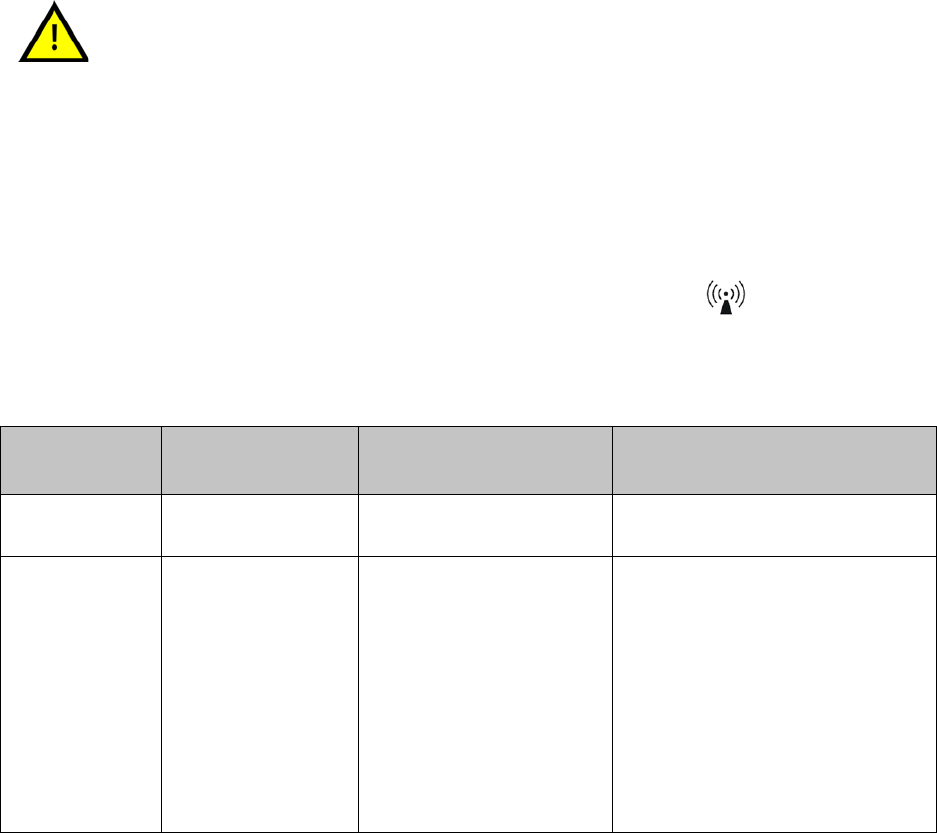
Compliances
137
11.6.5 Recommended Separation Distance
Portable and mobile RF communications equipment should be used no closer to any part of the ViSi
Mobile Monitor, including cables, than the recommended separation distance calculated from the equation
appropriate for the frequency of the transmitter.
Field strengths from fixed RF transmitters, as determined by an electromagnetic site survey, should be less
than the compliance level in each frequency range.
In the following table, P is the maximum output power rating of the transmitter in watts (W) according to
the transmitter manufacturer and d is the recommended separation distance in meters (m).
Field strengths from fixed transmitters, such as base stations for radio (cellular, cordless) telephones and
land mobile radios, amateur radio, AM and FM radio broadcast and TV broadcast cannot be predicted
theoretically with accuracy. To access the electromagnetic environment due to fixed RF transmitters, an
electromagnetic site survey should be considered. If the measured field strength in the location in which
the ViSi Mobile Monitor is used exceeds the applicable RF compliance level above, the Monitor should be
observed to verify normal operation. If abnormal performance is observed, additional measures may be
necessary, such as reorienting or relocating the Monitor.
These guidelines may not apply in all situations. Electromagnetic propagation is affected by absorption
and reflection from structures, objects and people.
The ViSi Mobile Monitor may be temporarily interrupted by UHF RFID
Systems (860-960MHz).
Interference may occur in the vicinity of equipment marked with this symbol:
Immunity Test IEC 60601-1-2
Test Level ViSi Mobile Monitoring
System Compliance Level Electromagnetic Environment
Guidance
Conducted RF
IEC 61000-4-6
3 VRMS
150 kHz to 80 MHz
3 VRMS Recommended separation distance:
d = 1.2√P
Radiated RF
IEC 61000-4-3
3 V/m
80 MHz to 2.5 GHz
3 V/m Recommended separation distance:
80 MHz to 800 MHz
80 MHz to 800 MHz
d = 3.5√P
800 MHz to 2.5 GHz
d = 2.3√P
2.0 to 2.3 GHz for short radio
d = 7.0√P

Compliances
138
From Portable and Mobile RF Communication Equipment
The ViSi Mobile Monitor is intended for use in an electromagnetic environment in which radiated RF
disturbances are controlled. The customer or user of the Monitor can help prevent electromagnetic
interference by maintaining a minimum distance between portable and mobile RF communications
equipment and the Monitor as recommended below, according to the maximum output power of the
communications equipment.
In the following table, P is the maximum power output rating of the transmitter in watts (W) according to
the transmitter manufacturer and d is the recommended separation distance in meters (m).
Electrosurgery Interference/Defibrillation/Electrostatic Discharge
The equipment returns to the previous operating mode within 10 seconds without loss of any stored data.
Measurement accuracy may be temporarily decreased while performing electrosurgery or defibrillation.
This does not affect patient or equipment safety. Do not expose the equipment to x-ray or strong magnetic
fields (MRI).
Fast Transients/Bursts
The equipment will return to the previous operating mode within 30 seconds without loss of any stored
data.
Frequency 150 kHZ to 80 MHz 80 MHz to 800 MHz 800 MHz to 2.5 GHz
Equation d = 1.2√Pd=1.2√Pd=2.3√P
Rated max. output
power of transmitter
Separation Distance Separation Distance Separation Distance
(m) (ft) (m) (ft) (m) (ft)
0.01 W 0.1 0.4 0.1 0.4 0.2 0.8
0.1 W 0.4 1.2 0.4 1.2 0.7 2.4
1 W 1.3 3.9 1.3 3.9 2.3 7.5
10 W 3.8 12.4 3.8 12.4 7.3 23.9
100 W 12.0 39.4 12.0 39.4 23.0 75.5

Compliances
139
11.6.6 Standards
Agency Compliances
• ANSI/AAMI EC13, Cardiac monitors, heart rate meters, and alarms
• ANSI/AAMI EC53, ECG cables and lead-wires.
• CAN/CSA C22.2 No 601.1 M90 Part 1: General requirements for basic safety and essential performance
• EN 1060-1:1995 Non-invasive sphygmomanometers - Part 1: General requirements
• EN 1060-3:1997 Non-invasive sphygmomanometers - Part 3: Supplementary requirements for electro-
mechanical blood pressure measuring systems
• IEC 60601-1 Medical electrical equipment - Part 1: General requirements for safety
• IEC 60601-1-2, Med. Elect. Equipment – Part 1-2: General requirements for safety – Collateral standard:
EMC – Req. and tests.
• IEC 60601-1-4, Medical electrical equipment - Part 1-4: General requirements for safety – Collateral stan-
dard: Programmable electrical medical systems
• IEC 60601-1-6, Medical electrical equipment – Part 1-6: General requirements – Collateral standard:
Usability.
• IEC 60601-1-8, Medical electrical equipment – Part 1-8: Gen. req. – Col. Std. Gen. requirements, tests and
guidance for alarm systems
• IEC 60601-2-27, Medical electrical equipment, Part 2-27: Particular requirements or the safety, including
essential performance, of ECG monitoring equipment
• IEC 80601-2-30, Medical electrical equipment – Part 2-30: Particular requirements for the safety, including
essential performance, of auto. cycling non-invasive BP monitoring equipment.
• IEC 60601-2-49, Medical electrical equipment - Part 2-49: Particular requirements for the basic safety and
essential performance of multi-function patient monitoring equipment.
• ISO 9919, Medical electrical equipment - Particular requirements for the basic safety and essential perfor-
mance of pulse oximeter equipment for medical use.
• ISO 81060-2, Non-invasive sphygmomanometers - Part 2: Clinical validation of automated measurement
type.
• UL 60601-1 Part 1: General requirements for basic safety and essential performance

Wireless Network Risk Mitigation
140
11.7 Wireless Network Risk Mitigation
Reference: ISO 80001-1
ViSi Mobile System utilizes the Responsible Organization’s wireless IT network to communicate between
individual ViSi Mobile Monitors connected to patients and the ViSi Appliance. Physiologic data and
alarms originating from the ViSi Mobile Monitors are transmitted over the IT network to the ViSi Mobile
Remote Viewer where supplemental alarm notification occurs. Reliability of the IT network is essential in
ensuring the supplementary alarm notification meets the intended use.
11.7.1 Risk Analysis Summary
• The ViSi Mobile Monitors are the source of all alarms and alerts.
• The ViSi Mobile Remote Viewer provides a supplemental alarm notification. When connectivity
is present audio alarms are deferred to the ViSi Mobile Remote Viewer.
• In the event that network connectivity is lost, all audio alarms are annunciated at the ViSi Mobile
Monitors. A connectivity lost alert is annunciated at the ViSi Mobile Remote Viewer.
11.7.2 Residual Risks
Loss of network connectivity will result in failure in supplemental alarm notification to the ViSi Appliance
and ViSi Mobile Remote Viewer. Management of this risk is the responsibility of the Responsible
Organization for the IT Network. This risk is minimized with the following mitigations:
Sotera Responsibilities
• Sotera Inc network assessment prior to installation.
• Sotera Inc verification that the Responsible Organization network meets ViSi Mobile System
connectivity requirements at the time of installation.
• Hand over protocol with all settings/configurations as installed and configured (Training)
Responsible Organization Responsibilities
• Conduct a risk assessment of the IT Network prior to installation and mitigate technical risk.
• Maintain backup and emergency power resources for ViSi System network components.
• Maintain network configuration post installation of the ViSi Mobile System.
• Notify Sotera prior to modifications to the network, including any configurations changes that
could potentially compromise the IT Network as verified at the initial installation of the ViSi
System. For support contact Sotera Wireless or an authorized Sotera Wireless representative in
your area.
Other RF radiating devices (such as high powered RFID readers and Bluetooth
devices) that are in close proximity with the ViSi Mobile Monitor may interfere with the
Monitor’s wireless communications. During such interference, the Monitor continues
to monitor and will alarm locally. If wireless communication is affected when using the
Monitor in close proximity with another RF radiating device, move the other device
away from the Monitor or discontinue use of the other device.
Perform a risk assessment and verification before implementing a change or
modification to the IT infrastructure. Changes to IT network configurations can
compromise continuous vital signs monitoring and alarm delivery.
Wireless Network Risk Mitigation
141
- Notes -
Wireless Network Risk Mitigation
142
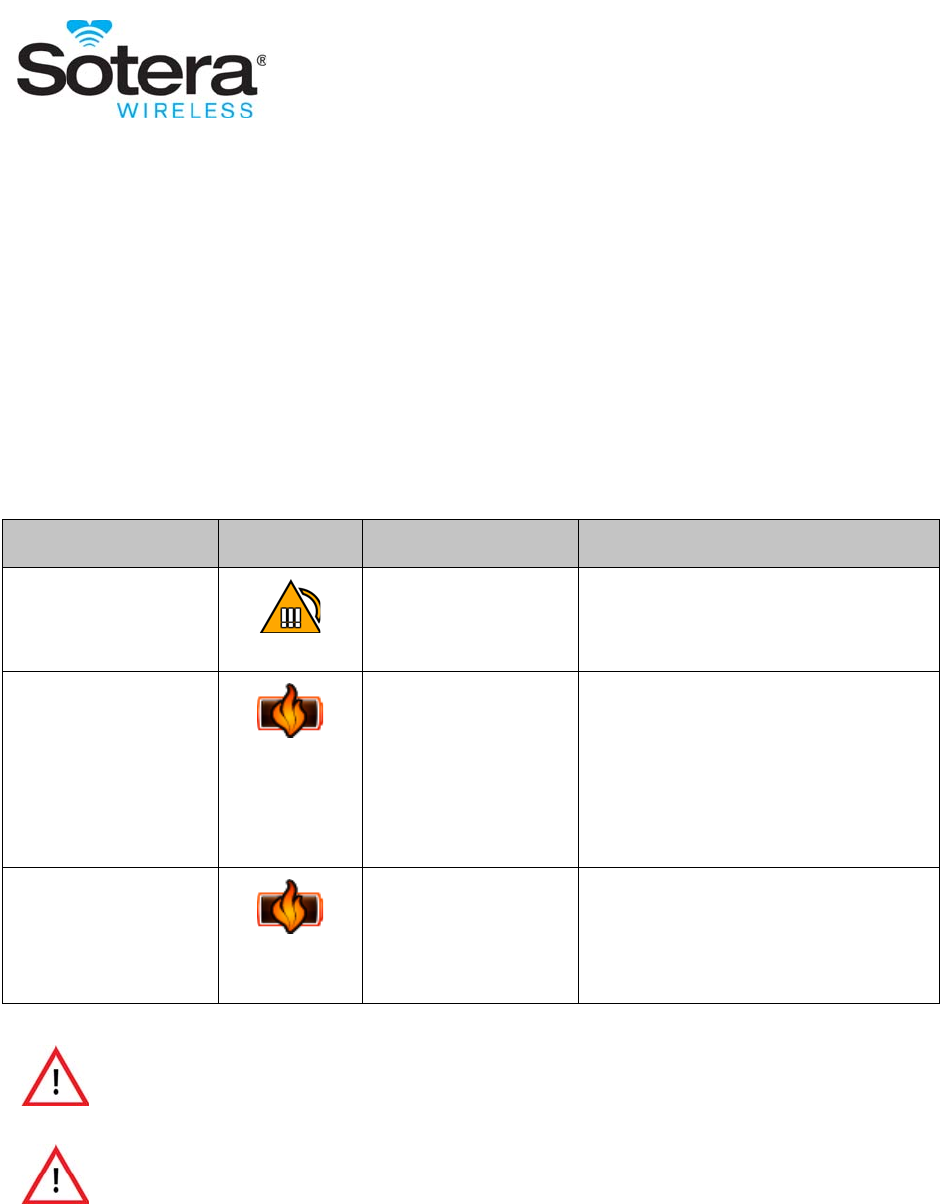
143
Appendix A - Alarm Summary
Patient Alarms
Life Threatening Alarms
Note: When the Cuff Module is in the Charger, the LED on the front of the Cuff Module will
display red.
Display Message Symbol(s) Alarm Summary Cause
CRITICAL LOW HR Critical Low Heart Rate Patient’s heart rate is less than 18 BPM.
Note: The patient’s posture will
toggle white/red.
MONITOR TOO HOT Monitor - Battery Over-
Temperature Failure
• Battery in the Monitor has exceeded
a safe temperature.
• The Chest Module has exceeded a
safe temperature.
Return the Monitor and the Chest
Sensor to Sotera Wireless.
CUFF BATTERY
TEMP
Cuff Module - Battery
Over-Temperature
Failure
Battery in the Cuff Module has exceeded
a safe temperature.
Return the Cuff Module to Sotera
Wireless.
When the “Monitor Too Hot” alarm is in progress, ViSi Mobile Monitoring
System should be removed from the patient immediately. Leaving on the
patient for an extended period of time may lead to a skin burn.
When the “Cuff Battery Temp” alarm is in progress, ViSi Mobile Cuff Module
should be removed from the patient immediately. Leaving on the patient for
an extended period of time may lead to a skin burn.

Patient Alarms
144
High Alarms
Display Message Alarm Summary Cause
THUMB NO PULSE SpO2 Module - No Pulse
Detected
Unable to detect a pulse from the Thumb Sensor.
Thumb Sensor is the primary source of PR.
CUFF NO PULSE Cuff Module - No Pulse
Detected
Chest Sensor Cable and Thumb Sensor are not
connected. Cuff Module is the only source of PR.
Unable to detect a pulse from the cuff inflation.
HIGH PULSE RATE High Pulse Rate Pulse rate exceeds the defined upper alarm limit.
LOW PULSE RATE Low Pulse Rate Pulse rate is less than the defined lower alarm limit
HIGH HEART RATE High Heart Rate Heart rate exceeds the defined upper alarm limit.
LOW HEART RATE Low Heart Rate Heart rate is less than the defined lower alarm
limit.
HIGH BP SYSTOLIC BP - High Systolic Systolic pressure exceeds the defined upper alarm
limit.
LOW BP SYSTOLIC BP - Low Systolic Systolic pressure is less than the defined lower
alarm limit.
HIGH BP DIASTOLIC BP - High Diastolic Diastolic pressure exceeds the defined upper alarm
limit.
LOW BP DIASTOLIC BP - Low Diastolic Diastolic pressure is less than the defined lower
alarm limit.
HIGH BP MAP BP - High MAP MAP pressure exceeds the defined upper alarm
limit.
LOW BP MAP BP - Low MAP MAP pressure exceeds the defined lower alarm
limit.
HIGH RESP High Respiration Respiration exceeds the defined upper alarm limit.
LOW RESP Low Respiration Respiration is less than the defined lower alarm
limit.
LOW SpO2Low SpO2SpO2 is less than the defined lower alarm limit.
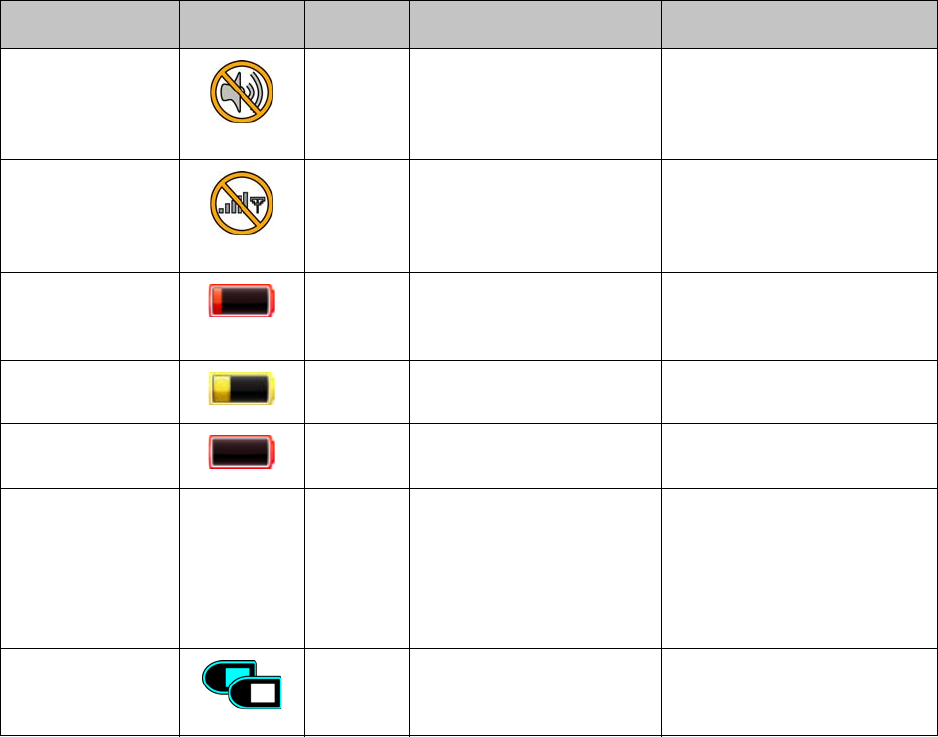
Equipment Alerts
145
Equipment Alerts
ViSi Mobile Monitor Alerts
Display Message Symbol(s) Severity Cause Solution
AUDIO FAILURE Low Either the microphone or
the speaker on the Monitor
has failed.
Stop monitoring and replace
the Monitor.
Return the Monitor to Sotera
Wireless, Inc.
WIRELESS
RADIO
Low The wireless radio in the
Monitor is not transmitting.
Stop monitoring and replace
the Monitor.
Return the Monitor to Sotera
Wireless, Inc.
MONITOR
BATTERY
CRITICAL
Low Monitor battery charge is
critically low.
Replace the Monitor.
MONITOR
BATTERY LOW
Low Monitor battery charge is
low.
Prepare to replace the Monitor.
UNABLE TO
MONITOR
Low Battery in the Monitor is too
low to continue monitoring.
Replace the Monitor.
CONNECT TO
PATIENT
N/A Low A sensor has been
connected to the Monitor
but not yet applied to the
patient. No vital sign
measurement has been
detected.
Apply the sensor to the patient.
ACCEL
MONITOR
Low Unexpected error occurred
with the accelerometer in
the Monitor.
Replace the Monitor and return
it to Sotera Wireless, Inc.
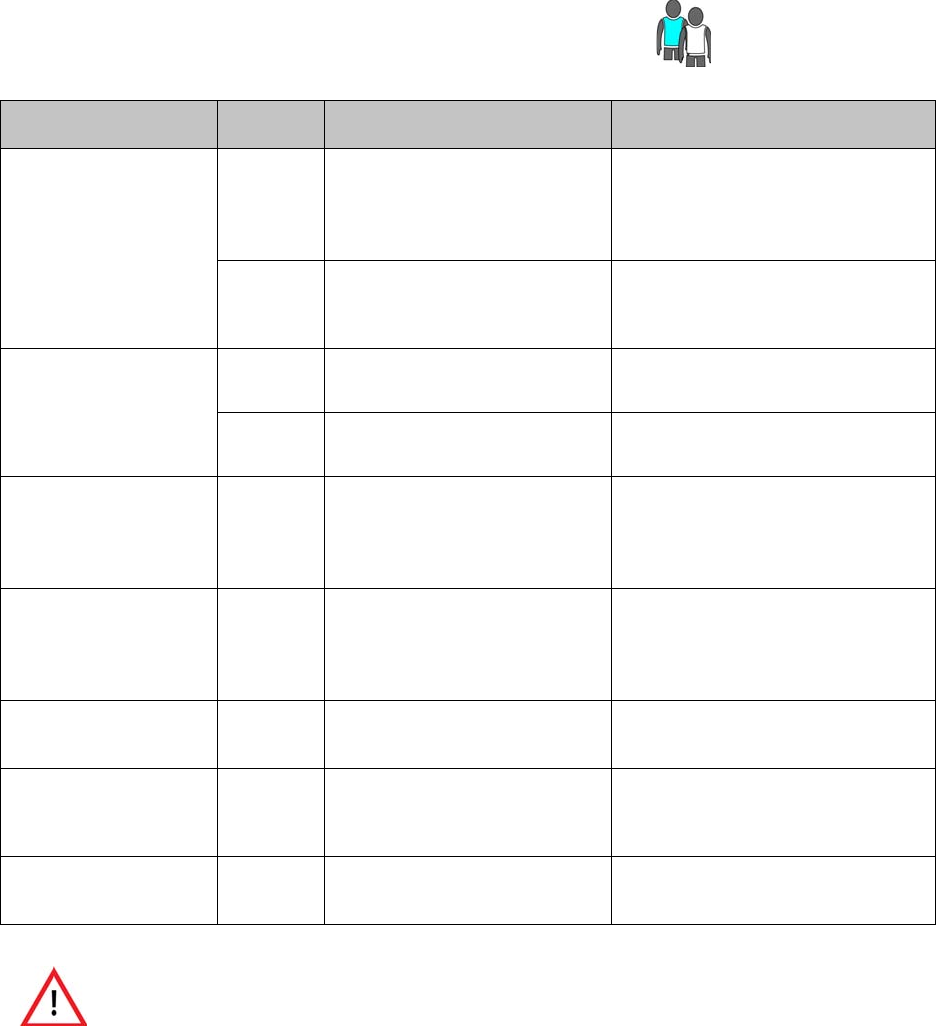
Equipment Alerts
146
ViSi Mobile Chest Sensor Cable and ECG Alerts
Display Message Severity Cause Solution
CHEST SENSOR Low The Chest Sensor Cable is
disconnected from the Monitor
and not yet acknowledged by the
clinician.
Acknowledge the alert and remove
the Chest Sensor Cable from the
patient, or reconnect the Chest
Sensor Cable to the Monitor.
Low More than one Chest Sensor
Cable is simultaneously
connected to the Monitor.
Remove the extra Chest Sensor
Cable(s) from the Monitor.
CHEST FAULT Low Various failure modes related to
the Chest Sensor Cable.
Replace the Chest Sensor Cable and
return it to Sotera Wireless, Inc.
Low The Chest Sensor Cable does not
contain the correct software.
Replace the Chest Sensor Cable and
return it to your biomedical engineer.
ECG LEAD
(+ lead label)
Low One or more lead-wires have
failed.
Reconnect the ECG electrode, if
necessary.
Replace the ECG electrode, if
necessary.
ECG LEADS Low All ECG lead-wires have failed. Reconnect the lead-wires to the ECG
electrodes.
Replace the ECG electrodes if
necessary.
TEMPERATURE
FAULT
Low Unexpected error occurred with
the Temperature Sensor.
Replace the Chest Sensor Cable and
return it to Sotera Wireless, Inc.
ACCEL. CHEST Low Unexpected error occurred with
the accelerometer in the Chest
Sensor Cable.
Replace the Chest Sensor Cable and
return it to Sotera Wireless, Inc.
ACCEL. UPPER
ARM
Low Unexpected error occurred with
the Upper Arm accelerometer.
Replace the Chest Sensor Cable and
return it to Sotera Wireless, Inc.
Use all of the same type of high quality ECG electrodes on the patient.
Mixing ECG electrode types can adversely affect ECG monitoring.
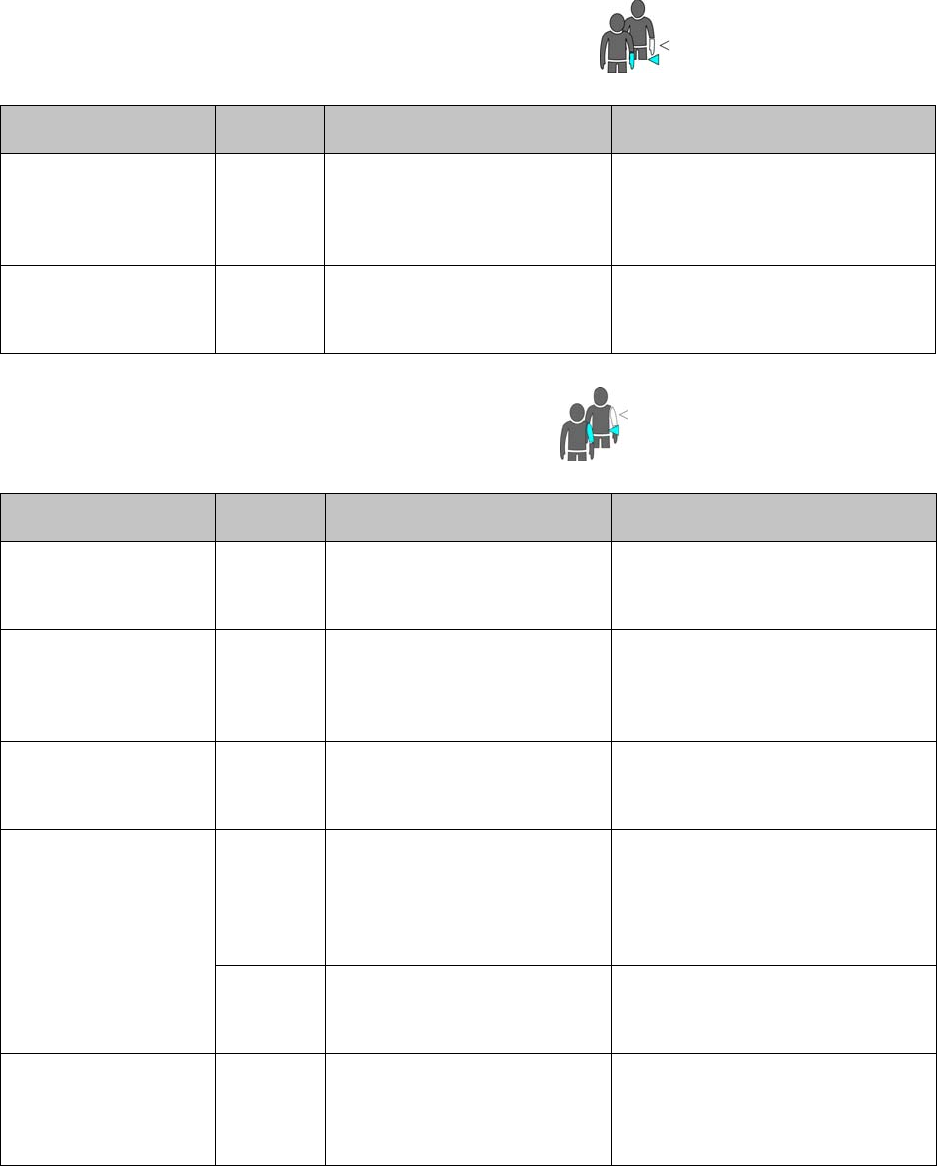
Equipment Alerts
147
ViSi Mobile Thumb Sensor and SpO2 Alerts
ViSi Mobile Cuff Module and NIBP Alerts
Display Message Severity Cause Solution
THUMB SENSOR Low The Thumb Sensor has been
disconnected from the Monitor
and has not yet been
acknowledged by the clinician.
Acknowledge the alert, or reconnect
the Thumb Sensor to the Monitor.
THUMB SENSOR
OFF
Low The optical signal has been lost. Reposition the Thumb Sensor at the
base of the patient’s thumb. Replace
the Thumb Sensor.
Display Message Severity Cause Solution
CHECK CUFF Low An issue has been found with
the cuff during inflation
Check the connection between the
Cuff and the Cuff Module.
Check the Cuff for damage.
CUFF OCCLUDED Low Something is blocking the air
from being pumped into the
Cuff.
Check for a kinked hose. Check to
make sure that the connection
between the Cuff and the Cuff
Module is not blocked.
NIBP
UNOBTAINABLE
Low NIBP measurement is
unobtainable.
Make sure that the Cuff is positioned
on the arm correctly, and wrapped
snugly around the arm.
CUFF MODULE Low The Cuff Module is
disconnected from the Monitor
and the alert is not yet
acknowledged by the clinician.
Acknowledge the alert and either
reconnect the Cuff Module to the
Monitor or remove the Cuff Module
from the Cuff and remove the Cuff
from the patient.
Low More that one Cuff Module is
simultaneously connected to the
Monitor.
Remove the extra Cuff Module(s)
from the Monitor.
CUFF MODULE
300 mmHg
High A pressure of 300mmHg was
reached when inflating the Cuff.
Check the patient. Make sure that the
Cuff is positioned on the arm
correctly, and wrapped snugly around
the arm.

Equipment Alerts
148
CALIBRATION
FAILED
Low An attempt to calibrate cNIBP
has failed.
• Make sure the cuff is
positioned on the arm
correctly and wrapped snugly
around the arm.
• Ensure the patient remains
still during the calibration
process.
CALIBRATE cNIBP Low A recalibration event has
occurred.
Calibrate cNIBP.
NIBP FAULT Low Cuff accuracy “zero pressure”
test failed.
Return the Cuff Module to your
biomedical engineer. Replace with
another Cuff Module.
Low The Cuff Module does not
contain the correct software.
Replace the Cuff Module and return
it to your biomedical engineer.
Low This can indicate various failure
modes related to the Cuff
Module.
Replace the Cuff Module and return
it to Sotera Wireless, Inc.
NIBP LOW BATTERY Low Battery in the Cuff Module is
low.
Replace the Cuff Module with one
that has a full battery charge.
NIBP EMPTY
BATTERY
Low Battery in the Cuff Module is
empty. No measurements are
possible.
Replace the Cuff Module with one
that has a full battery charge.
Display Message Severity Cause Solution
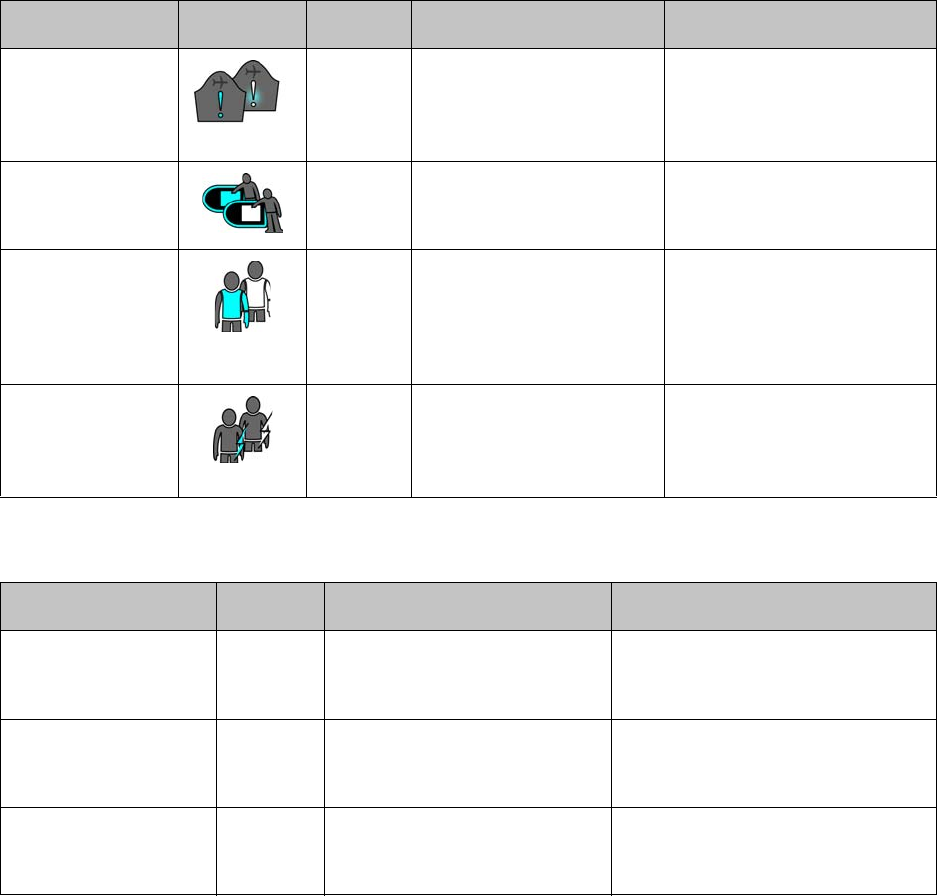
Equipment Alerts
149
Miscellaneous Alerts
ViSi Mobile Charging Alerts
Display Message Symbol(s) Severity Cause Solution
INVALID PLUG High During monitoring the Bio
Med or Shipping Plug has
been connected to the
rounded end of the Monitor.
Remove the invalid Plug.
PATIENT
TAMPERING
Low Someone has unsuccessfully
attempted to log into the
Monitor.
Enter the correct PIN and
check settings to confirm
nothing has changed.
SENSORS
DISCONNECT
Low All sensor connections to
the Monitor have been
removed without going
through the Stop Monitoring
process.
Either reconnect the sensor(s)
to the Monitor or stop
monitoring using the Stop
Monitoring process.
SHOCK
HAZARD
High Cuff Module has been
placed in the Charger while
still connected to the
Monitor.
Remove the Cuff Module from
the Charger or disconnect the
Cuff Module from the
Monitor.
Display Message Severity Cause Solution
CHARGE CURRENT
FAULT
High Monitor charging over current
protection error.
Remove the Monitor from the
Charger and contact Sotera Wireless,
Inc. Customer Service.
CHARGE TEMP
FAULT
High Monitor charging over
temperature protection level.
Remove the Monitor from the
Charger and contact Sotera Wireless,
Inc. Customer Service.
CHARGE VOLTAGE
FAULT
High Voltage level has exceeded the
limit when the Monitor is in the
Charger.
Remove the Monitor from the
Charger and contact Sotera Wireless,
Inc. Customer Service.
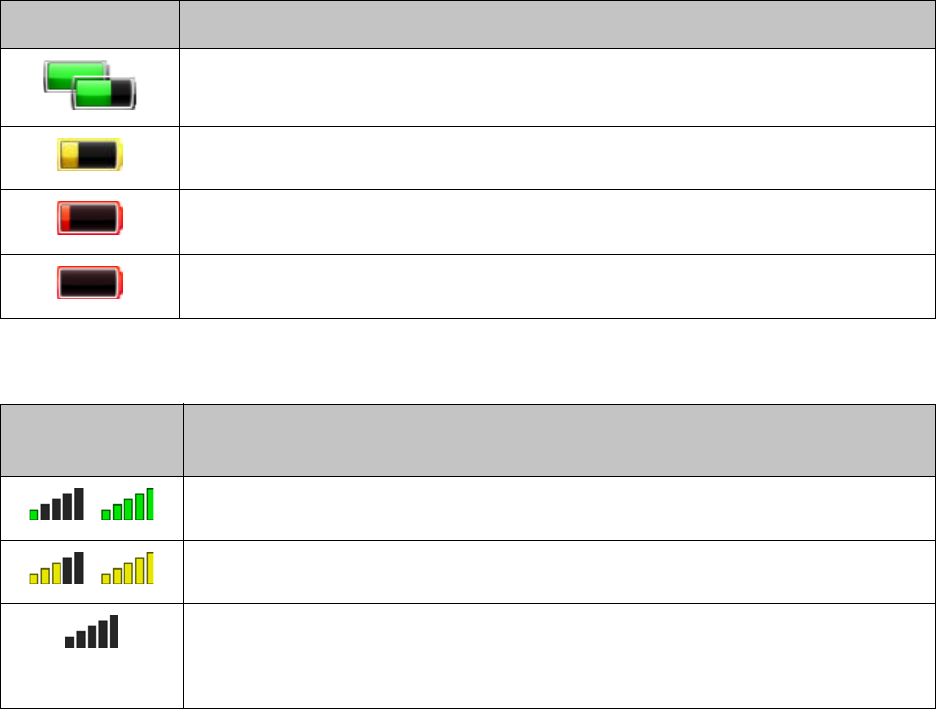
ViSi Mobile Monitor Status Icons
150
ViSi Mobile Monitor Status Icons
Battery Charge
Wireless Radio Signal Strength
Battery Icon Status
The battery status in the ViSi Monitor is good.
Note: The fill level will diminish as the battery level goes down.
The battery in the ViSi Monitor is low.
There is less than 3 hours of monitoring available.
The battery in the ViSi Monitor is critically low.
There is less than 1 hour of monitoring available.
The battery in the ViSi Monitor is too low to continue monitoring.
There is less than 10 minutes of battery charge left.
Signal Strength
Icon Status
Connectivity between the ViSi Monitor to the Appliance is good. The number of green
bars indicate the signal strength.
The ViSi Mobile Monitor recognizes the network but is unable to connect to the Appliance.
The number of yellow bars indicates the signal strength.
Connectivity between the ViSi Mobile Monitor and the Appliance has been lost.
Note: This connectivity lost icon is only displayed on the ViSi Mobile Remote
Viewer.
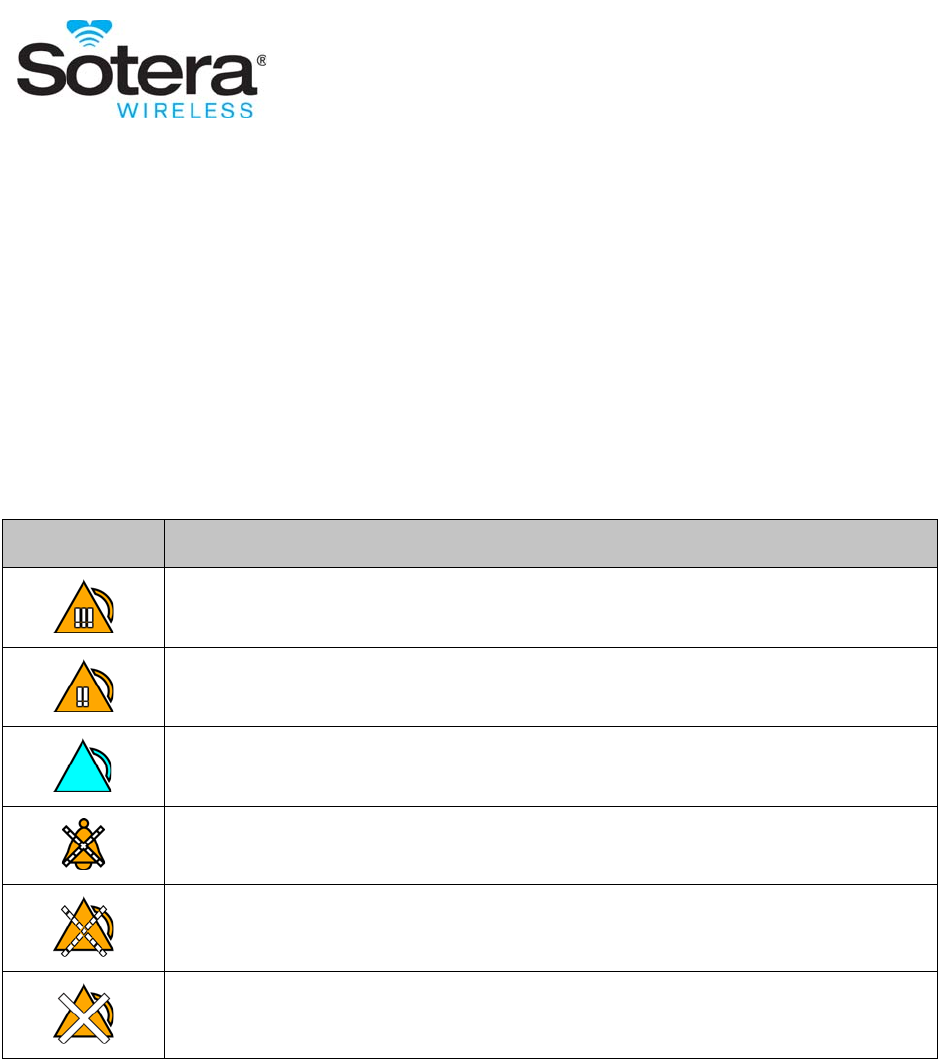
151
Appendix B - Symbols
Alarms / Alerts
Alarm / Alert States
Symbol Description
Unacknowledged life threatening severity alarm in progress.
Unacknowledged high severity alarm in progress
Unacknowledged alert in progress (any severity).
All alarms in progress have been acknowledged by the clinician.
Alarm annunciation (visual and audio) has been paused for 2 minutes.
Alarm annunciation (visual and audio) has been turned off.
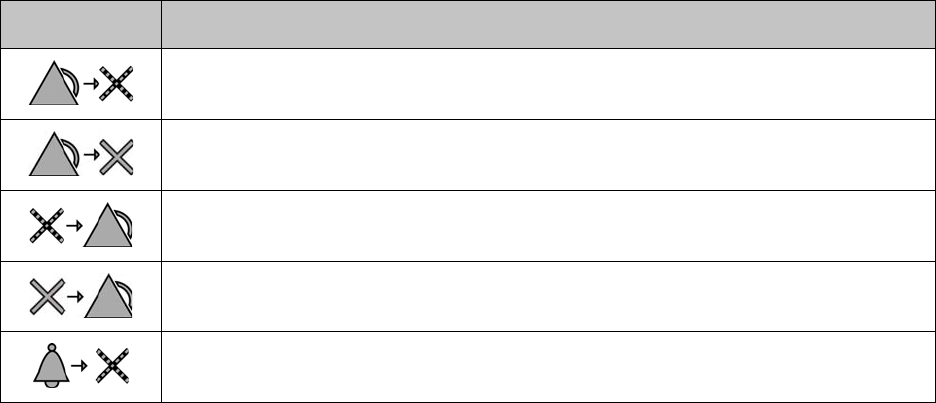
Alarms / Alerts
152
Alarm Management
Symbol Description
Pause alarm annunciation (visual and audible) for 2 minutes.
Turn off alarm annunciation (visual and audible).
Resume alarm annunciation from a paused state.
Turn alarm annunciation back on.
Acknowledge an alarm/alert that is in progress.

Battery States
153
Battery States
Symbol Description
Battery good: the Monitor’s battery is fully charged.
Battery Low: the Monitor’s battery voltage is low.
Battery Critically Low: the Monitor’s battery voltage is critically low.
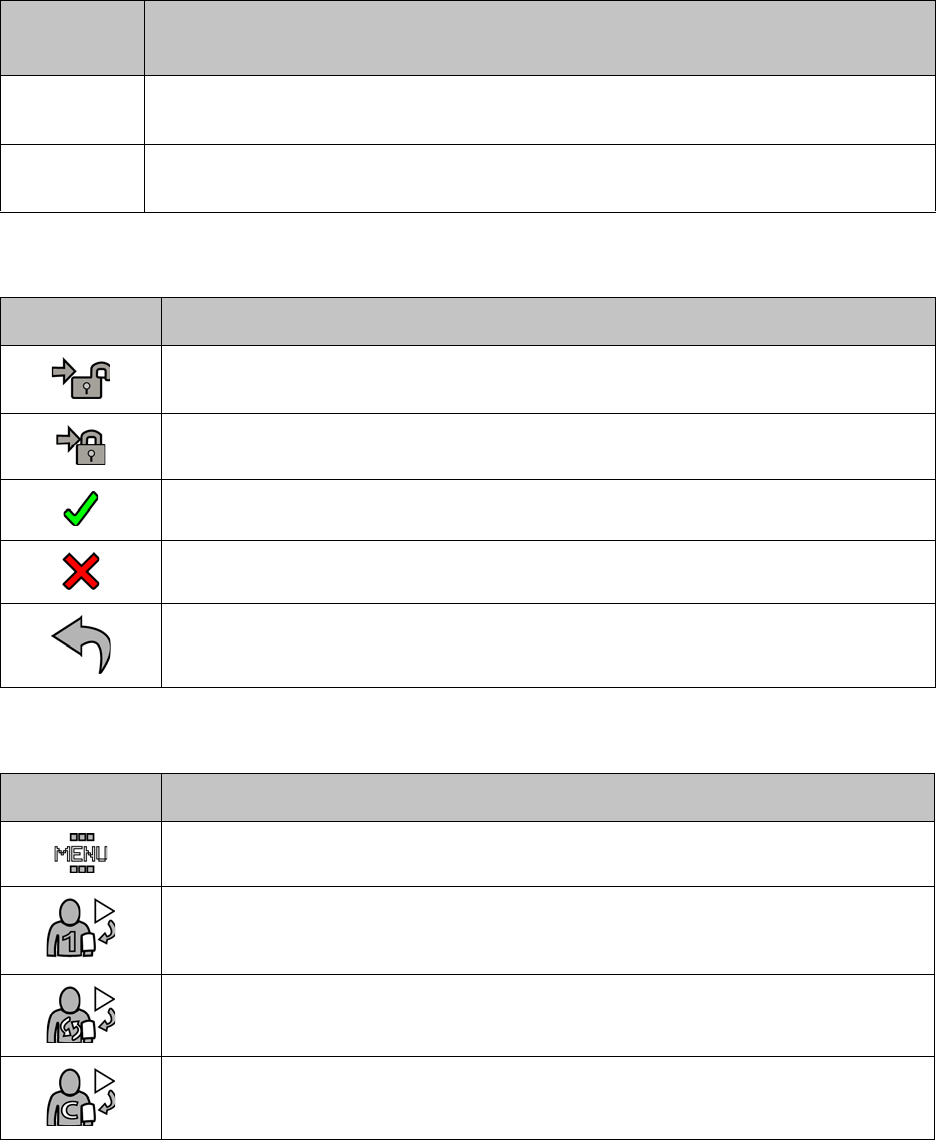
General Icons
154
General Icons
Out of Range Vital Signs
Navigation
Vital Signs Menu
Symbol Description
+++ Vital sign measurement is above the upper display range.
--- Vital sign measurement is below the lower display range.
Unlock the ViSi Mobile Monitor to gain access to the clinical features.
Lock the ViSi Mobile Monitor to prevent unwanted access to the clinical features.
Confirm activity.
Cancel activity.
Return to the previous screen.
Symbol Description
Access to the clinical menu.
Start a manual cuff inflation. Cuff inflations are set up to be taken on an ad hoc basis.
Start a manual cuff inflation. Cuff inflations are set up to be taken automatically at a selected
time interval.
Start a manual cuff inflation. Blood pressure measurements are set up to be continuous after
the initial calibration.
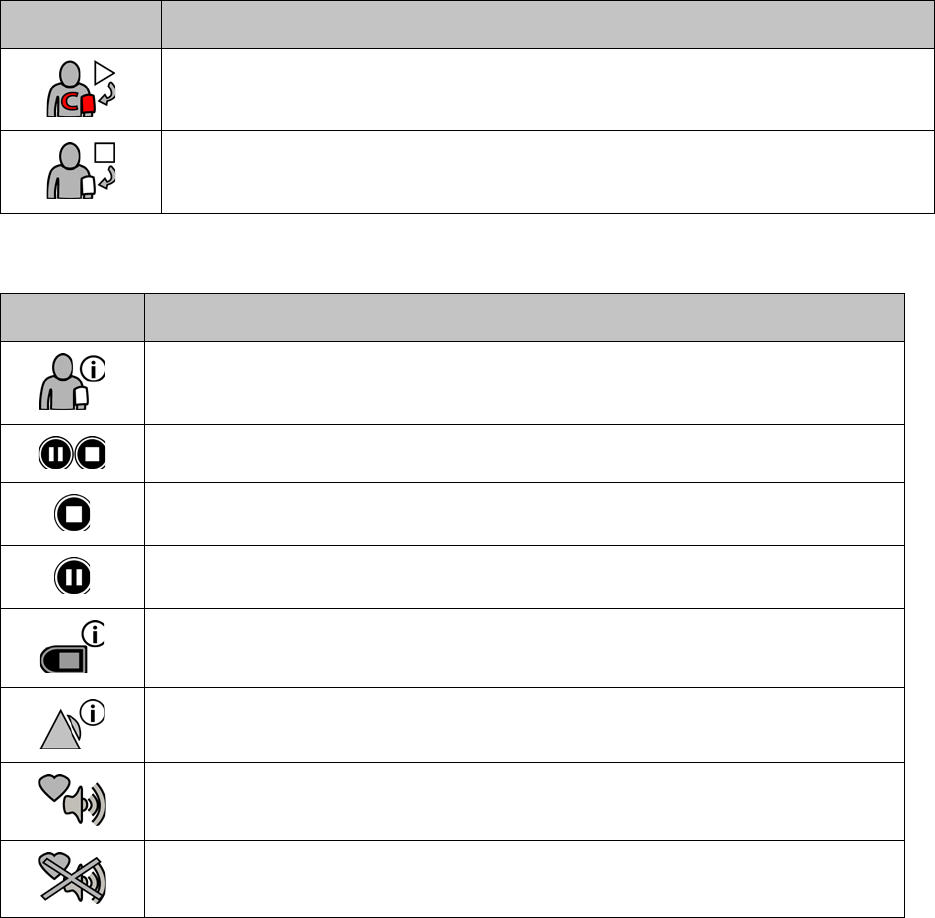
General Icons
155
Clinical Menu
Calibrate NIBP for continuous measurements.
Stop a cuff inflation currently in progress.
Symbol Description
BP management. Setup the cuff inflation intervals or define as ad-hoc only inflations.
Initiate the pause/stop monitoring sequence.
Initiate the stop monitoring sequence.
Initiate the pause monitoring sequence.
Access information regarding the ViSi Mobile Monitor: Monitor ID, MAC address, Serial
#, software version installed and battery status.
Alarm management. Review the patient’s current alarm limits, adjust the alarm limits using
“Auto Set” or turn off the alarm annunciation.
QRS beep is turned on.
QRS beep is turned off.
Symbol Description
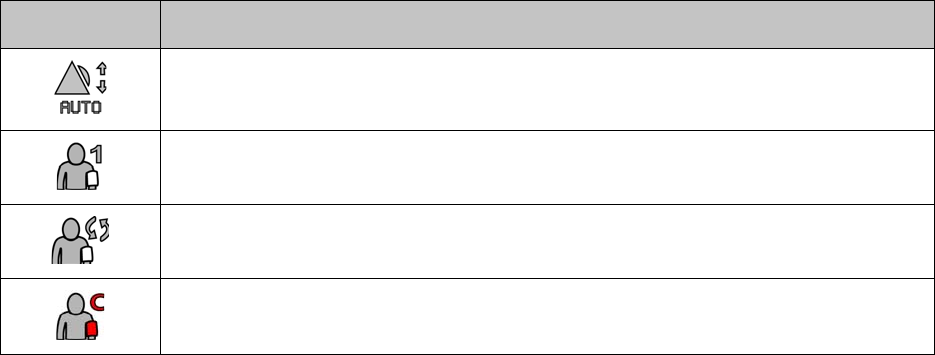
General Icons
156
Other
Symbol Description
Change a patient’s alarm limits using “Auto Set”.
Setup cuff inflation to be on an ad hoc basis.
Setup cuff inflation such that the cuff will inflate at defined intervals.
Setup cuff inflation such that NIBP measurements will be taken on a continuous basis.
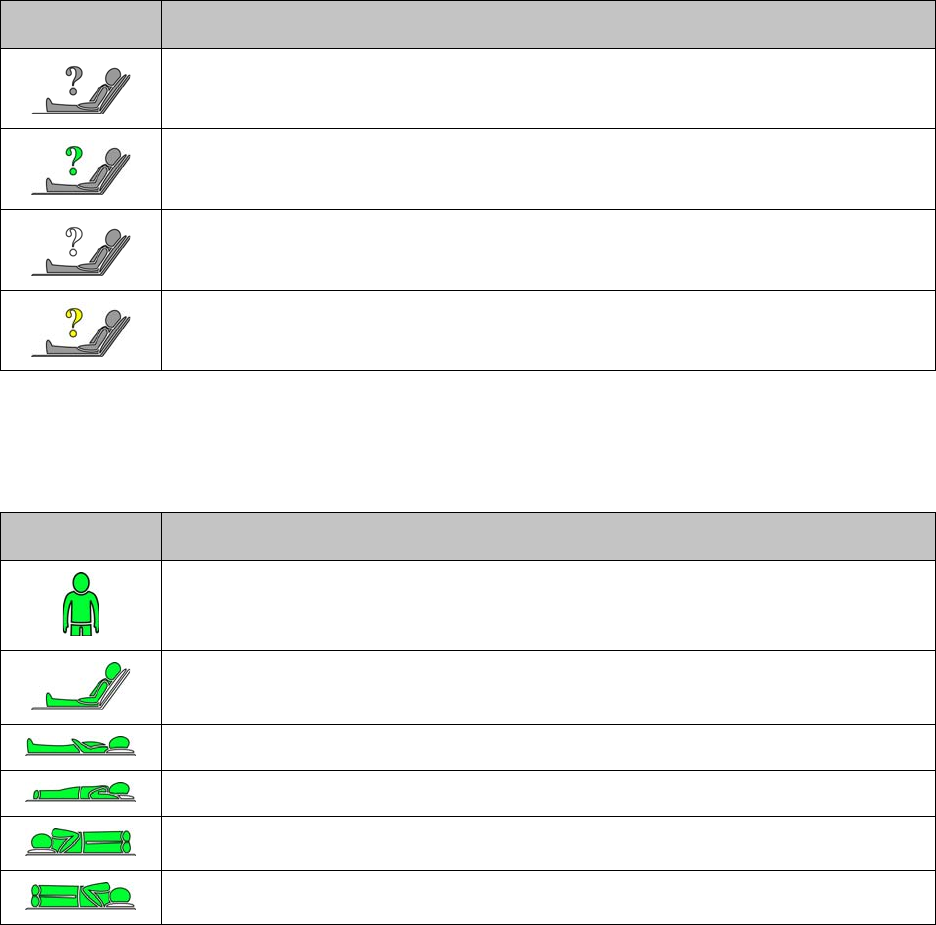
Patient’s Postures
157
Patient’s Postures
Unknown Posture
Postures
Note: In the event of an alarm, the patient’s posture will be displayed in the color associated with
the alarm severity.
Symbol Description
Patient is currently out of the network.a
a. The ViSi Mobile Monitor always displays the question mark in gray irrespective of the alarm status.
Patient’s posture has not been selected and confirmed on the ViSi Mobile Monitor. There are
no alarm conditions in progress.
Patient’s posture has not been selected and confirmed on the ViSi Mobile Monitor. A life-
threatening alarm condition is in progress.b
b. In the event of a life-threatening alarm, the question mark above the patient symbol will toggle white/red.
Patient’s posture has not been selected and confirmed on the ViSi Mobile Monitor. When the
question mark is static red, a high alarm condition is in progress.
Symbol Description
Patient’s torso is in an upright position.
Patient’s torso is at a reclined position.
Patient is lying in a supine position.
Patient is lying on their front.
Patient is lying on their right side.
Patient is lying on their left side.
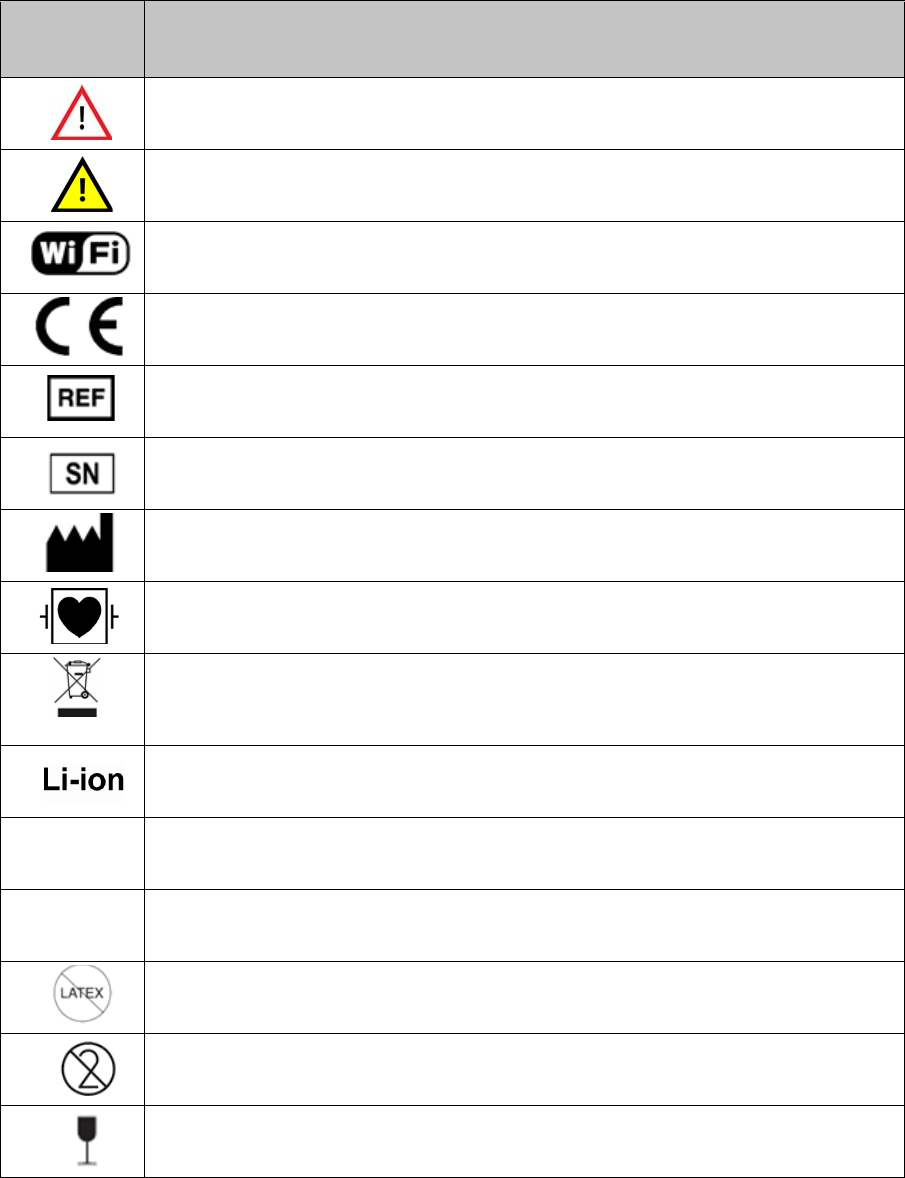
Labelling
158
Labelling
Symbol Description
Warning, refer to accompanying documents
Caution, refer to accompanying documents
WiFi Alliance certification
Conforms with EEC directives
Catalog number
Serial Number
Manufactured By
Defibrillator proof type CF equipment
This product is designated for separate collection at an appropriate collection point. Do not
dispose of as household waste.
Lithium Ion battery
IPX0 No special protection.
IPX7 Protected against water immersion. Immersion for 30 minutes at a depth of 1 meter.
Latex free
Do not reuse
Fragile

Labelling
159
Contents
MRI Unsafe
Symbol Description
CONT
Labelling
160
- Notes -
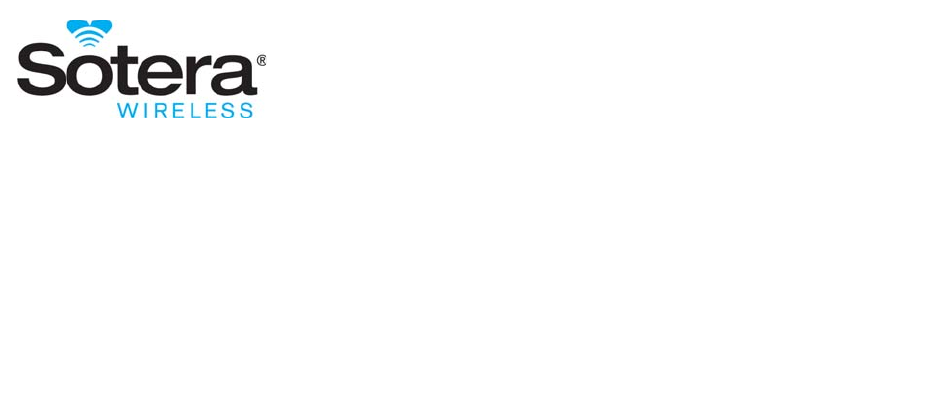
161
Appendix C - Warranty
Warranty
Sotera warrants to End User, for a period of one (1) year from the date of delivery, unless otherwise noted
in specific documentation, that the products sold by Sotera will operate in accordance with Sotera’s
published documentation in effect on the date of delivery or Sotera will, at its sole discretion and expense,
repair or replace the products. Replacements will be warranted for the remainder of the warranty period in
effect on the original product purchased, unless otherwise mandated by applicable law. Products include
Sotera equipment only but does not include disposables / consumables. Sotera warrants that its
disposables / consumables products will be free from defects in workmanship and materials for a period of
one (1) year from the date of purchase or the expiration date whichever occurs first.
Third Party Branded Products
Sotera will not be deemed to provide, nor be responsible for, warranty, related remedy or support with
respect to hardware, software or services purchased from a third party unless such party is a Sotera
authorized partner services Sotera Products and Services, unless otherwise agreed in writing between the
parties.
Typically, in case of a defective 3rd party item under warranty, Sotera will make arrangements with the 3rd
party manufacturer to issue a replacement. The replacement will be sent directly to the End User site from
the 3rd party manufacturer. No Return Material Authorization (RMA) will be issued by Sotera, instead a
Sotera Case Number will be issued for the reported issue. The End User is responsible for complying with
the manufacturer’s replacement procedures.
Warranty Exclusions
Sotera will not be liable under this warranty if its testing and/or examination discloses that the alleged
defect in the Sotera equipment does not exist or was caused by end user’s or any unauthorized third
person’s misuse, neglect, improper installation or testing, attempts to repair, or any other cause beyond the
scope of the intended use, or by accident, fire, lightning or other hazard or event of force majeure. The
warranty for any hardware will become void if a hardware component is installed as an add-on and or
replacement part on the original hardware and such component part has not been approved for such
inclusion by Sotera. The warranty for software will voided if the software is modified, except as authorized
in writing by Sotera.
Sotera Wireless Responsibility
162
In no event shall Sotera be liable to end user or any third parties for any consequential, incidental, indirect,
exemplary, punitive, contingent, statutory or any other special damages. Sotera’s liability for damages on
account of a claimed defect in any product delivered by Sotera shall in no event exceed the purchase price
of the product on which the claim is based. Specifically, and without limiting the generality of the
foregoing, Sotera shall not be responsible or liable to end user or any third party for any lost profits, or any
consequential, incidental, punitive, contingent, statutory or any other special damages for any breach of
warranty or other breach of Sotera’s obligations under this agreement. Sotera shall not be liable for
damages relating to any instrument, equipment, or apparatus with which the product sold under this
agreement is used. In addition, Sotera disclaims all liability of any kind of Sotera’s suppliers.
The foregoing warranties and remedies are exclusive and are in lieu of all other warranties, express or
implied, either in fact or by operation of law, statutory or otherwise including warranties of merchantability
and fitness for a particular purpose or non infringement.
Sotera does not assume or authorize any other person to assume for it any other or greater liability in
connection with the sale, installation, servicing, maintenance or use of Sotera hardware, and Sotera makes
no warranty whatsoever with respect to any third-party branded products supplied by it hereunder.
Sotera Wireless Responsibility
Sotera Wireless Inc. is responsible for the effects on safety, reliability and performance of the equipment
only if:
1. Assembly operations, extensions, readjustments, modifications or repairs are carried out by
persons authorized by Sotera Wireless Inc. and
2. The equipment is used in accordance with the instructions for use.
Contact Sotera Wireless
Toll-Free: +1-866-232-6126
International: +1-858-427-4620
Fax: +1-858-427-4639
E-mail: support@soterawireless.com
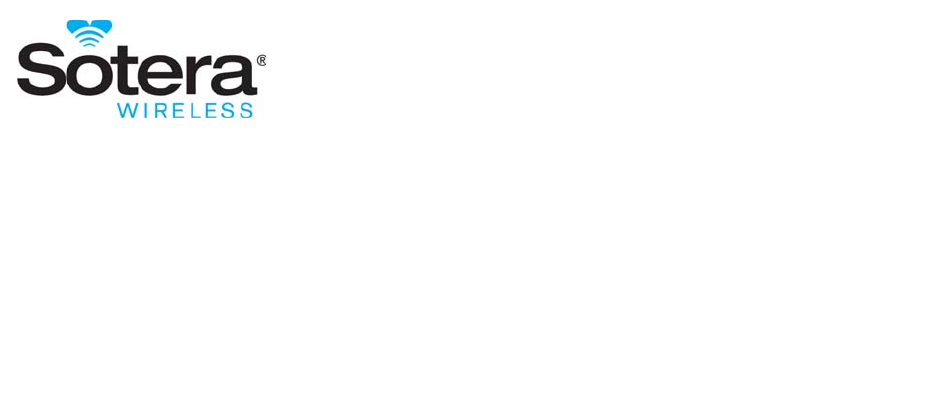
163
Index
A
ADT Interface 50
Search Patients Within ADT 51
Select Patients from ADT 50
Alarm Limts 81
Change Alarm Limits Individually 81
Reset to Default Values 83
Alarm Summary 143
Alarms 69
In Network Rules 70
Managing Annunciations 72
Physiological Alarms
High 75
Life Threatening 73
Resume Alarm Annunciation 79
System Alarm Management 69
Test Remote Viewer Speaker 84
Turn Alarms On 80
Alerts
Charging 149
Chest Sensor Cable 146
Cuff Module 147
ECG 146
Miscellaneous 149
Monitor 145
SpO2 147
Thumb Sensor 147
C
Care Unit Views 91
Devices (Assigned To Patients) 91
Cautions 20
Contraindications 10
Copyright 2
Current Waveforms 65
ECG Waveforms 65
164
Input Overload/Dynamic Range 66
Customer Support 93, 162
E
Edit Patient Demographics 45
Equipement/Technical Alerts 77
G
Graphical Trends 56
Alarms/Events Status Bar 60
All Vital Sign Trends 57
Patient Alarms 60
Single Vital Sign Trend 58
Time Cursor 59
I
Intended Use 10
L
List Trends 62, 65
Navigation/Scrolling 64
Trend Displays 64
N
Navigation 33
Current Waveforms 65
Graphical Trends 57
List Trends 63
Patient Home 33, 34
Remove Patient 88
NIBP 147
P
Patient Locations 47
Drag and Drop 47
Manual Data Entry 48
Patient Reports 67
List Trends 67
Waveforms 68
Patient Tiles 29
Assigned Location Zone 29
Unassigned Location Zone 30
Work Area 31
Patient Views
Admit New Patient 41
ADT Patient Search 51
Edit Patient Demographics/Assign a Location 45, 48
Graphical Trends
Multiple Trends 57
Single Trend 58
165
List Trends 63
Patient Demographics (Source ADT) 50
Patient Home 28
Remove Patient 88
Pause Monitoring 85
Physiological Alarms
High 144
Life Threatening 143
Pre-Admit New Patient 41
R
Remote Viewer Audio Test 84
Remote Viewer Display 26
Care Unit Area 26
Assigned/Pre-Defined Locations Zone 26
Unassigned Patients Zone 26
Work Area 27
Removing Patients (from Care Unit) 88
S
Shutdown Application 36
Specifications 105
Physical Components 118
2-Bay Charger 123
8-Bay Charger 123
Appliance 124
Chest Sensor Cable 120
Cuff Module 121
Customer Network 126
Mode Plugs 119
Monitor 118
Remote Viewer 125
Thumb Sensor 122
Wireless Communication/Radio 118
Vital Signs
Continuous Non-Invasive Blood Pressure 114
Heart Rate 106
Non-Invasive Blood Pressure 112
Pulse Oximetry 110
Respiration 109
Skin Termperature 117
Start Monitoring Before Admit 43
Stop Monitoring 87
Symbols 151
Alarms/Alerts 151
Battery States 153
Battery Status 150
166
Generic Icons 154
Labelling 154
Wireless Radio Signal Strength 150
System Help 35
System Overview 25
T
Time Scale Displays 59
Trend Lines 59
Troubleshooting 93
Alarms and Alerts 102
Battery Charger 101
Chest Sensor Cable 95
Connectivity Lost 102
Cuff Module 99
Monitor 94
Setting Alarm Limits (Remote Viewer) 104
Thumb Sensor 98
V
Vital Sign Measurements 53
Vital Signs Measurments
Care Unit Area 53
W
Warnings 12
Warranty 161
Exclusions 161
Third Party Products 161
Wireless Monitoring 37
Communication with the Remote Viewer 38
Out of Network Range 39